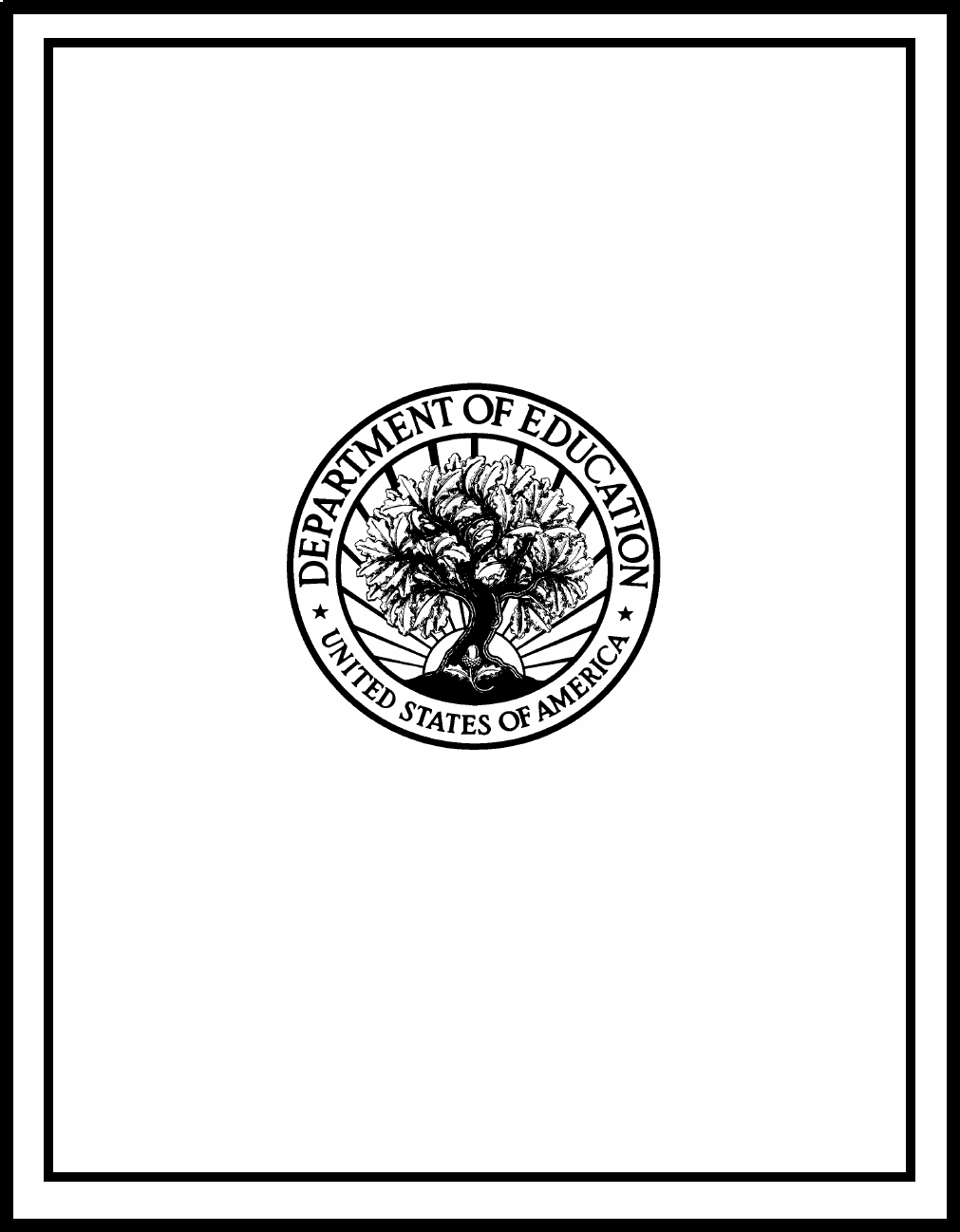
U.S. DEPARTMENT OF EDUCATION
Fiscal Year 2025
Budget Summary
1
U.S.
DEPARTMENT OF EDUCATION
F
ISCAL YEAR 2025 BUDGET SUMMARY
TABLE OF CONTENTS
I. SUMMARY
OF THE 2025 BUDGET REQUEST ................................................................................ 6
K-12 Education .............................................................................................................................. 7
An Education Beyond High School .............................................................................................. 10
II. T
HE 2025 EDUCATION BUDGET BY PROGRAM AREA .......................................................................... 12
Elementary and Secondary Education ......................................................................................... 12
Overview .............................................................................................................................. 12
Title I Grants to Local Educational Agencies ...................................................................... 14
Academic Acceleration and Achievement Grants ............................................................... 14
Preschool Incentive Demonstration Program ...................................................................... 15
Full-Service Community Schools (FSCS) ........................................................................... 15
21st Century Community Learning Centers ........................................................................ 16
Supporting Effective Instruction State Grants ..................................................................... 16
Teacher and School Leader Incentive Grants ...................................................................... 16
Supporting Effective Educator Development (SEED) ........................................................ 17
School Safety National Activities ........................................................................................ 17
Student Support and Academic Enrichment Grants ............................................................ 18
English Language Acquisition ............................................................................................. 18
Promise Neighborhoods ....................................................................................................... 18
Fostering Diverse Schools ................................................................................................... 19
Magnet Schools Assistance ................................................................................................. 19
2
Training and Advisory Services .......................................................................................... 19
Charter Schools Grants ........................................................................................................ 20
Migrant Education ............................................................................................................... 20
Neglected, Delinquent, and At-Risk Students ..................................................................... 21
Education for Homeless Children and Youths ..................................................................... 21
Rural Education ................................................................................................................... 21
Indian Education .................................................................................................................. 22
Native Hawaiian Education ................................................................................................. 23
Alaska Native Education ..................................................................................................... 23
State Assessments ................................................................................................................ 23
Education Innovation and Research .................................................................................... 24
Comprehensive Literacy Development Grants .................................................................... 24
Innovative Approaches to Literacy ...................................................................................... 24
American History and Civics Education.............................................................................. 25
Arts in Education ................................................................................................................. 25
Javits Gifted and Talented Education .................................................................................. 25
Ready to Learn Programming (RTL) ................................................................................... 26
Statewide Family Engagement Centers ............................................................................... 26
Comprehensive Centers ....................................................................................................... 26
Impact Aid ........................................................................................................................... 27
Supplemental Education Grants ........................................................................................... 28
Special Education and Rehabilitation Services ........................................................................... 28
Overview .............................................................................................................................. 28
Grants to States .................................................................................................................... 29
Preschool Grants .................................................................................................................. 29
Grants for Infants and Families ........................................................................................... 30
3
State Personnel Development .............................................................................................. 30
Technical Assistance and Dissemination ............................................................................. 31
Personnel Preparation .......................................................................................................... 31
Parent Information Centers .................................................................................................. 32
Educational Technology, Media, and Materials .................................................................. 32
Special Olympics Education Program ................................................................................. 32
Vocational Rehabilitation State Grants ................................................................................ 33
Client Assistance State Grants ............................................................................................. 34
Training ................................................................................................................................ 34
Demonstration and Training ................................................................................................ 34
Supported Employment State Grants ................................................................................... 35
Independent Living Services for Older Blind Individuals ................................................... 35
Protection and Advocacy of Individual Rights .................................................................... 35
Helen Keller National Center for Deaf-Blind Youths and Adults ....................................... 36
Special Institutions for Persons with Disabilities ................................................................ 36
Career, Technical and Adult Education ...................................................................................... 37
Overview .............................................................................................................................. 37
Career and Technical Education .......................................................................................... 38
Adult Education ................................................................................................................... 39
Student Financial Assistance ....................................................................................................... 39
Overview .............................................................................................................................. 39
Student Aid Summary Table ................................................................................................ 40
Aid Available to Students .................................................................................................... 41
Number of Student Aid Awards .......................................................................................... 42
Federal Pell Grant Program: Budget Authority ................................................................... 43
Federal Pell Grant Program: Maximum Grant ..................................................................... 43
4
Federal Pell Grant Program: Data ........................................................................................ 43
Federal Supplemental Educational Opportunity Grants ...................................................... 44
Federal Work-Study ............................................................................................................. 45
Iraq and Afghanistan Service Grants ................................................................................... 45
TEACH Grants .................................................................................................................... 46
Federal Family Education Loans and Direct Loans ............................................................. 47
Direct Loans: New Loan Volume (Dollars) ......................................................................... 48
Direct Loans: New Loan Volume (Numbers) ...................................................................... 48
Free Community College, Tuition Subsidies, and Reducing the Costs of College ...................... 49
Overview .............................................................................................................................. 49
Free Community College ..................................................................................................... 50
Advancing Affordability for Students ................................................................................. 50
Reducing the Costs of College Fund ................................................................................... 50
Higher Education Programs ........................................................................................................ 51
Overview .............................................................................................................................. 51
Aid for Institutional Development ....................................................................................... 53
Aid for Hispanic-Serving Institutions .................................................................................. 55
International Education and Foreign Language Studies (IEFLS) ........................................ 56
Tribally Controlled Postsecondary Career and Technical Institutions ................................ 56
Special Programs for Migrant Students ............................................................................... 57
Federal TRIO Programs ....................................................................................................... 58
Gaining Early Awareness and Readiness for Undergraduate Programs (GEAR UP) ......... 59
Graduate Assistance in Areas of National Need (GAANN) ................................................ 59
Transition Programs for Students with Intellectual Disabilities into Higher Education
(TPSID) ........................................................................................................................... 59
Child Care Access Means Parents In School ....................................................................... 60
Fund for the Improvement of Postsecondary Education ...................................................... 60
5
Teacher Quality Partnership (TQP) ..................................................................................... 61
Augustus F. Hawkins Centers of Excellence ....................................................................... 61
Graduate Fellowships to Prepare Faculty in High-Need Areas at Colleges of Education ... 61
Howard University ............................................................................................................... 62
Academic Facilities ............................................................................................................. 62
Institute of Education Sciences .................................................................................................... 63
Overview .............................................................................................................................. 63
Research, Development, and Dissemination ....................................................................... 63
Statistics ............................................................................................................................... 63
Regional Educational Laboratories ...................................................................................... 64
Assessment .......................................................................................................................... 64
Research in Special Education ............................................................................................. 64
Statewide Longitudinal Data Systems ................................................................................. 65
Special Education Studies and Evaluations ......................................................................... 65
IES Program Administration ............................................................................................... 65
Departmental Management ......................................................................................................... 66
Overview .............................................................................................................................. 66
Salaries and Expenses (S&E) Overview: Department Management ................................... 67
III. A
PPENDIX ............................................................................................................................................. 70

6
“President Biden’s budget raises the bar in education by investing in evidence-based strategies and
partnerships that will improve outcomes from cradle to career. With these investments, we can deliver an
excellent education to all students, improve learning conditions, build pathways to college and careers,
and increase postsecondary education affordability and access. By answering the President’s call to action,
Congress would provide states and communities with invaluable resources to bolster a talented, diverse
teaching workforce; expand access to multilingual programs; increase school-based mental health
services; and meet the needs of students with disabilities. Through this budget, the President prioritizes
fiscal responsibility while making bold strides to narrow opportunity and achievement gaps. I look forward
to working alongside states, districts, and communities as they leverage these investments to promote
access, opportunity, and excellence for all students.”
-Secretary of Education Miguel Cardona
I. SUMMARY OF THE 2025 BUDGET REQUEST
The fiscal year 2025 Budget Request continues to focus critical resources on high-quality education—from
prekindergarten through postsecondary learning and from classroom through career—to ensure that all
students thrive in school and in life. Secretary Cardona’s “Raise the Bar: Lead the World” agenda aims to
lift up communities, unite people around student success, strengthen our democracy, grow our economy,
and empower people everywhere to realize their dreams. In line with this agenda, this Budget focuses on
transforming education and uniting around what truly works—based on decades of experience and
research—to advance educational equity and excellence.
Raising the Bar means providing tools, resources, and assistance to states, districts, and schools to promote
acade
mic excellence and wellness for every learner and better prepare our nation for global
competitiveness. Specifically, the fiscal year 2025 Budget would assist states and districts in achieving
academic excellence by supporting the conditions to accelerate learning and achievement for every student;
supporting improved learning conditions by working to eliminate the teacher shortage and investing in
every student’s mental health and well-being; creating pathways for global competitiveness and
engagement by reimagining college and career pathways and providing better opportunities for our students
to become multilingual; and increasing college affordability, completion, and equity so more Americans
can reach their dreams.
Overall, the fiscal year 2025 Budget requests $82.4 billion in discretionary funding for the Department of
Education, including a change in mandatory program (CHIMP) and rescissions. This Request reflects a
$3.1 billion or 4.0 percent increase from the fiscal year 2024 annualized CR level.
The investments included in the Budget Request support the Department of Education’s comprehensive
agenda to achieve academic excellence, including by supporting the academic acceleration and achievement
of students and providing a well-rounded and rigorous education for all students. It would improve learning
conditions by ensuring every child has access to mental health supports, providing a safe and healthy
learning environment, and giving students access to the educators that they need to succeed. It prepares
students to compete in the global economy by putting them on track toward college and career readiness
and giving them opportunities to become multilingual. It also supports families through a demonstration
program that would expand access to free, high-quality preschool in mixed-delivery settings for children
eligible to attend Title I schools, and funds a program that would expand voluntary efforts to increase
diversity across public schools, taking critical action to close gaps in opportunities and outcomes for
students from low-income communities.
7
The President is also committed to working with Congress to enact his plan to lower the cost of college for
families and expand the productive capacity of the American economy. This plan includes proposals to cut
college costs by increasing the maximum Pell Grant, supporting evidence-based college completion efforts,
and supporting efforts to provide free textbooks. In addition, the Budget includes tuition-free community
college and tuition support for students attending Historically Black Colleges and Universities (HBCUs),
Tribally Controlled Colleges and Universities (TCCUs), and Minority-Serving Institutions (MSIs),
including Hispanic-Serving Institutions (HSIs). The Budget also includes a new investment to lower the
cost of college by increasing access to career-connected dual enrollment through the Classroom to Career
program; providing awards for institutions that deliver an excellent education at an affordable price to
expand the number of students served or to share best practices; and providing grants to scale evidence-
based interventions that increase college completion rates, reduce cost burdens for students, and lower costs
per graduate.
The fiscal year 2025 Budget Request includes the following key initiatives:
K-12 EDUCATION
PROPOSES NEW AND ADDITIONAL INVESTMENTS TO LIFT STUDENT ACHIEVEMENT USING
EVIDENCE-BASED STRATEGIES
The fiscal year 2025 Budget Request includes a new $8 billion, 5-year mandatory proposal to support States
and school districts in meeting critical academic needs of their students by (1) increasing student attendance
and engagement; (2) providing high-dosage tutoring; and (3) expanding summer, extended, and after school
learning opportunities. To help ensure that every student receives a high-quality education, the Budget also
provides $18.6 billion for Title I, a $200 million increase above the fiscal year 2024 annualized CR level.
This amount is $2.1 billion higher than fiscal year 2021, reflecting historic progress in funding for a program
that delivers critical support to 90 percent of school districts across the Nation. These requests together will
help address chronic funding gaps between schools in communities with high rates of poverty—which
disproportionately serve students of color—and their wealthier counterparts, and will help to spur expanded
efforts across the nation to increase academic achievement and ensure that all students are on a path to
academic success. They will also help schools sustain critical investments in accelerating learning and other
areas that were made with American Rescue Plan funds, helping to close opportunity gaps and deliver
lasting long-academic impacts building on what was started through the largest-ever federal investment in
K-12 schools.
EXPANDS ACCESS TO HIGH-QUALITY PRESCHOOL FOR UNDERSERVED CHILDREN
Preschool reduces achievement gaps and supports early school success for our students. The skills and
knowledge that children acquire in their early years are the building blocks for future learning, setting the
stage for literacy, numeracy, and social skills that will be used throughout their lives. The Budget includes
a mandatory funding proposal administered by the Department of Health and Human Services in
collaboration with the Department of Education to support a federal-state partnership to provide high-
quality, free preschool to all four-year-old children, with the flexibility for states to expand preschool to
three-year-old children once high-quality preschool is fully available to four-year-old children. It would
significantly expand access to high-quality preschool over ten years, ensuring that children enter
kindergarten ready to succeed. The Budget also provides $25 million in the Department of Education for a
demonstration program to incentivize school districts to establish or expand free and high-quality preschool
in school and community-based settings, including Head Start, for children eligible to attend Title I schools.
This program would provide eligible children with a high-quality early education integrated with services
to support their healthy physical, cognitive, social, and emotional development and build a strong
preschool-to-grade-three continuum to ensure children transition successfully from the early education
8
system to elementary school. The program would expand its reach by encouraging grantees to leverage a
portion of their existing Title I funds, along with other federal, state, and local funds, for high-quality
preschool.
PRIORITIZES THE HEALTH AND WELL-BEING OF STUDENTS
Research shows that when students feel connected to school, their mental health and academic performance
improve. However, the consequences of the pandemic and other environmental factors facing young
people—including social isolation, illness, and family hardship—have led to decreased feelings of
connectedness for students. The Budget provides robust investments to address the youth mental health
crisis, supporting state and local leaders to grow the knowledge and skills of professionals currently in
schools and expand the supply of mental health professionals who can work with students. Mental Health
continues to be a high priority for the President and the Department, which is already delivering an
additional $1 billion in mental health programs from the historic passage of the Bipartisan Safer
Communities Act (BSCA). Building on the BSCA investment, the funding requested for fiscal year 2025
will help to increase the number of school-based counselors, psychologists, social workers, and other health
professionals in K-12 schools. To date and through the significant resources provided by the BSCA, the
Department reached 264 grantees in 48 states and territories to boost the training, hiring, and diversification
of mental health professionals through two grants—the School-Based Mental Health (SBMH) grant
program and Mental Health Service Professional (MHSP) grant program. Grantees estimate that these funds
collectively will prepare more than 14,000 new mental health professionals for America’s schools, and with
continued support through the fiscal year 2025 Request, this crucial work can be expanded even further.
INCREASES SUPPORT FOR CHILDREN WITH DISABILITIES
Every child with a disability should have access to the high-quality early intervention, special education
services, and personnel needed to thrive in school and graduate ready for college or a career. The Budget
provides an additional $205 million over the fiscal year 2024 annualized CR level for Individuals with
Disabilities Education Act (IDEA) Part B grants to states and preschool programs to support special
education and related services, with a total request of $14.8 billion. The Budget also provides $545 million
for IDEA Part C grants, which support early intervention services for infants and toddlers with disabilities,
which have a strong track record of improving academic and developmental outcomes—$5 million over
the fiscal year 2024 annualized CR level. The increased funding would support States in implementing
critical reforms to expand their enrollment of underserved children, including children of color, children
from low-income backgrounds, and children living in rural areas. The Budget also invests $164 million in
IDEA Part D grants to prepare special educators—funding that is crucial at a time when many States and
school districts experience a shortage of special educators that are well trained to meet the diverse needs of
all learners.
EXPANDS SUPPORT FOR FULL-SERVICE COMMUNITY SCHOOLS
Full-service community schools play a critical role in providing comprehensive support services to students
and their families, such as health and nutrition services and adult education opportunities, and expanded
enrichment and learning opportunities such as afterschool and summer programs. These schools also
provide strong family and community engagement and collaborative leadership and practices for educators,
which together have proven to improve academic outcomes for students. Full-service community schools
help address not only a student’s academic needs but also their social, emotional, mental, and physical
health needs. They also provide resources and services to address family needs, including through cross-
agency efforts and partnerships with community-based organizations and other family support providers
external to the school site. The Biden-Harris Administration is committed to increasing and supporting the
9
adoption of full-service community school models across the country, and has worked with Congress to
already secure a five-fold increase of this critical program in the fiscal year 2024 annualized CR level.
Building on this investment, the Budget includes $200 million for Full-Service Community Schools, $50
million more than the fiscal year 2024 annualized CR level.
INVESTS IN EDUCATOR RECRUITMENT AND RETENTION
While the education sector has faced shortages in critical staffing areas for decades, the COVID-19
pandemic and tight labor market have made shortages worse, further exacerbating the already
disproportionate impact on students in underserved communities. Schools have made tremendous progress
in recovering from the pandemic; while the number of employees in local public education dropped by nine
percent during the pandemic, as of January 2024, staffing levels had nearly fully returned to pre-pandemic
levels. However, teacher shortages and shortages of highly qualified educators remain, with
disproportionate impacts on students with disabilities, English learners, students of color and students in
schools serving low-income communities. To help address and eliminate the teacher shortage, the Budget
elevates the teaching profession by investing in and scaling up high-quality, comprehensive, and affordable
pathways to teaching, teacher leadership and career advancement opportunities that support increased
compensation and teacher retention, high-quality new teacher induction and job-embedded professional
learning, improved working conditions, and educator diversity. The Budget invests nearly $3 billion in
educators and school leaders, including more than $650 million for competitive programs that support a
diverse and well-prepared and supported pipeline of educators and that strengthen teacher retention.
Crucially, this includes $95 million for Teacher Quality Partnership grants, a $25 million increase, to
support the expansion of high-quality, comprehensive, and affordable educator preparation programs,
including evidence-based Grow Your Own and residency programs, and supporting high-quality registered
apprenticeship programs for teachers.
SUPPORTS MULTILINGUAL LEARNERS
English learners are one of the fastest-growing student populations in our nation’s public elementary and
secondary schools; yet, far too often, the opportunities for English learners in school are limited. To be sure,
the over 5 million English learners in our nation’s classrooms must be seen as assets—young people who
come to school with wonderful languages and cultures to be shared and valued—and multilingualism
should be viewed as the superpower that it truly is. The Budget provides $940 million for Title III under
the Every Student Succeeds Act, an increase of $50 million over the fiscal year 2024 annualized CR level,
to help students learning English attain English proficiency and achieve academic success, and to increase
access to high-quality language programs so that all students have the opportunity to become multilingual.
To elevate the multilingual educator workforce, the Budget dedicates a total of $80 million, with $75 million
going towards building out high-quality, comprehensive, and affordable multilingual educator pipelines
and professional development in multilingualism for existing school staff and teachers, and $5 million for
post-secondary fellowships to improve the quality of multilingual educator preparation. Finally, the Budget
proposes a name change to the Office of English Language Acquisition to the Office of Multilingual and
English Learners, promoting the Office’s Director to Assistant Secretary, and adding staff capacity, to
elevate the federal obligation to ELs and strengthen Title III’s program administration.
FOSTERS DIVERSE SCHOOLS
Concentrated poverty and racial isolation in a school can undermine its ability to provide an equal
opportunity for all students to learn and succeed. The Budget includes $10 million for a new grant program
to support voluntary efforts by communities interested in developing and implementing strategies to
increase diversity in their schools and classrooms.
10
REIMAGINES THE HIGH SCHOOL TO POSTSECONDARY TRANSITION
Reimagining traditional educational pathways to improve equitable postsecondary and career opportunities
continues to be a critical component of the President’s vision to increase successful outcomes for all
students. The Budget includes $57 million for the Career-Connected High Schools program. This program
provides competitive grants to partnerships between school districts, institutions of higher education
(including community colleges), and employers to increase the integration and alignment of the last two
years of high school and the first two years of postsecondary education. The goal is to improve and
accelerate postsecondary and career outcomes for all students, including underrepresented students and
students from low-income backgrounds. Strategies include dual enrollment, work-based learning, college
and career advising, and assistance for students obtaining industry-recognized credentials.
AN EDUCATION BEYOND HIGH SCHOOL
PROPOSES HISTORIC INVESTMENTS IN COLLEGE AFFORDABILITY
To expand equitable and affordable access to an education beyond high school, the Budget would increase
the discretionary maximum Pell Grant by $100 for the 2025-2026 award year building on successful efforts
to raise the discretionary maximum award by $1,000 since the beginning of the Administration. The Budget
would also increase the mandatory add-on by $650 for a total maximum award increase of $750 for students
attending public and non-profit institutions and provides a path to double the Pell Grant for students at such
institutions by 2029. An estimated 7.2 million students from low- and middle-income backgrounds would
receive assistance to help overcome financial barriers to attending college.
The Budget also provides mandatory funding to invest in free community college across the Nation. In
addition, the Budget provides mandatory funding to lower the cost of tuition for two years for students from
families earning less than $125,000 enrolled in a participating four-year HBCU, TCCU, or MSI.
Further, the Budget includes $12 billion in mandatory funding for the new Reducing the Costs of College
Fund. This fund includes over $7 billion in the Classroom to Career program, which reduces costs for
students by providing funds to states to expand access to at least 12 postsecondary credits of free, career-
connected dual enrollment for all interested high school students. The fund also provides awards to colleges
and universities that deliver an excellent education at an affordable price to expand the number of students
served and to share best practices; and funds to scale evidence-based strategies that increase college
completion rates, reduce cost burdens for students, and lower costs per graduate.
The Budget also builds on the President’s historic actions to reduce student debt and the cost of college by
eliminating the origination fees charged to borrowers on every new federal student loan. These unnecessary
fees are a burden on anyone who needs to borrow to help get an education and present additional costs for
American families.
In addition to these critical investments, the Administration continues to support working with Congress to
expand all Title IV federal student aid programs, including Pell Grants and campus-based aid eligibility, to
Dreamers.
MAKES SIGNIFICANT COMMITMENTS TO POSTSECONDARY STUDENT SUCCESS, COMPLETION,
AND
SUPPORT
The President is committed to not only ensuring an education beyond high school is accessible and
affordable but ensuring that students are provided with the equitable access to resources and supports
needed to persist in and complete a postsecondary education. The Budget supports innovative and
promising strategies to improve student success and degree completion through increased funding for the
11
Postsecondary Student Success Grants in the Fund for the Improvement of Postsecondary Education
(FIPSE) using a tiered evidence model. The proposed requests in FIPSE also promote postsecondary student
success through new funding for comprehensive and systemic mental health and basic needs supports, and
investments in statewide improvement and reforms to the entire spectrum of postsecondary education from
access to improved postsecondary and career outcomes. The Budget also includes $80 million to help
institutions provide affordable child care for student parents with low-incomes through the Child Care
Access Means Parents in Schools (CCAMPIS) program. In addition, the Budget includes increases for the
Federal TRIO programs and GEAR UP to expand services that promote access and success in
postsecondary education for underserved individuals. The Budget also invests $12 million in the Open
Textbooks Pilot to reduce textbook costs for students by supporting projects at institutions to create new
open textbooks or expand their use while maintaining or improving instruction and student learning
outcomes. Finally, the Budget includes a proposal to create a new Postsecondary Advancement and Success
Technical Assistant Center, focused on evidence-based practices and data driven solutions to improve
student outcomes and ensure inclusive and equitable higher education opportunities are available for all
students.
INCREASES EQUITABLE FUNDING FOR HBCUS, TCCUS, MSIS, AND COMMUNITY COLLEGES
The Budget would enhance institutional capacity at HBCUs, TCCUs, MSIs, and low-resourced institutions,
including community colleges, by providing an increase of $143 million over the fiscal year 2024
annualized CR level. This funding includes a $50 million increase for the initiative in the FIPSE program
to expand research and development infrastructure at four-year HBCUs, TCCUs, and MSIs.
PRIORITIZES THE NEEDS OF STUDENTS AND BORROWERS
The Budget provides $2.7 billion for Student Aid Administration, including to the Department of
Education’s Office of Federal Student Aid (FSA), a $625 million increase over the fiscal year 2024
annualized CR level. This additional funding is essential to support students and student loan borrowers.
The increase would allow FSA to continue to operate the student aid programs, implement critical
improvements to student loan servicing, continue to modernize its digital infrastructure, and provide for the
administration of the financial aid programs through a simplified and streamlined application process for
students and borrowers.
BOLSTERS OUR NATION’S SKILLED WORKFORCE WITH EXPANSIONS TO CAREER AND
TECHNICAL TRAINING AND ADULT EDUCATION
As our economy continues its rapid recovery, the Budget invests more than $2.3 billion in career and
technical training and adult education to support the long-term sustainability of our nation’s skilled
workforce, including for state grants. In addition to expanding access to career training programs by making
significant investments in community colleges, the Budget also proposes support for adult learners at
correctional institutions that use Pell Grant funds to provide access to postsecondary education offerings as
part of an adult education program.
INCREASES SUPPORT FOR CIVIL RIGHTS ENFORCEMENT
The Budget provides $162 million to the Department’s Office for Civil Rights (OCR), a 16 percent increase
compared to the fiscal year 2024 annualized CR level. OCR’s complaint caseload continues to rise,
including rising reports of antisemitism, anti-Arab discrimination, and other forms of discrimination in our
Nation’s schools and college campuses. The Department’s most important tool to fight against
discrimination is through rigorous protection and enforcement of civil rights. This additional funding would
help ensure that the Department of Education has additional capacity to address the increasing caseload and
protect equal access to education through the enforcement of civil rights laws, such as race and shared

12
ancestry discrimination through Title VI of the Civil Rights Act of 1964, and sex discrimination through
Title IX of the Education Amendments of 1972.
II. THE 2025 EDUCATION BUDGET BY PROGRAM AREA
1
ELEMENTARY AND SECONDARY EDUCATION
OVERVIEW
Raising the Bar means recognizing that our nation already has what it takes to continue leading the world—
if we deliver a comprehensive, rigorous education for every student; boldly improve conditions for learning;
ensure every student has a pathway to multilingualism and to college and careers; and increase college
affordability and completion so more Americans can reach their dreams. When the bar is raised in
education, all our nation’s students will build the skills to succeed inside and outside of school. Our students
will reach new heights in the classroom, in their careers, and in their enriched lives and communities,
making a positive difference in the world, for generations to come.
President Biden’s fiscal year 2025 Request for Elementary and Secondary Education programs advances
the Raise the Bar agenda, and works to address longstanding challenges facing our education system that
result in disproportionate impacts on students with disabilities, English learners, students of color, and
students from low-income backgrounds. It invests in well-prepared and supported educators; provides
resources for rigorous coursework that sets students up for college and careers; and invests in high-quality,
preschool programs. Major investments in preschool through grade 12 education would help close the
equity gaps and help ensure that all students—including students from low-income backgrounds, students
of color, and students in underserved communities—receive the social, emotional, mental health, and
academic supports they need to thrive in school and achieve their dreams.
• Critical investments in equitable access to the learning opportunities students need to succeed:
o $18.6 billion for Title I, an increase of $200 million compared to the fiscal year 2024 annualized
CR level. This increase in funding would help schools with high rates of poverty sustain critical
investments in academic acceleration and achievement made with ARP funds, and make
critically-needed new investments in high-quality instruction, increasing access to a well-
rounded education, including through expanding access to preschool.
o $8 billion in new mandatory funding for Academic Acceleration and Achievement Grants, to
support States and school districts meet the critical needs of their students by increasing student
attendance and engagement; providing high-quality tutoring; and expanding summer,
extended, and after school learning opportunities.
o $25 million for school districts to expand free, high-quality preschool in school and
community-based settings, including Head Start, for children eligible to attend Title I schools,
allowing more students to enter kindergarten with the knowledge and skills they need to be
successful.
1
Amounts may not add due to rounding.
13
o $940 million for English Language Acquisition State Grants, an increase of $50 million
compared to the fiscal year 2024 annualized CR level, to strengthen State and local capacity to
meet the needs of English learners (ELs), provide professional development on multilingual
education for existing teachers and staff, and bolster the multilingual educator pipeline via post-
secondary fellowships. The Budget also includes a greater emphasis on multilingualism that
embraces students’ native and home languages as a strength they bring to their school
communities.
o $162 million for ED’s Office for Civil Rights, a $22 million increase compared to the fiscal
year 2024 annualized CR level, to provide sufficient staffing and other capacity for monitoring,
technical assistance, data collection, and enforcement.
• Critical investments to meet the social, emotional, mental health, and academic needs of students:
o A total of $39.8 million to support new awards through the School-Based Mental Health
Services and Mental Health Services Professional Demonstration programs. This critical
investment will help to support the mental health needs of our students and their families by
increasing the number of counselors, psychologists, social workers, and other mental health
professionals in our schools. It also helps build the pipeline for these critical staff, with an
emphasis on schools serving underserved students.
o $200 million, an increase of $50 million over the fiscal year 2024 annualized CR level, to
expand the Full-Service Community Schools (FSCS) program. The Budget recognizes the role
of schools as the centers of our communities and neighborhoods, and funds efforts to identify
and integrate the wide range of community-based resources needed to support students and
their families. For example, these resources expand learning opportunities for students and
parents alike, support collaborative leadership and practices, and promote the family and
community engagement that can help ensure student academic success and well-being.
• Critical investments in building a more diverse, well-prepared, supported, and effective teacher
workforce and strengthening school leadership:
o $95 million for Teacher Quality Partnerships, an increase of $25 million over the fiscal year
2024 annualized CR level, to support comprehensive pathways into the profession, including
high-quality, evidence-based pre-baccalaureate, residency and Grow Your Own programs that
support the development of teachers from the communities schools serve, and registered
apprenticeship programs aligned to high quality standards for teachers that create and scale
these programs. These evidence-based programs support educator diversity, improve teacher
effectiveness, and increase teacher retention. There is significant demand for additional
resources to support these efforts, particularly as ESSER funds expire. This investment
complements additional state efforts to address teacher shortages such as registered
apprenticeship programs aligned to high quality standards that can help scale up residency and
Grow Your Own programs. At the beginning of the Biden-Harris Administration, there were
no registered apprenticeship programs for teachers; with support from both the Department and
Department of Labor, there are now registered programs in 30 states and Puerto Rico.
o $30 million for the Augustus F. Hawkins Centers of Excellence, an increase of $15 million
over the 2024 annualized CR level, to help increase the diversity of the teacher workforce
through competitive grants to HBCUs, TCCUs, and MSIs to support high-quality,
comprehensive teacher preparation (see Higher Education Programs).

14
o $125 million for Special Education Personnel Preparation, $10 million more than the fiscal
year 2024 annualized CR level, to support the pipeline of special education teachers and
personnel and address the teacher shortages that are particularly acute in this field.
o $173 million for Teacher and School Leader Incentive Grants prioritizing funds for activities
that provide experienced and effective teachers with leadership and career advancement
opportunities that allow them to have a greater impact on their school community while
remaining in the classroom, and to be compensated for these additional responsibilities.
o $5 million to fund, for the first time, grants under the Graduate Fellowships to Prepare Faculty
in High Need Areas at Colleges of Education program to help address critical teacher pipeline
issues in the development of STEM, special education and bilingual teachers (see Higher
Education Programs).
TITLE I GRANTS TO LOCAL EDUCATIONAL AGENCIES
-
2023
2024
Annualized CR
2025
Request
BA in millions $18,386.8 $18,386.8 $18,586.8
Title I Grants to LEAs provide supplemental education funding, especially in communities of concentrated
poverty, for local programs that provide extra academic support to help students in schools with high rates
of poverty meet challenging State academic standards. The Request continues to increase funding for this
program, which serves an estimated 26 million students in nearly 90 percent of school districts and nearly
60 percent of all public schools, as a key strategy for closing the funding gaps between schools in
communities with high rates of poverty that disproportionately serve students of color and their wealthier
counterparts. This funding will also help schools sustain critical investments in academic acceleration and
achievement that were made with American Rescue Plan funds. LEAs can use Title I funds flexibly for
locally determined programs and interventions across a broad range of areas, including through schoolwide
programs that allow Federal and other funds to be consolidated and leveraged for comprehensive school
reforms.
ACADEMIC ACCELERATION AND ACHIEVEMENT GRANTS
-
2023
2024
Annualized CR
2025
Request
BA in millions — — $8,000.0
Academic Acceleration and Achievement Grants would assist States and school districts to rapidly improve
outcomes for underserved students through a variety of proven, evidence-based strategies, including (1)
increasing student attendance and engagement; (2) providing high-quality tutoring and small-group
instruction; and (3) expanding summer learning, extended, or afterschool learning time. The Administration
proposes the authorization of $8 billion over 5 years for this program of competitive grants to rapidly
accelerate student achievement and address gaps caused by interruptions in learning due to the COVID-19

15
pandemic. Academic Acceleration and Achievement Grants would provide critical support to States and
school districts as they continue strengthening their academic acceleration and achievement efforts to
ensure they are reaching the students and schools who need them the most and to place their efforts on a
sustainable path for steady increases in academic achievement.
PRESCHOOL INCENTIVE DEMONSTRATION PROGRAM
-
2023
2024
Annualized CR
2025
Request
BA in millions — — $25.0
The Preschool Incentive Demonstration Program would make competitive awards to local educational
agencies (LEAs) or consortia of LEAs to expand access to high-quality preschool in school and community-
based settings, including Head Start, for children eligible to attend Title I schools. The program would also
support LEAs and participating schools in aligning high-quality preschool with kindergarten through 3rd
grade instruction, facilitating the transition both from preschool to kindergarten and from kindergarten to
3rd grade. As the Department administers the program, it will collaborate with the Department of Health
and Human Services.
FULL-SERVICE COMMUNITY SCHOOLS (FSCS)
-
2023
2024
Annualized CR
2025
Request
BA in millions $150.0 $150.0 $200.0
FSCS makes competitive 5-year grants to school districts—in partnership with community-based
organizations, nonprofit organizations, or other public or private entities. The grants help provide
comprehensive academic, social, and health services in school settings for students, students’ family
members, and community members by integrating existing school and community programs. These
coordinated strategies can positively impact neighborhoods with high rates of poverty, childhood obesity,
academic challenges, and involvement of community members in the justice system. The proposed increase
reflects the increasing demand for the program and growing recognition that students and families in
communities with high rates of poverty need comprehensive services to best support improved academic
outcomes, and schools are ideally situated to provide such supports. In particular, the disruptions to
education caused by the COVID-19 pandemic provided a vivid demonstration of the importance of our
schools to the social and economic fabric of our communities, both during the pandemic and as we work
toward a full recovery. Funds would support efforts to provide students services by implementing or
expanding school-based Medicaid and to provide catalytic support for planning and capacity building of
services for underserved students such as students of color, newly arrived students, and students from low-
income backgrounds.

16
21ST CENTURY COMMUNITY LEARNING CENTERS
-
2023
2024
Annualized CR
2025
Request
BA in millions $1,329.7 $1,329.7 $1,329.7
This program enables States, through competitive subgrants to school districts or community-based
organizations, to support centers that provide additional student learning opportunities through before- and
after-school programs and summer school programs aimed at improving student academic outcomes and
well-being. High-quality after-school enrichment programs and summer programs have shown evidence of
accelerating months of learning for students and are a core component of improving student achievement
through proven strategies that accelerate academic performance. Centers, which also may offer training in
parenting skills and family literacy services, must target their services primarily to students who attend
schools identified for improvement under Title I of the ESEA or other schools determined by local
educational agencies (LEAs) to be in need of assistance.
SUPPORTING EFFECTIVE INSTRUCTION STATE GRANTS
-
2023
2024
Annualized CR
2025
Request
BA in millions $2,190.1 $2,190.1 $2,190.1
This program, authorized under ESEA’s Title II-A, provides formula grants to State educational agencies
(SEAs), which then subgrant most funds to local educational agencies, to support activities designed to
increase student achievement by improving the effectiveness of teachers, principals, and other school
leaders; increase the number of teachers, principals, and other school leaders who are effective in improving
student academic achievement in schools; provide students from low-income backgrounds and students of
color greater access to effective teachers, principals, and other school leaders; and reduce class size. SEAs
and LEAs have flexibility to carry out a wide variety of activities based on identified needs.
TEACHER AND SCHOOL LEADER INCENTIVE GRANTS
-
2023
2024
Annualized CR
2025
Request
BA in millions $173.0 $173.0 $173.0
The Teacher and School Leader Incentive Grants (TSL) program makes competitive awards to help
develop, implement, improve, or expand human capital management systems or performance-based
compensation systems. Allowable uses of funds include implementing career advancement opportunities
for effective teachers, principals, and other school leaders; improving LEA processes for recruiting,
selecting, placing, supporting, and retaining effective teachers, principals, and other school leaders in high-

17
need schools; and providing principals with the tools needed to make school-level decisions that build high-
performing instructional leadership teams. New awards would help provide opportunities for educators to
advance in their careers by taking on leadership roles in their schools and districts that maximize their
impact beyond the classroom, and be compensated for those additional responsibilities, improving teacher
retention.
SUPPORTING EFFECTIVE EDUCATOR DEVELOPMENT (SEED)
-
2023
2024
Annualized CR
2025
Request
BA in millions $90.0 $90.0 $90.0
The SEED program provides competitive grants to institutions of higher education, national nonprofit
entities, and the Bureau of Indian Education to support evidence-based professional development activities,
including those leading to an advanced credential, as well as non-traditional preparation and certification
pathways that allow teachers, principals, or other school leaders to obtain employment in underserved local
educational agencies. The Request would support continuation awards as well as new awards to support
evidence-based efforts to prepare, develop, and retain an effective and diverse teacher and school leader
workforce that can meet the social, emotional, mental health, and academic needs of their students.
SCHOOL SAFETY NATIONAL ACTIVITIES
-
2023
2024
Annualized CR
2025
Request
BA in millions $216.0 $216.0 $216.0
This program authorizes activities to improve students’ safety and well-being. Activities include
competitive grants and other discretionary activities to foster a safe, secure, and supportive school and
community learning environment to facilitate teaching and learning; support emergency management and
preparedness, as well as recovery from traumatic events; and increase the availability of school-based
mental health service providers for students. The Request would support a variety of critical activities,
including approximately $39.8 million in funding for new K-12 School-Based Mental Health Services and
Mental Health Services Professional Demonstration grants, $8 million for new awards under Project
Prevent, and $5 million for Project School Emergency Response to Violence (SERV) awards.

18
STUDENT SUPPORT AND ACADEMIC ENRICHMENT GRANTS
-
2023
2024
Annualized CR
2025
Request
BA in millions $1,380.0 $1,380.0 $1,380.0
This program provides formula grants to State educational agencies, which subgrant most funds to local
educational agencies, to support well-rounded educational opportunities, safe and healthy students, and the
effective use of technology. The Request would provide resources for improving student opportunities and
outcomes that can be used flexibly in response to locally identified needs to support safe and welcoming
school environments and critical academic achievement efforts, including increasing student attendance,
school safety efforts, providing high-dosage tutoring, and supporting extended learning time.
ENGLISH LANGUAGE ACQUISITION
-
2023
2024
Annualized CR
2025
Request
BA in millions $890.0 $890.0 $940.0
This program awards formula grants to States based on each State’s share of the Nation’s English learners
(ELs) and recent immigrant students. Schools use this funding to implement effective language instruction
educational programs designed to help ELs attain English language proficiency. The program also awards
grants to schools operated predominantly for Native American and Alaska Native students and supports
national activities, including professional development for teachers of ELs and a clearinghouse of research-
based information about instructional methods, strategies, and programs for ELs. The proposed increase
would significantly strengthen State and local capacity to meet the needs of ELs and their teachers, provide
$80 million for professional development on multilingual education for existing teachers and staff, and
bolster the multilingual educator pipeline via post-secondary education fellowships. The Budget also
includes a greater emphasis on multilingualism that embraces students’ native and home languages as a
strength they bring to their school communities.
PROMISE NEIGHBORHOODS
-
2023
2024
Annualized CR
2025
Request
BA in millions $91.0 $91.0 $91.0
This program provides competitive grants to support distressed communities in improving the academic
and developmental outcomes for children, youth, and their families from birth through college. Funded
activities are focused on “pipeline services,” which include high-quality early childhood programs; high-
quality in-school and out-of-school programs; transition support for students at all levels of education and

19
workforce preparation; family and community engagement support; job training, internships, and career
counseling; and social, health, nutrition, and mental health services.
FOSTERING DIVERSE SCHOOLS
-
2023
2024
Annualized CR
2025
Request
BA in millions — — $10.0
The proposed Fostering Diverse Schools program would support voluntary efforts to increase school and
classroom diversity in preschool through grade 12. The program—which would build on grants initially
made under Title IV-A Student Support and Academic Enrichment Grants—would make competitive
awards to LEAs that have developed voluntary, locally-driven plans to address opportunity and
achievement gaps and segregation within or across districts and improve student achievement. Program
funds would support voluntary planning grants and, for applicants with well-designed plans,
implementation grants to carry out activities in those plans, including, for example open enrollment policies
that promote diversity in schools or other student-assignment policies.
MAGNET SCHOOLS ASSISTANCE
-
2023
2024
Annualized CR
2025
Request
BA in millions $139.0 $139.0 $139.0
The Magnet Schools Assistance program provides Federal resources to assist eligible local educational
agencies in the desegregation of schools by supporting the elimination, reduction, and prevention of racial
isolation in elementary and secondary schools with substantial proportions of students of color. Grantees
establish and operate magnet schools that are part of court-ordered, agency-ordered, or federally approved
voluntary desegregation plans and that offer special curricula or instructional programs that appeal to
parents and students from diverse backgrounds. The Request reflects the Administration’s commitment to
reversing the well-documented, persistent negative educational effects of racial isolation and concentrated
poverty.
TRAINING AND ADVISORY SERVICES
-
2023
2024
Annualized CR
2025
Request
BA in millions $6.6 $6.6 $6.6
This program supports four regional Equity Assistance Centers, selected competitively, that provide
services to school districts upon request on issues related to discrimination based on race, sex, national

20
origin, and religion. Typical activities include disseminating information on successful educational
practices and on legal requirements related to nondiscrimination in educational programs. The Request
would provide continued support for Equity Assistance Center awards first made in fiscal year 2022, as
well as the administration and analysis of a customer satisfaction survey.
CHARTER SCHOOLS GRANTS
-
2023
2024
Annualized CR
2025
Request
BA in millions $440.0 $440.0 $400.0
Through grants to State entities, charter school developers, and charter school management organizations,
Charter Schools Grants support the startup of new charter schools and the replication and expansion of
high-quality charter schools serving students in prekindergarten through grade 12. Funds also support grants
to improve charter schools’ access to facilities and information dissemination, grantee technical assistance,
and evaluation activities. The Request would give the Department greater flexibility to adjust spending in
response to demand across the program components and prohibit program funds from supporting new
awards to charter schools managed or operated by for-profit entities, including through contractual
relationships.
MIGRANT EDUCATION
-
2023
2024
Annualized CR
2025
Request
BA in millions $375.6 $375.6 $375.6
Migrant Education State Grants provide formula-based assistance in meeting the educational needs of
children of migratory agricultural workers and fishers, including overcoming educational disruption and
other challenges resulting from repeated moves, so that these students can meet the same academic
standards expected of all children. During the 2021-2022 school year, 274,258 children, ages birth through
21 years old, were identified as eligible for services. Services included supplemental instruction in reading,
math, and other academic areas, as well as high school credit accrual. Program funds were also used to
provide educationally related services such as counseling, health and nutrition services, advocacy, and
referrals for migratory students with disabilities, and (especially in the summer) transportation. The
Department uses a portion of funding to improve inter- and intra-State coordination of migrant education
activities, including State exchange of migratory student data records through the Migrant Student
Information Exchange system. The Request includes a proposal to authorize the Department to reserve up
to one-half of one percent of funds appropriated for the Migrant Education, Neglected and Delinquent, and
Education for Homeless Children and Youths programs for the Department to make competitive grants to
SEAs to improve service delivery and coordination for at-risk students who are eligible to receive services
under multiple Federal education programs.

21
NEGLECTED, DELINQUENT, AND AT-RISK STUDENTS
-
2023
2024
Annualized CR
2025
Request
BA in millions $49.2 $49.2 $49.2
This program provides formula grants to States to support education services for neglected and delinquent
children and youth in local and State-run institutions, attending community day programs, and in
correctional facilities. The Request includes a proposal to authorize the Department to reserve up to one-
half of one percent of funds appropriated for the Migrant Education, Neglected and Delinquent, and
Education for Homeless Children and Youths programs for the Department to make competitive grants to
SEAs to improve service delivery and coordination for at-risk students who are eligible to receive services
under multiple Federal education programs.
EDUCATION FOR HOMELESS CHILDREN AND YOUTHS
-
2023
2024
Annualized CR
2025
Request
BA in millions $129.0 $129.0 $129.0
This program, which is authorized by the McKinney-Vento Homeless Assistance Act, as amended, provides
formula grants to States, which then subgrant most funds to LEAs for services and activities that help
children experiencing homelessness enroll in, attend, and succeed in school, such as preschool programs,
enriched supplemental instruction, before- and after-school programs, transportation, and health care
referrals. Approximately 1.2 million students were identified as homeless in school year 2021-2022. The
Request includes a proposal to authorize the Department to reserve up to one-half of one percent of funds
appropriated for the Migrant Education, Neglected and Delinquent, and Education for Homeless Children
and Youths programs for the Department to make competitive grants to SEAs to improve service delivery
and coordination for at-risk students who are eligible to receive services under multiple Federal education
programs.
RURAL EDUCATION
-
2023
2024
Annualized CR
2025
Request
BA in millions $215.0 $215.0 $215.0
Based on 2021 data from the National Center for Education Statistics, 28 percent of the Nation’s public
schools were located in rural areas, with 20 percent of all public school students enrolled at these schools.
The Rural Education Achievement Program (REAP) supports two programs to help rural school districts
carry out activities to improve the quality of teaching and learning in their schools. The Small, Rural School

22
Achievement program provides formula funds to rural school districts that serve small numbers of students,
and the Rural and Low-Income School program provides funds to rural school districts that serve
concentrations of poor students, regardless of the district’s size. Funds appropriated for REAP are divided
equally between the two programs. The Request would support rural, often geographically isolated, districts
that face significant challenges in meeting ESEA requirements.
INDIAN EDUCATION
- BA in millions 2023
2024
Annualized CR
2025
Request
Grants to Local Educational Agencies $110.4 $110.4 $110.4
Special Programs for Indian Children 72.0 72.0 72.0
National Activities 12.4 12.4 12.4
Total 194.7 194.7 194.7
Indian Education programs supplement the efforts of States, LEAs, and Indian Tribes to improve
educational opportunities for Indian children. The programs link these efforts to broader educational
reforms underway in States and localities to help ensure that these reforms benefit Indian students, enabling
them to master the same challenging academic standards as other students by better meeting their
educational and cultural needs.
Grants to Local Educational Agencies provide formula grants to LEAs and to schools funded or operated
by the Department of the Interior’s Bureau of Indian Education for activities to improve the educational
achievement of Indian students. Funds would support supplemental educational services to a disadvantaged
population that is heavily affected by poverty and low educational attainment, providing an average
estimated per-pupil payment of $261 for approximately 424,000 eligible American Indian and Alaska
Native elementary and secondary students nationwide.
The Request for Special Programs for Indian Children includes support for competitive awards for teacher
retention projects, projects to improve the college- and career-readiness of Native youth, and professional
development grants for training Native American teachers and administrators for employment in schools
with high proportions of Indian students.
The Request also supports National Activities, which fund grants to support Native language immersion
programs; State-Tribal Education Partnership grants to create and build the capacity of Tribal educational
agencies; Native American language resource centers, and research, evaluation, and data collection
activities designed to provide critical information on the educational status and needs of Indian students
and to identify effective practices in the education of Indian students.

23
NATIVE HAWAIIAN EDUCATION
-
2023
2024
Annualized CR
2025
Request
BA in millions $45.9 $45.9 $45.9
The Native Hawaiian Education program makes competitive awards to support supplemental education
services to the Native Hawaiian population in such areas as teacher training, family-based education, gifted
and talented education, early childhood education, special education, higher education, and community-
based education learning centers.
ALASKA NATIVE EDUCATION
-
2023
2024
Annualized CR
2025
Request
BA in millions $45.0 $45.0 $45.0
This program makes competitive awards to support supplemental educational programs and services
designed to improve educational outcomes for Alaska Natives, including activities to support the use and
preservation of Alaska Native languages, professional development for educators, home instruction
programs for Alaska Native preschool children, family literacy services, student enrichment programs in
science and mathematics, and dropout prevention programs.
STATE ASSESSMENTS
- BA in millions 2023
2024
Annualized CR
2025
Request
State Assessment Grants $369.1 $369.1 $369.1
Competitive Assessment Grants 20.9 20.9 20.9
Total 390.0 390.0 390.0
The Request would help States continue to administer high-quality aligned assessment systems as part of
their ongoing implementation of the Every Student Succeeds Act. Annual, high-quality, statewide
assessments aligned to challenging State academic standards are a critical element of the statewide
accountability systems that each State must establish under the Act, providing parents and educators with
information they need to understand whether students are meeting State-determined college- and career-
ready academic standards. State assessments also help identify schools that are meeting these standards and
schools where additional resources and supports may be needed to improve educational opportunity and

24
academic achievement. The Request provides funding for both Grants for State Assessments and the
separately authorized Competitive Grants for State Assessments program, which will support high-quality
formative and diagnostic assessments and innovative assessments approved through the Innovative
Assessment Demonstration Authority.
EDUCATION INNOVATION AND RESEARCH
-
2023
2024
Annualized CR
2025
Request
BA in millions $284.0 $284.0 $269.0
The Education Innovation and Research program supports the creation, development, implementation,
replication, and scaling up of evidence-based innovations designed to improve student achievement and
attainment for underserved students. The Request would continue recent efforts under this program to
support academic acceleration, address chronic absenteeism, and promote academic achievement and
improvement, especially in schools and for students with the greatest need.
COMPREHENSIVE LITERACY DEVELOPMENT GRANTS
-
2023
2024
Annualized CR
2025
Request
BA in millions $194.0 $194.0 $194.0
This program provides competitive grants to SEAs that then award subgrants to eligible entities to support
efforts to improve evidence-based literacy instruction in underserved schools or early childhood education
programs. LEAs or early childhood education programs that receive subgrants from SEAs under this
program must serve a high percentage of disadvantaged children, such as children from low-income
backgrounds, children with disabilities, or English learners, and must represent diverse geographical areas.
INNOVATIVE APPROACHES TO LITERACY
-
2023
2024
Annualized CR
2025
Request
BA in millions $30.0 $30.0 $30.0
The Innovative Approaches to Literacy program makes competitive grants to support projects that promote
literacy through enhanced school library programs; early literacy services, including outreach to parents of
young children to ensure that families have access to developmentally appropriate materials and are
encouraged to read aloud to their young children; and the distribution of high-quality books.

25
AMERICAN HISTORY AND CIVICS EDUCATION
-
2023
2024
Annualized CR
2025
Request
BA in millions $23.0 $23.0 $23.0
The American History and Civics Education programs are designed to improve the quality of teaching and
learning in American history, civics, and government. The American History and Civics Academies
program supports efforts to improve the quality of American history and civics education by providing
intensive workshops for teachers (Presidential Academies) and students (Congressional Academies) aimed
at enhancing the teaching and understanding of these twin foundations of effective citizenship. The National
Activities program also promotes evidence-based instructional methods and professional development
programs in American history, civics and government, and geography.
ARTS IN EDUCATION
-
2023
2024
Annualized CR
2025
Request
BA in millions $36.5 $36.5 $36.5
This program promotes arts education for students, including underserved students and students with
disabilities, through professional development for arts educators, development and dissemination of
accessible instructional materials and arts-based educational programming, and community outreach
activities that strengthen partnerships among schools and arts organizations.
JAVITS GIFTED AND TALENTED EDUCATION
-
2023
2024
Annualized CR
2025
Request
BA in millions $16.5 $16.5 $16.5
The Javits Gifted and Talented Education program supports a coordinated program of research,
demonstration projects, innovative strategies, and other activities to build and enhance the capacity of
elementary and secondary schools to identify students for gifted and talented education programs and meet
special educational needs. Funds may be used for, among other things, establishing and operating gifted
and talented education programs, which may include innovative and promising methods and strategies for
identifying and teaching students traditionally underserved in such programs. The Request would support
the Administration’s goal of providing equitable access to educational opportunity for all students,
including underserved student groups, which include students of color, English learners, and students with
disabilities, for whom data show persistent underrepresentation in gifted and talented education programs.

26
READY TO LEARN PROGRAMMING (RTL)
-
2023
2024
Annualized CR
2025
Request
BA in millions $31.0 $31.0 $31.0
The RTL program makes awards to public telecommunications entities that support the development and
distribution of educational video programming for preschool and elementary school children and their
parents, caregivers, and teachers, as well accompanying support materials and services that can be used to
promote the effective use of such programming. Funds also are used to develop digital content, such as
applications and online educational games, that is specifically designed for nationwide distribution over
public television stations’ digital broadcasting channels and the Internet.
STATEWIDE FAMILY ENGAGEMENT CENTERS
-
2023
2024
Annualized CR
2025
Request
BA in millions $20.0 $20.0 $20.0
This program provides funding to statewide organizations to establish statewide centers that promote parent
and family engagement in education and provide comprehensive training and technical assistance to SEAs,
LEAs, schools, and organizations that support partnerships between families and schools. The Request
would support continuation awards for approximately 20 centers that, by engaging parents and fostering
partnerships between families and schools, particularly schools with concentrations of disadvantaged
students, can help lay the groundwork for sustained school improvement.
COMPREHENSIVE CENTERS
-
2023
2024
Annualized CR
2025
Request
BA in millions $55.0 $55.0 $50.0
Funds would support 20 comprehensive centers that will operate as a network comprised of a National
Center and Content Centers that identify and provide scalable solutions at the national level and Regional
Centers that serve as entry point to the network and focus on providing individualized, intensive, and
responsive support to meet the specific needs of States and systems within their regions.

27
IMPACT AID
BA in millions 2023
2024
Annualized CR
2025
Request
Payments for Federally Connected Children:
Basic Support Payments
$1,468.2 $1,468.2 $1,468.2
Payments for Federally Connected Chi ldren:
Payments for Children with Disabilities
48.3 48.3 48.3
Facilities Maintenance 4.8 4.8 4.8
Construction 18.4 18.4 18.4
Payments for Federal Property 78.3 78.3 78.3
Total 1,618.1 1,618.1 1,618.1
The Impact Aid program provides financial assistance to school districts affected by Federal activities. The
presence of certain children living on Federal property across the country can place a financial burden on
the LEAs that educate them because such property is exempt from local property taxes, denying LEAs
access to a key source of revenue used by most communities to finance education. Impact Aid helps replace
the lost local revenue that would otherwise be available to LEAs to pay for the education of these children.
The Request would provide significant support for the education of approximately 770,000 federally
connected children in approximately 1,000 school districts.
Basic Support Payments support federally connected children through both regular Basic Support Payments
and Basic Support Payments for Heavily Impacted LEAs.
The Request for Payments for Children with Disabilities would support formula grants to help eligible
districts meet their obligations under the Individuals with Disabilities Education Act to provide a free
appropriate public education for federally connected children with disabilities.
The Request for Facilities Maintenance would fund essential repair and maintenance of the nine school
facilities serving large numbers of military dependents that are owned and operated by the Department of
Education, while also supporting the transfer of these schools to local school districts.
The Request for Construction would be used for competitive grants to the LEAs with the greatest need and
would provide sufficient assistance to enable those LEAs to make major repairs and renovations.
The Request for Payments for Federal Property would provide formula-based payments to LEAs that
generally have lost 10 percent or more of their taxable property to the Federal Government.

28
SUPPLEMENTAL EDUCATION GRANTS
-
2023
2024
Annualized CR
2025
Request
BA in millions $24.5 $24.5 $0.0
Supplemental Education Grants (SEG) will be subsumed by a $6.5 billion proposal for economic assistance
over 20 years to be provided through mandatory budget authority appropriated to the Department of the
Interior.
SPECIAL EDUCATION AND REHABILITATION SERVICES
OVERVIEW
The Administration is committed to providing Americans with disabilities the opportunities and services
they need to succeed in school, in the workplace, and in the community. The fiscal year 2025 President’s
Budget supports a wide range of programs that can improve educational, developmental, employment, and
independent living outcomes for people with disabilities.
The $15.7 billion Request for Special Education programs focuses on improving educational and
developmental outcomes for children with disabilities. For the Grants to States program, the Administration
is requesting $14.4 billion, an increase of $200 million over the 2024 annualized CR level. Grants would
cover approximately 10 percent of the national average per pupil expenditure and provide an estimated
average of $1,810 per child for about 7.9 million children ages 3 through 21. This funding would support
States and local educational agencies (LEAs) as they work to improve results for children with disabilities.
The Request also includes $425 million for the Preschool Grants program, an increase of $5 million over
the fiscal year 2024 annualized CR level, and provide an average of $794 per child for over 535,000 children
with disabilities expected to be served under the program in 2025.
The Request includes $545 million for the Grants for Infants and Families program, $5 million more than
the 2024 annualized CR level. Ensuring infants and toddlers with disabilities are identified and receive
services in a timely manner is crucial to improving long-term outcomes. The $273.6 million Request for
Special Education National Activities would expand technical assistance, dissemination, training, and other
activities that assist States, LEAs, parents, and others in improving results for children with disabilities. For
the 2023-2024 school year, 43 states, D.C., and Puerto Rico reported a shortage of qualified special
education personnel, the most of any shortage area. To help address these shortages and ensure every
student with a disability has access to highly qualified personnel, the Request would increase the Personnel
Preparation program by $10 million over the 2024 annualized CR level.
For Rehabilitation Services, the Administration requests a total of $4.4 billion in mandatory and
discretionary funds to support comprehensive and coordinated vocational rehabilitation services for
individuals with disabilities through training, demonstration, and technical assistance, as well as other direct
service programs to help individuals with disabilities to live more independently in their communities. The
Request includes $4.3 billion in mandatory funds for the Vocational Rehabilitation (VR) State Grants
program, the same as the fiscal year 2024 mandatory level. The Request excludes the Consumer Price Index
increase specified in the authorizing statute, resulting in a post-sequester savings, or discretionary change
in mandatory program (CHIMP), of $128.4 million. The Request also includes an increase of $6.0 million

29
for the Demonstration and Training program, and corresponding decrease for the Training program, to
provide the Department greater flexibility in meeting the technical assistance needs of State VR agencies
and their consumers. The increased funding in the Demonstration and Training program will support new
awards under Technical Assistance.
GRANTS TO STATES
- 2023
2024
Annualized CR
2025
Request
BA in millions $14,193.7 $14,193.7 $14,393.7
The Grants to States program, which is authorized under the Individuals with Disabilities Education Act
(IDEA), makes formula grants that help States pay the additional costs of providing special education and
related services to children with disabilities aged 3 through 21 years. The increased level proposed for fiscal
year 2025 would support an estimated average per-child award of $1,810 for roughly 7.9 million children
with disabilities, setting the Federal contribution to about 10 percent of the national average per pupil
expenditure.
Under the IDEA, States are required to provide a free appropriate public education in the least restrictive
environment to all children with disabilities. Services are provided in accordance with individualized
education programs that are developed by teams that include not less than the child’s parents, a special
educator, a representative of the LEA, a regular educator, and the child with a disability as appropriate. In
addition, services must be provided, to the maximum extent appropriate and in the least restrictive
environment, which for most children means full participation in classes with children without disabilities.
Students with disabilities also must be included in general State and district-wide assessments, including
the assessments required under ESEA, and States must appropriately accommodate children with
disabilities so they can participate in these assessments, or alternate assessments for those children with the
most significant cognitive disabilities who cannot participate in regular assessments.
To address the fractured nature of early childhood and preschool services, the Request includes
appropriations language that would allow the Department to reserve up to $5 million in funds to study the
implications of developing a comprehensive birth through age five system for children with disabilities that
would offer coordinated, efficient and effective services.
PRESCHOOL GRANTS
-
2023
2024
Annualized CR
2025
Request
BA in millions $420.0 $420.0 $425.0
This program provides formula grants to help States make a free appropriate public education available to
all children with disabilities ages 3 through 5. The requested funding, which supplements funds provided
under the Grants to States program, would provide an estimated $794 per child for approximately 535,000

30
children to supplement funds provided under the Grants to States program and help to ensure that young
children with disabilities are ready to learn when they enter school.
GRANTS FOR INFANTS AND FAMILIES
-
2023
2024
Annualized CR
2025
Request
BA in millions $540.0 $540.0 $545.0
This program provides formula grants to help States implement statewide systems of early intervention
services for infants and toddlers with disabilities and their families so that State and local agencies identify
and serve children with disabilities early in life when interventions can be most effective in improving
educational outcomes. The Request would enable States to provide high-quality early intervention services
to more than 443,000 infants and toddlers with disabilities and their families. The Request also includes a
range of proposals designed to increase access to the program for infants and families who have been
traditionally underrepresented in the program, facilitate program entry for new parents, eliminate out-of-
pocket costs for participating families, and promote continuity of services for eligible infants and their
families.
STATE PERSONNEL DEVELOPMENT
-
2023
2024
Annualized CR
2025
Request
BA in millions $38.6 $38.6 $38.6
This program provides competitive grants to help States reform and enhance their systems for personnel
preparation and professional development in the areas of early intervention, educational, and transition
services in order to improve outcomes for children with disabilities. The Request would cover the cost of
awards to State educational agencies to improve the knowledge and skills of special education and regular
education teachers serving children with disabilities. The Request would allow the Administration to
continue its support of professional development to support a State’s comprehensive systems of personnel
development under Part C of the IDEA and the needs of personnel serving children in preschool through
3
rd
grade to support early literacy and numeracy, helping to build a strong foundation for learning
throughout a child’s academic experience. Funds would also be used to support a focus on classroom
management, improving supports for children with significant needs, improving services for underserved
populations, and/or new teacher supports.

31
TECHNICAL ASSISTANCE AND DISSEMINATION
-
2023
2024
Annualized CR
2025
Request
BA in millions $45.3 $45.3 $45.3
This program funds competitive grants for technical assistance and dissemination of materials based on
knowledge gained through research and practice. The Request would support continuations costs for
projects initiated in previous years and approximately $3.7 million in new awards, including new model
demonstration projects as well as new investments in TA Centers. The Request would support model
demonstration projects designed to identify best practices for serving military-connected and other highly-
mobile children with disabilities and their families.
PERSONNEL PREPARATION
-
2023
2024
Annualized CR
2025
Request
BA in millions $115.0 $115.0 $125.0
This program helps ensure that there are adequate numbers of personnel with the skills and knowledge
necessary to help children with disabilities succeed educationally. Program activities focus both on meeting
the demand for personnel to serve children with disabilities and improving the qualifications of these
personnel, with particular emphasis on incorporating knowledge gained from research and practice into
training programs. For the 2023-24 school year, 43 States, Puerto Rico and the District of Columbia
projected a shortage of qualified teachers in special education. States are also experiencing shortages of
other special education personnel, including speech language pathologists, occupational therapists, physical
therapists, and psychologists. The $10 million increase proposed for fiscal year 2025 would be a significant
investment in the personnel who provide critical services to support the estimated 7.9 million children with
disabilities nationwide who receive services under the IDEA. Over the next five years, the Administration
estimates that investments in leadership personnel will produce an additional 480 faculty members who, in
turn, would be able to support the training of an additional 14,000 special educators per year, and
investments in pre-service training programs would, if sustained, produce more than 15,500 additional
service providers over the next five years, ultimately serving nearly 340,000 students per year.

32
PARENT INFORMATION CENTERS
-
2023
2024
Annualized CR
2025
Request
BA in millions $33.2 $33.2 $33.2
These funds support centers that provide parents with the training and information they need to work with
professionals to meet the early intervention and special education needs of their children with disabilities.
The COVID-19 pandemic has disproportionately impacted students with disabilities and Parent Information
Centers have experienced a surge in demand for assistance and training from families.
EDUCATIONAL TECHNOLOGY, MEDIA, AND MATERIALS
-
2023
2024
Annualized CR
2025
Request
BA in millions $31.4 $31.4 $31.4
This program makes competitive awards for research, development, and other activities that promote the
use of technology, including universal design features, in providing special education and related services.
Funds also support media-related activities, such as providing video description and captioning of films and
television for use in classrooms for individuals with visual and hearing impairments and increasing the
availability of books in accessible formats for individuals with visual impairments and other print
disabilities.
SPECIAL OLYMPICS EDUCATION PROGRAM
-
2023
2024
Annualized CR
2025
Request
BA in millions $36.0 $36.0 $36.0
This program funds the non-profit Special Olympics organization to support activities to promote the
expansion of Special Olympics, including activities to increase the participation of individuals with
intellectual disabilities within the United States. Funds also support the design and implementation of
Special Olympics education programs, including character education and volunteer programs that support
the purposes of the Special Olympics Sport and Empowerment Act of 2004, that can be integrated into
classroom instruction and are consistent with academic content standards.

33
VOCATIONAL REHABILITATION STATE GRANTS
-
2023
2024
Annualized CR
2025
Request
Mandatory BA in millions $3,949.7 $4,253.8 $4,253.8
Note: The levels shown are the mandatory amounts for the Vocational Rehabilitation State Grants program. The fiscal
year 2025 Request excludes the Consumer Price Index increase specified in the authorizing statute, resulting in a
request equivalent to the fiscal year 2024 mandatory funding level and a change in mandatory program (CHIMP), or
post-sequester savings, of $128.4 million. Pursuant to the Budget Control Act of 2011 (P.L. 112-25), the reduced
levels reflecting the 5.7 percent sequester that went into effect on October 1, 2020, are $3,724.6 million for fiscal year
2023, $4,011.4 million for a fiscal year 2024 annualized CR, and $4,011.4 million for fiscal year 2025.
This program provides formula grants to State Vocational Rehabilitation (VR) agencies to help individuals
with disabilities become gainfully employed. These agencies provide a wide range of services to nearly one
million individuals with disabilities annually. Services include vocational evaluation, counseling and
guidance, work adjustment, diagnosis and treatment of physical and mental impairments, education and
vocational training, job placement, and post-employment assistance. States that are unable to serve all
eligible individuals with disabilities who apply must give priority to individuals with the most significant
disabilities. The Request does not include the automatic inflationary increase provided in statute, as many
States have struggled to expend their full awards for several years. The Administration’s Request includes
a “hold harmless” provision to ensure that no State receives fewer funds through the formula allotment than
it received in fiscal year 2024. As in previous years, States that are able to spend down their full awards
will have the opportunity to obtain additional VR State Grant funding, if funds are available, through the
annual reallotment process. The Department is also providing technical assistance to VR agencies to support
the effective and timely expenditure of their awards.
The Administration’s Request would also assist States and Tribal governments to increase the participation
of individuals with disabilities in the workforce. Giving workers with disabilities the support and the
opportunity to acquire the skills they need to pursue in-demand jobs and careers is critical to growing our
economy. In 2023, the VR program helped more than 115,000 individuals with disabilities―93 percent
with significant or the most significant disabilities―obtain competitive integrated employment. Of the
amount requested for VR State grants in 2025, approximately $53.6 million would be set aside for the
American Indian VR Services program, to support approximately 96 grants, including 95 continuation
tribal grants and a technical assistance training grant.

34
CLIENT ASSISTANCE STATE GRANTS
-
2023
2024
Annualized CR
2025
Request
BA in millions $15.0 $13.0 $13.0
Note: The fiscal year 2023 level reflects a reprogramming of $2.0 million from the Disability Innovation Fund to the
Client Assistance Program.
This program makes formula grants to States for activities to inform and advise clients of the benefits
available to them under the Rehabilitation Act, to assist them in their relationships with service providers,
and to ensure the protection of their rights under the Act. The Request would support the Client Assistance
Program in providing approximately 20,200 advocacy services.
TRAINING
-
2023
2024
Annualized CR
2025
Request
BA in millions $32.2 $29.4 $23.4
Note: The fiscal year 2023 level reflects a reprogramming of $2.8 million from the Disability Innovation Fund to the
Training program.
The Training program makes competitive grants to State and other public or nonprofit agencies and
organizations, including institutions of higher education, to help ensure that personnel with adequate skills
are available to provide rehabilitation services to persons with disabilities. The Request includes a reduction
of $6.0 million to Training and a corresponding increase of $6.0 million for the Demonstration and Training
program in the Rehabilitation Services account to provide the Department greater flexibility in meeting the
technical assistance needs of State VR agencies and their consumers.
DEMONSTRATION AND TRAINING
-
2023
2024
Annualized CR
2025
Request
BA in millions $11.1 $5.8 $11.8
Note: The fiscal year 2023 level reflects a reprogramming of $5.3 million from the Disability Innovation Fund to the
Demonstration and Training program.
This program supports competitive grants and contracts to expand and improve services in promoting the
employment and independence of individuals with disabilities in the community, as well as parent centers
that provide training and information to individuals with disabilities and their parents, family members,

35
guardians, advocates, or authorized representatives. The increased funding in fiscal year 2025 will support
new awards under Technical Assistance.
SUPPORTED EMPLOYMENT STATE GRANTS
-
2023
2024
Annualized CR
2025
Request
BA in millions $22.5 $22.5 $22.5
Through this formula grant program, State Vocational Rehabilitation agencies receive supplemental funds
to assist consumers with the most significant disabilities in achieving the employment outcome of supported
employment.
INDEPENDENT LIVING SERVICES FOR OLDER BLIND INDIVIDUALS
-
2023
2024
Annualized CR
2025
Request
BA in millions $33.3 $33.3 $33.3
The Independent Living Services for Older Blind Individuals program assists individuals aged 55 or older
whose severe visual impairments make competitive employment difficult to obtain. Funds are provided
under a formula to State VR agencies to provide services designed to help eligible individuals to adjust to
their blindness by increasing their ability to care for their individual needs. In fiscal year 2023, the program
served 53,389 individuals with severe visual impairments.
PROTECTION AND ADVOCACY OF INDIVIDUAL RIGHTS
-
2023
2024
Annualized CR
2025
Request
BA in millions $20.2 $20.2 $20.2
The Protection and Advocacy of Individual Rights (PAIR) formula grant program funds systems in each
State to protect and advocate for the legal and human rights of individuals with disabilities, helping them
to pursue legal and administrative remedies to secure their rights under Federal law. The PAIR systems also
provide information on, and referrals to, programs and services for individuals with disabilities. The
Request would support advocacy services to approximately 33,400 individuals with disabilities.

36
HELEN KELLER NATIONAL CENTER FOR DEAF-BLIND YOUTHS AND ADULTS
-
2023
2024
Annualized CR
2025
Request
BA in millions $19.0 $19.0 $19.0
This program serves individuals who are deaf-blind, their families, and service providers through a national
headquarters center with a residential training and rehabilitation facility and a network of 10 regional offices
that provide referral, counseling, training, and technical assistance services. The funds requested would
serve an estimated 1,900 consumers, 650 families, and 1,650 agencies and organizations through its
regional offices, and provide direct services for approximately 90 consumers at the Center’s residential
training and rehabilitation program.
SPECIAL INSTITUTIONS FOR PERSONS WITH DISABILITIES
-BA in millions 2023
2024
Annualized CR
2025
Request
American Printing House for the Blind $43.4 $43.4 $43.4
National Technical Institute for the Deaf 92.5 92.5 92.5
Gallaudet University 165.4 165.4 165.4
Total 301.3 301.3 301.3
For fiscal year 2025, total funding for these institutions would be $301.3 million, level with a fiscal year
2024 annualized CR.
AMERICAN PRINTING HOUSE FOR THE BLIND
The American Printing House for the Blind (APH) manufactures and distributes specially adapted
educational materials for students who are visually impaired, offers advisory services for consumers and
educational agencies, and conducts applied research related to the development of new products.
NATIONAL TECHNICAL INSTITUTE FOR THE DEAF
The National Technical Institute for the Deaf (NTID) provides postsecondary technical education and
training for students who are deaf or hard of hearing, as well as graduate education and interpreter training
programs. NTID also conducts research and provides training related to the education and employment of
individuals who are deaf or hard of hearing. The Department maintains a contract with the Rochester
Institute of Technology in Rochester, New York, for the operation of NTID. The Request provides support
for operations, including funds that may be used for the Federal Endowment Grant program.
37
GALLAUDET UNIVERSITY
Gallaudet University (University) offers bilingual (i.e., American Sign Language and English)
undergraduate, graduate, and continuing education programs for individuals who are deaf or hard of
hearing, and for hearing students wishing to pursue careers in fields related to deafness. The University also
operates the Laurent Clerc National Deaf Education Center (Clerc Center), which includes two accredited
demonstration schools serving deaf and hard of hearing elementary and secondary students: the Kendall
Demonstration Elementary School and the Model Secondary School for the Deaf. Through its National
Mission programs, the Clerc Center is responsible for conducting research related to deaf education and for
the provision of training and technical assistance to professionals and families around the country. The
Request provides support for operations of the University and the Clerc Center, including funds that may
be used for the Federal Endowment Grant program.
CAREER, TECHNICAL AND ADULT EDUCATION
OVERVIEW
A skilled workforce is critical for both strong communities and a strong economy, and the programs in this
account support the President’s goal to invest in students and workers while building the capacity of the
existing workforce development system. Today, most good jobs—those that provide a living wage—require
some form of career-connected postsecondary education and training. By 2027, 70 percent of jobs will
require education or training beyond high school. Our country must dramatically increase the number of
Americans who possess a postsecondary education credential, and we must connect our education and
workforce systems to expand and create new opportunities for all students to engage in innovative and
promising, and equitable pathways that propel them to rewarding futures. The Department is committed to
ensuring that every student has an onramp to postsecondary education and training, including by
establishing and scaling innovative and promising systems of college and career pathways that integrate
high schools, colleges, careers, and communities, and lead to students earning industry-recognized
credentials and securing in-demand jobs.
The fiscal year 2025 President’s Budget would provide a discretionary increase of $40 million for Career
and Technical Education (CTE) State grants, for a total request of $1.5 billion to support the President’s
goal to invest in workforce development and build the capacity of the existing CTE programs that help
introduce students to different careers as early as middle school; support attainment of both academic and
career skills; help students learn about career pathways and attain credentials needed for careers; assist
students in the transition from secondary education to postsecondary education and jobs; and help adults
gain new skills and credentials needed to advance in their careers or pursue new career paths.
The Request also would significantly expand CTE National Programs, providing an additional $32 million,
with most funds focused on the Career-Connected High Schools initiative program to support competitive
grants to partnerships of local educational agencies, institutions of higher education (including community
colleges, the primary partners in current pathways models), and employers. Funds would support increased
integration and alignment of the last two years of high school and the first two years of postsecondary
education to improve postsecondary and career outcomes for all students, including students of color and
students from low-income backgrounds. Key activities would include dual enrollment in postsecondary-
level core content and career-connected coursework; work-based learning opportunities connected to
programs of study; attainment of in-demand, career-related credentials; high-quality counseling and career-
navigation supports; and educator professional development to support effective integration of academic
and career-connected instruction across grades 11-14. This program supports student progress toward
earning career-related credentials and a regular high school diploma, and supports their transition from

38
secondary to postsecondary education and high-quality jobs. This program would include impact
evaluations and build evidence of effectiveness for these activities. Remaining funds would be used for
technical assistance, evaluation, and ongoing activities to support effective implementation of the CTE
State Grants program.
The Request recognizes the importance of Adult Education programs in helping to increase the number of
adults who have the basic literacy and numeracy skills required to participate successfully in workforce
education and training programs, including meeting the basic entrance requirements of apprenticeship
programs. The Request would provide $715.5 million for Adult Education State Grants, the same as the
2023 enacted level. Adult Education National Leadership Activities would be funded at $18.7 million, with
the $5 million increase over the 2023 enacted level focused on an initiative to support programs at
correctional institutions that use Pell Grant funds to provide access to postsecondary offerings as part of an
adult education program.
CAREER AND TECHNICAL EDUCATION
BA in millions 2023
2024
Annualized CR
2025
Request
State Grants $1,429.8 $1,429.8 $1,469.8
National Programs 32.4 32.4 64.4
Total 1,462.3 1,462.3 1,534.2
The Request provides $1.47 billion for the Career and Technical Education (CTE) State Grants program,
an increase of $40 million over the fiscal year 2024 annualized CR level. The Request would support the
President’s goal to invest new models for workforce development and build the capacity of the existing
workforce development system. Funding would help State and local workforce training programs deliver
on the promise of the Strengthening Career and Technical Education for the 21st Century Act by better
integrating academic and career and technical education; promoting student attainment of challenging
academic standards along with technical skills; providing strong linkages between secondary and
postsecondary education; helping prepare special populations for high-skill, high-wage, and in-demand
industry sectors or occupations that will allow graduates to earn a living wage; and provide work-based
learning opportunities and opportunities to gain postsecondary education credit while still attending high
school.
The $64.4 million Request for CTE National Programs provides an increase of $32 million over the fiscal
year 2024 annualized CR level. Of this Request, $57 million is for the Career-Connected High Schools
initiative to support competitive grants to partnerships of local educational agencies, institutions of higher
education (including community colleges, the primary partners in current pathways models), and
employers. Remaining funds would be used for technical assistance, evaluation, and ongoing activities to
support effective implementation of the CTE State Grants program.

39
ADULT EDUCATION
BA in millions 2023
2024
Annualized CR
2025
Request
Adult Education State Grants $715.5 $715.5 $715.5
National Leadership Activities 13.7 13.7 18.7
Total 729.2 729.2 734.2
The Adult Education and Family Literacy Act is authorized through the Workforce Innovation and
Opportunity Act, which promotes alignment of the Adult Education programs with Federal job training
programs and the postsecondary education system.
The Request provides $715.5 million for Adult Education State Grants, the same as the 2023 enacted level.
The program assists adults without a high school diploma or the equivalent to become literate and obtain
the skills necessary for postsecondary education, employment, and economic self-sufficiency.
The $18.7 million Request for National Leadership Activities continues support for State efforts to increase
the literacy and workforce skills of adults and program evaluation. It includes $5 million to support
programs at correctional institutions that use Pell Grant funds to provide access to postsecondary education
offerings as part of an adult education program and to provide technical assistance in this area.
STUDENT FINANCIAL ASSISTANCE
OVERVIEW
The Federal student aid programs provide grant, loan, and work-study assistance to help students afford a
postsecondary education and realize the lifelong benefits of an education beyond high school such as
financial stability. The Budget includes both discretionary and mandatory funding that would make
available $135 billion in new Federal student aid to help over 9 million students and their families pay for
college.
Pell Grants have been the foundation of low- and moderate-income students’ financial aid for decades;
however, the value has diminished as college costs have risen. The Administration’s fiscal year 2025 budget
would set a maximum award of $8,145 for award year 2025-26, an increase of $750 over the 2024-2025
award year. This includes a $100 increase in the maximum award in discretionary funding and a $650
increase to the mandatory add-on. Students attending public and non-profit institutions will be eligible to
receive the increased mandatory add-on. The maximum award for students at proprietary institutions will
be $7,495. The Administration continues to prioritize doubling the maximum award by 2029 to ensure
college is accessible and affordable and provides additional mandatory funding to create a path to achieving
this, in combination with continued discretionary increases.
The Administration intends to work with Congress to ensure access to student financial aid for Dreamers.
The Administration looks forward to working with Congress on reforms that improve outcomes for student
loan borrowers and make the administration of student loans more effective and efficient.

40
STUDENT AID SUMMARY TABLE
BA in millions 2023
2024
Annualized CR
2025
Request
Pell Grants:
Discretionary funding
$22,475.4 $22,475.4 $24,576.4
Pell Grants
Mandatory funding
1
6,245.7 6,724.0 9,898.0
Subtotal, Pell Grants 28,721.1 29,199.4 34,474.4
Federal Supplemental
Educational Opportunity Grant
910.0 910.0 910.0
Federal Work-Study 1,230.0 1,230.0 1,230.0
TEACH Grants
2
7.8 46.2 39.2
Iraq and Afghanistan Service
Grants
0.7 0.5 0.0
Federal Family Education
Loans
3
-2,539.4
9,637.2
0.0
Federal Direct Loans
4
-185,185.7 97,146.6
42,266.9
Total, Student Aid -156,855.5 138,169.9 78,920.5
1
Amounts appropriated for Pell Grants for 2023, 2024, and 2025 include mandatory funding provided in the Higher
Education Act, as amended, to fund both the base maximum award and add-on award.
2
For budget and financial management purposes, this program is operated as a credit program under the Federal Credit
Reform Act of 1990. The 2024 amount includes a net upward reestimate of $7.3 million. The 2023 amount includes a net
downward reestimate of $12.7 million and net downward modification of -$39.1 million. The net downward modification
for fiscal year 2023 reflects costs related to Student Debt Relief reversal and Fresh Start. The amount for 2025 reflects new
loan subsidy.
3
Federal Family Education Loan (FFEL) budget authority does not include the Liquidating account. The FFEL reestimates
include the Ensuring Continued Access to Student Loans Act (ECASLA) reestimates. The 2023 amount includes a net
upward reestimate of $2.0 billion and downward modification of -$4.6 billion. The fiscal year 2023 FFEL net modification
reflects costs related to the extension of COVID-19 emergency relief measures on federal student loans through August 30,
2023. The FFEL net modification in fiscal year 2023 also reflects costs related to Student Debt Relief reversal and Fresh
Start. The amount for fiscal year 2024 reflects a net upward reestimate of $9.6 billion.
4
The 2023 amount includes a net downward reestimate of $1.9 billion and downward modifications of $202.6 billion. The
fiscal year 2023 Direct Loan net modification reflect costs related to the extension of COVID-19 emergency relief measures
on federal student loans through August 30, 2023. The Direct Loan net modification in fiscal year 2023 also reflects costs
related to final regulations that streamline and improve the rules for major targeted debt relief programs. The Direct Loan
net modification in fiscal year 2023 also reflects costs related to the Saving on a Valuable Education (SAVE) Plan, Student
Debt Relief reversal and Fresh Start. The 2024 amount includes a net upward reestimate of $64.2 billion.

41
AID AVAILABLE TO STUDENTS
in millions 2023
2024
Annualized CR
2025
Request
Pell Grants $31,263.6
$35,462.8
$39,284.2
Supplemental Educational Opportunity
Grants
1,293.8
1,293.8
1,293.8
Work-Study 1,247.9
1,247.9
1,247.9
Iraq and Afghanistan Service Grants 0.7
0.0
0.0
New Federal Direct Loans
1
88,382.1
91,579.8
93,100.0
New TEACH Grants 70.9
71.7
72.6
Total, Aid Available to Students
2
122,259.0
129,656.0
134,998.6
Unduplicated Count of Postsecondary
Students Aided by Department Programs
8,766
9,224
9,307
1
Consolidation Loans for existing borrowers will total $40.8 billion in 2023, $42.1 billion in 2024, and $41.5 billion
in 2025.
2
Shows total aid generated by Department programs.

42
NUMBER OF STUDENT AID AWARDS
in thousands 2023
2024
Annualized CR
2025
Request
Pell Grants 6,471.0
7,033.0
7,153.0
Supplemental Educational Opportunity
Grants
1,615.0
1,615.0
1,615.0
Work-Study 630.0
630.0
630.0
Iraq and Afghanistan Service Grants 0.1
0.0
0.0
New Federal Direct Loans
1
12,589.0
13,042.7
13,116.5
New TEACH Grants 23.4
23.7
24.0
Total, Number of Student Aid Awards 21,328.5 22,344.4
22,538.5
1
Excludes Consolidation Loans. Consolidation Loans for existing borrowers will total 860,000 in 2023, 888,000 in
2024, and 875,000 in 2025.

43
FEDERAL PELL GRANT PROGRAM: BUDGET AUTHORITY
BA in millions 2023
2024
Annualized CR
2025
Request
Discretionary budget authority $22,475.4 $22,475.4 $24,576.4
Mandatory budget authority 5,150.7 5,629.0 8,743.0
Definite mandatory funding 1,095.0 1,095.0 1,115.0
Total 28,721.1 29,199.4 34,474.4
FEDERAL PELL GRANT PROGRAM: MAXIMUM GRANT
in whole dollars 2023
2024
Annualized CR
2025
Request
Discretionary portion $6,335 $6,335 $6,435
Mandatory add-on 1,060 1,060 1,710
Total 7,395 7,395 8,145
FEDERAL PELL GRANT PROGRAM: DATA
Program costs (dollars in millions) $31,296.0 $35,498.0 $39,320.0
Aid available (dollars in millions) $31,263.6 $35,462.8 $39,284.2
Average grant (in whole dollars) $4,831 $5,042 $5,492
Recipients (in thousands) 6,471 7,033 7,153
The Federal Pell Grant program helps ensure financial access to postsecondary education by providing
grant aid to low- and moderate-income undergraduate students. The program is the largest need-based
postsecondary student grant program, with individual awards based on the financial circumstances of
students and their families. The fiscal year 2025 Request provides $24.6 billion for Pell Grants and lays out

44
a path to double the grant by 2029. The Budget increases the maximum award to $8,145, a $750 increase
over the current level, thereby expanding access and making college more affordable for an estimated 7.2
million students.
CAMPUS-BASED AID PROGRAMS
Federal Supplemental Educational Opportunity Grants (FSEOG) and Federal Work-Study are called the
“campus-based aid” programs because they make grants directly to participating institutions, which have
considerable flexibility to package awards based on the needs of their students.
FEDERAL SUPPLEMENTAL EDUCATIONAL OPPORTUNITY GRANTS
-
2023
2024
Annualized CR
2025
Request
BA in millions $910.0 $910.0 $910.0
Aid available (dollars in millions) $1,293.8 $1,293.8 $1,293.8
Average award (in whole dollars) $801 $801 $801
Recipients (in thousands) 1,615 1,615 1,615
The FSEOG program provides need-based grant aid to eligible undergraduate students to help reduce
financial barriers to postsecondary education. Federal funding allocations are awarded to qualifying
postsecondary institutions under a statutory formula. The Request funds FSEOG at $910 million, the same
as the fiscal year 2024 annualized CR.

45
FEDERAL WORK-STUDY
2023
2024
Annualized CR
2025
Request
BA in millions $1,230.0 $1,230.0 $1,230.0
Aid available (dollars in millions) $1,247.9 $1,247.9 $1,247.9
Average award (in whole dollars) $1,980 $1,980 $1,980
Recipients (in thousands) 630 630 630
The Federal Work-Study program provides grants to participating institutions to pay up to 75 percent (with
some exceptions) of the wages of eligible undergraduate and graduate students working part-time to help
pay their college costs. The school or another eligible employer provides the balance of the student’s wages.
The Request funds Federal Work-Study at $1,230 million, the same as the fiscal year 2024 annualized CR.
IRAQ AND AFGHANISTAN SERVICE GRANTS
-
2023
2024
Annualized CR
2025
Request
BA in thousands $664 $530 $30
Aid available (dollars in thousands) $679 $0 $0
Average award (in whole dollars)
1
$6,230 $0 $0
Recipients —
2
0 0
The Iraq and Afghanistan Service Grant (IASG) program provides non-need-based grants to students whose
parent or guardian was a member of the Armed Forces who died in Iraq or Afghanistan as a result of
performing military service after September 11, 2001. Of those dependents of deceased service men and
women, students who meet the financial criteria for the Pell Grant program are eligible for a maximum Pell
Grant and those who do not are eligible to receive a Service Grant. Additionally, students must be 24 years
old or younger; or, if older than 24, must have been enrolled in an institution of higher education at the time
of the parent or guardian’s death. Service Grants are equal to the maximum Pell Grant for a given award
1
Average award amounts reflect impact of sequestration.
2
Number of recipients estimated to be fewer than 500.

46
year, subject to sequestration. Beginning with the 2024-25 award year, eligibility for this program will be
folded into the Pell Grant program.
TEACH GRANTS
-
2023
2024
Annualized CR
2025
Request
BA in millions
1
$7.8 $46.2 $39.2
Aid available to students (in millions) $70.9 $71.7 $72.6
Maximum grant (in whole dollars) $4,000 $4,000 $4,000
Average grant (in whole dollars) $3,025 $3,025 $3,025
Recipients (in thousands) 23.4 23.7 24.0
The TEACH Grant program makes it more affordable to become a teacher, addressing a critical barrier to
eliminating educator shortages, by awarding annual grants of up to $4,000 to eligible undergraduate and
graduate students who agree to serve, within 8 years of graduation, as full-time teachers in a high-need field
(e.g., mathematics, science, foreign language, bilingual education, special education, or reading) at a high-
need school for not less than 4 years. For students who fail to fulfill this service requirement, grants are
converted to Direct Unsubsidized Stafford Loans with interest accrued from the date the grants were
awarded. For budget and financial management purposes, the TEACH program is operated as a loan
program with 100 percent forgiveness of outstanding principal and interest upon completion of a student’s
service requirement. Consistent with the requirements of the Credit Reform Act of 1990, budget authority
for this program reflects the estimated net present value of all future non-administrative Federal costs
associated with awards made in a given fiscal year.
1
The 2024 amount includes a net upward reestimate of $7.3 million. The 2023 amount includes a net downward
reestimate of $12.7 million and net downward modification of -$39.1 million. The net downward modification for
fiscal year 2023 reflects costs related to Student Debt Relief reversal and Fresh Start. The amount for 2025 reflects
new loan subsidy.

47
FEDERAL FAMILY EDUCATION LOANS AND DIRECT LOANS
1
FFEL budget authority does not include the liquidating account.
2
Under Credit Reform, costs or savings related to the impact of enacted policy changes on existing loans are reflected
in the current year. The fiscal year 2023 FFEL and Direct Loan modifications reflect costs related to the extension of
COVID-19 emergency relief measures on federal student loans through August 30, 2023. The Direct Loan
modifications in fiscal year 2023 also reflects costs related to final regulations that streamline and improve the rules
for major targeted debt relief programs. The Direct Loan and FFEL modifications in fiscal year 2023 also reflects
costs related to Student Debt Relief reversal and Fresh Start.
3
Under Credit Reform, the subsidy amounts are reestimated annually in both Direct Loans and FFEL to account for
changes in long-term projections. Reestimates and modifications reflect the impact of changes on outstanding
portfolios of $118 billion for FFEL, $38 billion for ECASLA, and $1,336 billion for Direct Loans.
4
Total includes amount for Consolidation Loans.
BA in millions
1
2023
2024
Annualized CR
2025
Request
Federal Family Education Loans:
Net modification of existing loans
2
-$4,565.1
-
-
Federal Family Education
Loans:
Net reestimate of existing loans
3
$2,025.7
$9,637.2
-
Subtotal, FFEL program -$2,539.4
$9,637.2
-
Federal Direct Loans:
New Loan Subsidies
4
$19,290.1
$32,986.3
$42,266.9
Federal Direct Loans:
Net modification of existing loans
2
-$202,558.3 -
-
Federal Direct Loans:
Net reestimate of existing loans
3
-$1,917.5 $64,160.4 -
Subtotal, Direct Loan program -$185,185.7 $97,146.6
$42,266.9
Total, student loans -$187,725.06 $106,783.88
$42,266.9

48
DIRECT LOANS: NEW LOAN VOLUME (DOLLARS)
DIRECT LOANS: NEW LOAN VOLUME (NUMBERS)
(in thousands)
2023
2024
Annualized CR
2025
Request
Stafford loans 4,673
4,834
4,856
Unsubsidized Stafford loans 6,557
6,813
6,847
Parent PLUS loans 713
733 753
Grad PLUS loans 647 663
660
Total
1
12,589
13,043
13,117
The Department of Education operates two major student loan programs—the Federal Family Education
Loan (FFEL) program and the William D. Ford Federal Direct Loan (Direct Loan) program—but since
July 1, 2010, the Department has made new loans only through the Direct Loan program. The legacy FFEL
program made loans to students and their families through private lenders, with loans guaranteed by the
Federal Government and administered by State and private nonprofit guaranty agencies.
1
Consolidation Loans for existing borrowers will total $40.8 billion and 860,000 loans in 2023, $42.1 billion and
888,000 loans in 2024, and $41.5 billion and 875,000 loans in 2025.
(in millions)
2023
2024
Annualized CR
2025
Request
Stafford loans $16,329.1
$16,867.2
$16,994.7
Unsubsidized Stafford loans 45,554.8
47,228.8
47,672.1
Parent PLUS loans 12,217.9
12,836.0
13,442.8
Grad PLUS loans 14,280.2 14,647.8 14,990.4
Total
1
88,382.1
91,579.8
93,100.0
49
Under the Direct Loan program, the Federal Government provides the loan capital and schools disburse
loan funds to students. The Department carries out its loan origination and servicing functions under Direct
Loans through private contractors. The Direct Loan program features four types of loans with fixed interest
rates that are set annually (note that these descriptions are for current law).
• Stafford Loans are low-interest loans with annual and aggregate limits available to undergraduate
students based on financial need. The Federal Government pays the interest while the student is in
school and during certain grace and deferment periods. The current interest rate for undergraduate
loans made in award year 2023–2024 is 5.50 percent.
• Unsubsidized Stafford Loans are low-interest loans with annual and aggregate limits available to
undergraduate and graduate students, regardless of financial need. The Federal Government does
not pay interest for the student during in-school, grace, and deferment periods. The interest rate is
5.50 percent for undergraduate borrowers and 7.05 percent for graduate and professional borrowers
in award year 2023-2024.
• PLUS Loans are available to parents of dependent undergraduate students and to graduate and
professional students. There is no annual or aggregate limit on the amount that can be borrowed
other than the cost of attendance minus other student financial aid. The interest rate is 8.05 percent
in award year 2023–2024, and the Federal Government does not pay interest during in-school,
grace, and deferment periods.
• Consolidation Loans allow borrowers with multiple student loans who meet certain criteria to
combine their loans and extend their repayment schedules. The rate for both FFEL and Direct
Consolidation Loans is based on the weighted average of loans consolidated rounded up to the
nearest one-eighth of 1 percent. The resulting rate for the consolidated loan is then fixed for the life
of the loan.
The Administration looks forward to working with Congress on reforms that improve outcomes for student
loan borrowers and make the administration of student loans more effective and efficient.
The Department’s
2025 budget proposes to eliminate origination fees. Origination fees were originally created to offset the
costs of banks and private institutions providing federally guaranteed and subsidized federal student loans
in the FFEL program. The FFEL program ended in 2010, eliminating the need for an origination fee to
offset those costs. The origination fee is set at a percentage of the loan that is deducted from the amount
actually received by the borrower. Borrowers are expected to pay back the full borrowed amount inclusive
of the origination fee, rather than the amount they actually received, with interest. Eliminating these fees
would be a step in the direction of lowering the cost of higher education.
FREE COMMUNITY COLLEGE, TUITION SUBSIDIES, AND REDUCING THE COSTS OF
COLLEGE
OVERVIEW
The Budget includes a mandatory proposal to create partnerships between the federal government and
States, territories, and Tribes to make two years of community college free for first-time students and
workers wanting to reskill. The program would operate as a first-dollar program, allowing students to use
Pell Grants and other Federal, State, and institutional aid to help them cover expenses beyond tuition and
fees. The Budget includes a proposal to provide grants to eligible four-year HBCUs, TCCUs, and MSIs.
The Budget proposes funding for two years of subsidized tuition up to $4,500 per year for students from
families earning less than $125,000.

50
In addition, the Request would invest $12 billion in mandatory funding for a new Reducing the Costs of
College Fund, which reflects the administration’s commitment to increasing the affordability of higher
education and putting more money back in the pockets of students. This investment would provide funds
to support three components related to reducing the costs of postsecondary education for students:
increasing access to free career-connected dual enrollment programs for all interested high school students;
providing awards to colleges and universities that deliver an excellent education at an affordable price to
expand the number of students served and to share best practices; and providing funding to scale evidence-
based strategies that increase college completion rates, reduce cost burdens for students, and lower costs
per graduate.
FREE COMMUNITY COLLEGE
-
2023
2024
Annualized CR
2025
Request
Mandatory BA in millions — — $90,000.0
The Request for Free Community College is a proposed mandatory grant program for States, territories,
and Tribes to make community colleges free for eligible students. This proposal will ensure that first-time
students and workers wanting to reskill can enroll in a community college to earn a degree or credential for
free.
ADVANCING AFFORDABILITY FOR STUDENTS
2023
2024
Annualized CR
2025
Request
Mandatory BA in millions — — $30,000.0
The Request for Advancing Affordability for Students is a proposed mandatory grant program. Funds are
provided to eligible four-year HBCUs, TCCUs, or MSIs to provide two years of subsidized tuition up to
$4,500 per year for students from families earning less than $125,000.
REDUCING THE COSTS OF COLLEGE FUND
-
2023
2024
Annualized CR
2025
Request
Mandatory BA in millions — — $12,000.0
The Request includes a new mandatory $12 billion investment in the Reducing the Costs of College Fund.
This fund would reduce costs for students by investing in three components. First, it would provide funding
through Classroom to Career to support states to expand access to at least 12 credits of free, career-
connected dual enrollment for all interested high school students. Second, it would fund awards through
51
Incentivizing Excellence for colleges and universities that deliver an excellent education at an affordable
price to expand the number of students served and to share best practices. Finally, it would provide grants
through Scaling Evidence-Based Strategies to scale evidence-based strategies that are already saving
students thousands of dollars for college by increasing college completion rates, reducing cost burdens for
students, and lowering costs per graduate.
HIGHER EDUCATION PROGRAMS
OVERVIEW
The Request includes $3.3 billion in discretionary funds for Higher Education programs aimed at increasing
access to a high-quality education and improving achievement and completion for all students.
To foster more and better opportunities in higher education for communities that are often underserved, the
Request provides $1.4 billion in discretionary and mandatory funding to expand capacity at institutions of
higher education that serve high proportions of students of color. This includes a discretionary request of
$855.1 million for Aid for Institutional Development (Title III, which funds HBCUs, TCCUs, and MSIs,
as well as community colleges with low endowments and below-average educational and general
expenditures), an increase of $71.7 million or 9.2 percent over the 2024 annualized CR level; and $276.3
million for Aid for Hispanic-Serving Institutions (Title V), an increase of $21.3 million, or 8.3 percent, over
the 2024 annualized CR level. In addition to the discretionary Request, $255 million is available in
mandatory funding in fiscal year 2025. The Request for Title III and Title V demonstrates the
Administration’s commitment to assisting institutions that enroll a large proportion of students of color and
students from low-income backgrounds by providing funds to improve institutions’ academic programs and
administrative and fundraising capabilities.
The Request would provide $1.2 billion in fiscal year 2025 for the Federal TRIO Programs, an increase of
$20 million over the fiscal year 2024 annualized CR level, to provide services to encourage underserved
individuals to enroll in and complete college and postgraduate education. Additionally, the Request includes
$398.0 million, an increase of $10.0 million over the 2024 annualized CR, to assist middle and high school
students in preparing for college through Gaining Early Awareness and Readiness for Undergraduate
Programs (GEAR UP).
The Request provides $81.5 million for the International Education and Foreign Language Studies
programs to help meet the Nation's security and economic needs through the development of expertise in
foreign languages and area and international studies. The Request provides $23.5 million for the Graduate
Assistance in Areas of National Need (GAANN) program, which provides fellowships to graduate students
of exceptional promise and high financial need studying in areas of national need.
For fiscal year 2025, the Administration requests $80 million for the Child Care Access Means Parents in
School (CCAMPIS) program, an increase of $5 million from the 2024 annualized CR level. The CCAMPIS
program helps to ensure that student parents with low-incomes enroll in, persist in, and complete
postsecondary education by helping to meet their needs for affordable and convenient child care. The
Request reflects the Administration’s strong commitment to closing equity gaps that limit access to and
success in postsecondary education, including the extra challenges faced by underserved college student
parents in finding high-quality, low-cost child care.
The Fund for the Improvement of Postsecondary Education (FIPSE) would receive $262.0 million, up
$78.0 million over the 2024 annualized CR level to support three existing programs and three new grant
programs. The HBCU, TCCU, and MSI Research and Development Infrastructure Grants program supports
52
both planning and implementation grants designed to promote transformational investments in research
infrastructure, including physical infrastructure and human capital development. The Postsecondary
Student Success program provides competitive grants to IHEs and systems of IHEs to implement, expand,
and evaluate evidence-based and data-driven student success strategies to improve student outcomes. The
new Statewide Reform Grants program would provide competitive grants to States and State higher
education governing, policy, and coordinating entities to implement statewide improvements and reforms
to the entire spectrum of postsecondary education—including access, credit mobility, and career outcomes
and student success. The new Comprehensive Postsecondary Student Supports program would provide
grants to IHEs, consortia, or systems of IHEs to improve institutional support for basic and mental health
needs and strengthen institutional and systemwide capacity to better leverage the internal and external
resources needed to address the full range of barriers to student success. The new Postsecondary
Advancement and Success Technical Assistance Center would support IHEs, consortia and systems of
IHEs, and States to apply evidence-based practices and data-driven solutions to improve student outcomes
and ensure that inclusive and equitable higher education opportunities are available to all students. The
Open Textbooks Pilot supports projects at IHEs to create new open textbooks or expand their use while
maintaining or improving instruction and student learning outcomes, thus lowering costs for students.
The Request would make two significant investments in teacher recruitment and preparation at the
postsecondary education level, including $95 million, for the Teacher Quality Partnership (TQP) program,
an increase of $25 million over the fiscal year 2024 annualized CR level, to help support a variety of
effective pathways into teaching and support our Nation’s teaching force in improving student opportunities
and outcomes; and $30 million for the Hawkins Centers of Excellence program designed to increase the
number of new teachers of color and multilingual teachers prepared through high-quality, comprehensive
programs at HBCUs, TCCUs, and MSIs, such as Hispanic-Serving Institutions.
To help continue funding evidence building to improve postsecondary education, the Request again
proposes through appropriations language an HEA pooled evaluation authority to improve data collection
and conduct rigorous research and evaluations of the Department’s postsecondary education programs. The
pooled evaluation authority, which was included in the fiscal year 2022 and 2023 appropriations, is modeled
after the successful authority incorporated into the Elementary and Secondary Education Act reauthorized
by the Every Student Succeeds Act in 2015. The authority would permit the Department to continue to
reserve up to 0.5 percent of funding appropriated for each HEA program, with the exception of the Pell
Grant program and the Student Aid Administration account.

53
AID FOR INSTITUTIONAL DEVELOPMENT
BA in millions 2023
2024
Annualized CR
2025
Request
Strengthening Institutions Program (SIP)
$122.1
$122.1
$140.0
Strengthening Tribally Controlled Colleges and
Universities (TCCUs)
51.5
51.5
56.4
Strengthening Tribally Controlled Colleges and
Universities (mandatory TCCUs)
28.3
28.3
30.0
Strengthening Alaska Native and Native Hawaiian-
serving Institutions (ANNHs)
24.4
24.4
25.8
Strengthening Alaska Native and Native Hawaiian-
serving Institutions (mandatory ANNHs)
14.1
14.1
15.0
Strengthening Historically Black Colleges and
Universities (HBCUs)
396.0
396.0
431.6
Strengthening Historically Black Colleges and
Universities (mandatory HBCUs)
80.2
80.2
85.0
Strengthening Historically Black Graduate Institutions
(HBGIs)
100.8
100.8
108.5
Strengthening HBCU Master’s Program
19.9
19.9
21.3
Strengthening Predominantly Black Institutions (PBIs)
22.3
22.3
23.7
Strengthening Predominantly Black Institutions
(mandatory PBIs)
14.1
14.1
15.0
Strengthening Asian American- and Native American
Pacific Islander-serving Institutions (AANAPISIs)
18.6
18.6
19.9
Strengthening Asian American- and Native American
Pacific Islander-serving
Institutions (mandatory AANAPISIs)
4.7
4.7
5.0
Strengthening Native American-serving nontribal
institutions (NASNTIs)
11.4
11.4
11.6
Strengthening Native American-serving nontribal
institutions (mandatory NASNTIs)
4.7
4.7
5.0
Minority Science and Engineering Improvement
(MSEIP)
16.4
16.4
16.4
Total
929.6
929.6
1,010.1
Discretionary
783.4
783.4
855.1
Mandatory
1
146.2
146.2
155.0
The Request for Aid for Institutional Development (Title III) continues to support institutions, including
community colleges, that serve large percentages of students of color and students from low-income
backgrounds. Title III funding, which is awarded both competitively and by a formula that directs aid to
specified institutions, helps provide equal educational opportunity and strong academic programs for these
1
Mandatory appropriations are provided under Section 371 of the HEA, as amended by P.L. 116-91. The 2024 and
2023 levels for mandatory programs have been reduced by 5.7 percent, which became effective on October 1, 2023,
and October 1, 2022, respectively, pursuant to the Budget Control Act of 2011 (P.L. 112-25). Although the 2025 level
for mandatory programs is expected to be reduced by 5.7 percent, the amount in the table does not include the sequester
reduction.
54
students and enhances the financial stability of the institutions that serve them. Funds may be used to plan,
develop, and implement activities that support student services, interventions that promote degree
completion, and faculty development; administrative management; development and improvement of
academic programs; joint use of libraries and laboratories; construction, maintenance, and renovation of
instructional facilities; and endowment funds.
The Strengthening Institutions Program supports institutions, especially community colleges, that provide
educational opportunities to students of color and students from low-income backgrounds. Fiscal year 2025
funding would support a competition for new awards and support continuation awards to approximately
340 grantees.
Strengthening ANNH program supports institutions with undergraduate enrollments that are at least 20
percent Alaska Native and at least 10 percent Native Hawaiian students, respectively. The discretionary
Request would support awards for these institutions, which typically are located in remote areas not served
by other institutions. For fiscal year 2025, appropriations language is sought authorizing the Secretary to
distribute funding to all eligible ANNH institutions using a formula similar to the funding formula used to
determine grant allocations in the Strengthening PBIs program.
Strengthening TCCUs supports 35 Tribal Colleges and Universities located primarily in remote areas not
served by other postsecondary education institutions. These institutions offer a broad range of degree and
vocational certificate programs to students for whom these educational opportunities would otherwise be
geographically and culturally inaccessible.
Strengthening HBCUs supports any accredited, legally authorized HBCU that was established prior to 1964
and which retains a principal mission of educating Black students. Fiscal year 2025 funding would support
98 HBCUs.
Strengthening HBGIs supports 24 postgraduate institutions with schools of law, medical schools, or other
graduate programs.
Strengthening HBCU Master’s Program supports 18 HBCUs, specified in Section 723 of the HEA,
determined to be making a substantial contribution to graduate education opportunities for Black students
at the master’s level in mathematics, engineering, the physical or natural sciences, computer science,
information technology, nursing, allied health, or other scientific disciplines.
Strengthening PBIs makes awards to primarily urban and rural 2-year colleges that have an enrollment of
undergraduate students that is at least 40 percent Black students and that serve at least 50 percent low-
income or first-generation college students.
Strengthening AANAPISIs supports institutions with undergraduate enrollments that are at least 10 percent
Asian American and Native American Pacific Islander.
Strengthening NASNTIs supports institutions that are not designated as TCCUs yet enroll at least 10 percent
Native American students and serve at least 50 percent low-income students. For fiscal year 2025,
appropriations language is sought authorizing the Secretary to distribute funding to all eligible NASNTI
institutions using a formula similar to the funding formula used to determine grant allocations in the
Strengthening PBIs program.
The Minority Science and Engineering Improvement program would fund approximately 30 new grants
and 32 continuation grants that support improvement in science and engineering education at predominantly

55
minority institutions and increase the participation of underrepresented ethnic minorities, particularly
minority women, in scientific and technological careers.
In addition to these discretionary requested levels, a total of $255 million is available in mandatory funding
in fiscal year 2025 for the Title III and Title V programs authorized by Section 371 of the HEA—
$155 million for the Title III programs and $100 million for Title V programs.
AID FOR HISPANIC-SERVING INSTITUTIONS
BA in millions 2023
2024
Annualized CR
2025
Request
Developing Hispanic-Serving Institutions
(HSIs) (discretionary)
$227.8 $227.8 $246.5
Promoting Postbaccalaureate
Opportunities for Hispanic Americans
(discretionary)
27.3 27.3 29.8
Mandatory Developing HSI STEM and
Articulation Programs
94.3 94.3 100.0
Total 349.4 349.4 376.3
Discretionary 255.1 255.1 276.3
Mandatory
1
94.3 94.3 100.0
The Developing Hispanic-Serving Institutions (HSIs) program funds competitive grants to expand and
enhance the academic quality, institutional management, fiscal stability, and self-sufficiency of colleges
and universities that enroll large percentages of Hispanic students.
The Promoting Postbaccalaureate Opportunities for Hispanic Americans program provides funds to eligible
HSIs that offer a postbaccalaureate certificate or postbaccalaureate degree-granting program. The program
is designed to help Hispanic Americans gain entry into and succeed in graduate study, a level of education
in which they are underrepresented.
1
Mandatory appropriations are provided under Section 371 of the HEA, as amended by P.L. 116-91. The 2024 and
2023 levels for mandatory programs have been reduced by 5.7 percent which became effective on October 1, 2023,
and October 1, 2022, respectively, pursuant to the Budget Control Act of 2011 (P.L. 112-25). Although the 2025 level
for mandatory programs is expected to be reduced by 5.7 percent, the amount in the table does not include the sequester
reduction.

56
The HSI STEM and Articulation Program is designed to increase the number of Hispanic and other students
from low-income backgrounds attaining degrees in STEM fields and to support the development of model
transfer and articulation agreements between 2-year HSIs and 4-year IHEs in such fields.
INTERNATIONAL EDUCATION AND FOREIGN LANGUAGE STUDIES (IEFLS)
BA in millions 2023
2024
Annualized CR
2025
Request
Domestic Programs $75.4 $75.4 $73.3
Overseas Programs 10.3 10.3 8.2
Total 85.7 85.7 81.5
These programs support comprehensive language and area study centers within the United States, research
and curriculum development, and opportunities for American scholars to study abroad. In addition to
promoting general understanding of the peoples of other countries, the Department’s International Programs
also serve important economic, diplomatic, defense, and other national security interests. The Request
would enable the Department to help maintain the national capacity in teaching and learning less commonly
taught languages and associated area studies and to continue to work toward increasing the global
competency of all U.S. students. All funds requested in fiscal year 2025 for the Domestic Programs would
support continuation awards. Funds requested in fiscal year 2025 for the Overseas Programs would support
new grants and fellowships.
TRIBALLY CONTROLLED POSTSECONDARY CAREER AND TECHNICAL INSTITUTIONS
-
2023
2024
Annualized CR
2025
Request
BA in millions $12.0 $12.0 $12.0
The Request would support awards to Tribally controlled postsecondary career and technical institutions
that meet the program’s eligibility requirements to fund instructional and student support services under the
Carl D. Perkins Career and Technical Education Act.

57
SPECIAL PROGRAMS FOR MIGRANT STUDENTS
-
2023
2024
Annualized CR
2025
Request
BA in millions $52.1 $52.1 $52.1
The Request provides $52.1 million for Special Programs for Migrant Students in support of the President’s
goal to advance equity in education. Special Programs for Migrant Students includes the High School
Equivalency Program (HEP), which funds competitively selected projects to help low-income migratory
and seasonal farmworkers and fishers earn high school diplomas or equivalency certificates, and the College
Assistance Migrant Program (CAMP), which makes competitive grants to provide stipends and special
services, such as tutoring and counseling, to migratory students who are in their first year of college.

58
FEDERAL TRIO PROGRAMS
BA in millions
1
2023
2024
Annualized CR
2025
Request
Talent Search $177.4 $197.1 $197.1
Upward Bound 381.3 382.1 382.1
Veterans Upward Bound 22.1 22.3 22.3
Upward Bound Math-Science 79.1 79.6 79.6
Educational Opportunity Centers 63.9 66.0 66.0
Student Support Services 394.4 367.3 382.3
McNair Post Baccalaureate Achievement 60.8 61.4 61.4
Staff Training 4.4 4.4 4.0
Administration/Peer Review 7.7 11.0 11.4
National Activities 0.0 0.0 5.0
Total 1,191.0 1,191.0 1,211.0
The TRIO programs are among the Department’s largest investments aimed at getting more students
prepared for, into, and through postsecondary education. The Request provides more than $20 million over
the fiscal year 2024 annualized CR level and would enable the Department to make increased investments
in student retention and completion through a new award competition for the Student Support Services
program, while also maintaining support for more than 1,800 TRIO projects begun in prior years.
1
Fiscal year 2024 and 2025 program amounts are not final and may change.

59
GAINING EARLY AWARENESS AND READINESS FOR UNDERGRADUATE PROGRAMS (GEAR UP)
-
2023
2024
Annualized CR
2025
Request
BA in millions $388.0 $388.0 $398.0
GEAR UP provides funds to States and partnerships for early college preparation and awareness activities
to help elementary and secondary school students from low-income backgrounds prepare for and pursue
postsecondary education. Several features of GEAR UP, including targeting entire grades of students,
partnering with local organizations and businesses, and matching Federal funds with local contributions,
allow projects to serve large numbers of students. The Request increases funding by $10.0 million from the
2024 annualized CR level and would support new and continuation awards for approximately 40 States and
106 Partnerships in fiscal year 2025.
GRADUATE ASSISTANCE IN AREAS OF NATIONAL NEED (GAANN)
-
2023
2024
Annualized CR
2025
Request
BA in millions $23.5 $23.5 $23.5
GAANN provides fellowships, through competitive grants to postsecondary institutions, to graduate
students with superior ability and high financial need studying in areas of national need. Participating
graduate schools must provide assurances that they would seek talented students from traditionally
underrepresented backgrounds. The 2025 Request would support approximately 415 fellowships.
TRANSITION PROGRAMS FOR STUDENTS WITH INTELLECTUAL DISABILITIES INTO HIGHER
EDUCATION (TPSID)
-
2023
2024
Annualized CR
2025
Request
BA in millions $13.8 $13.8 $13.8
The TPSID program supports competitive grants awarded to institutions of higher education or consortia
of such institutions to create or expand high-quality, inclusive model comprehensive transition and
postsecondary education programs for students with intellectual disabilities. The Request would support 22
new awards.

60
CHILD CARE ACCESS MEANS PARENTS IN SCHOOL
-
2023
2024
Annualized CR
2025
Request
BA in millions $75.0 $75.0 $80.0
This competitive grant program supports the participation of parents with low-incomes in postsecondary
education through campus-based childcare services. Grants made to institutions of higher education must
be used to supplement childcare services or start a new program, not to supplant funds for current childcare
services. The program gives priority to institutions that leverage local or institutional resources and employ
a sliding fee scale. The Request for 2025 would support new and continuation awards.
FUND FOR THE IMPROVEMENT OF POSTSECONDARY EDUCATION
-
2023
2024
Annualized CR
2025
Request
BA in millions $184.0 $184.0 $262.0
The Fund for the Improvement of Postsecondary Education supports a wide range of activities to support
State and institutional reforms and innovative and promising programs with the potential to transform
postsecondary education. This Request increases funding by $78.0 million above the 2024 annualized CR
level to support three existing programs and three new grant programs.
The Request also targets resources to fund comprehensive and systemic reforms, including supporting
student mental health and basic needs, to reduce barriers to and support of successful completion of
postsecondary education credentials for underserved students. The Postsecondary Student Success program
provides competitive grants to IHEs and systems of IHEs to implement, expand, and evaluate evidence-
based and data-driven student success strategies to improve student outcomes. The new Statewide Reform
Grants program would provide competitive grants to States and State higher education governing, policy,
and coordinating entities to implement statewide improvements and reforms to the entire spectrum of
postsecondary education, including access, credit mobility, and career outcomes and student success. The
new Comprehensive Postsecondary Student Supports program would provide grants to IHEs, consortia, or
systems of IHEs to improve institutional support for basic and mental health needs and strengthen
institutional and systemwide capacity to better leverage the internal and external resources needed to
address the full range of barriers to student success. The new Postsecondary Advancement and Success
Technical Assistance Center would support IHEs, consortia and systems of IHEs, and States to apply
evidence-based practices and data-driven solutions to improve student outcomes and ensure that inclusive
and equitable higher education opportunities are available to all students.
The HBCU, TCCU, and MSI Research and Development Infrastructure Grants program supports both
planning and implementation grants designed to promote transformational investments in research
infrastructure, including physical infrastructure and human capital development. The Open Textbooks Pilot
supports projects at IHEs to create new open textbooks or expand their use while maintaining or improving
instruction and student learning outcomes, thus lowering costs for students.

61
TEACHER QUALITY PARTNERSHIP (TQP)
-
2023
2024
Annualized CR
2025
Request
BA in millions $70.0 $70.0 $95.0
This program supports projects that improve the preparation of teachers, including high-quality pre-
baccalaureate and residency programs, grow your own programs that support the development of teachers
from the communities schools serve, and may be part of registered apprenticeship programs for teachers
that can serve to scale these programs. The additional funds requested include $18.1 million for new awards
that will address educator shortages while increasing the diversity of the educator workforce and improving
student outcomes by improving the effectiveness of teachers working in underserved schools.
AUGUSTUS F. HAWKINS CENTERS OF EXCELLENCE
-
2023
2024
Annualized CR
2025
Request
BA in millions $15.0 $15.0 $30.0
The Request includes $30.0 million to fund the Augustus F. Hawkins Centers of Excellence program,
authorized under Part B of Title II of the Higher Education Act, to support diversifying the educator
workforce by increasing the number of high-quality teacher preparation programs at HBCUs, TCCUs, and
MSIs, such as Hispanic-Serving Institutions. Increasing the number of educators of color is a key strategy
in the Administration’s equity agenda aimed at improving educational opportunities and outcomes for
students of color and eliminating educator shortages. Research shows that teachers of color benefit all
students and can have a significant impact on students of color, yet only one in five teachers are people of
color, compared to more than half of K-12 public school students. Eligible institutions collectively prepare
half of all teachers of color and are ideally positioned to help prepare a new generation of effective teachers
of color and multilingual teachers for underserved schools.
GRADUATE FELLOWSHIPS TO PREPARE FACULTY IN HIGH-NEED AREAS AT COLLEGES OF
EDUCATION
2023
2024
Annualized CR
2025
Request
BA in millions
$0 $0 $5.0
This program supports projects that provide graduate fellowship awards to individuals who plan to pursue
a career as faculty at an IHE that has a teacher preparation program. Each individual who receives a
graduate fellowship under this program and earns a doctoral degree must teach for one year at an IHE that
has a teacher preparation program for each year of fellowship support received.

62
HOWARD UNIVERSITY
BA in millions 2023
2024
Annualized CR
2025
Request
General Support $226.7 $226.7 $226.7
Howard University Hospital 127.3 127.3 70.3
Total 354.0 354.0 297.0
Howard University is a congressionally chartered HBCU that plays an important role in providing Black
students with access to a high-quality postsecondary education. The fiscal year 2025 Request would
maintain strong support for Howard University’s academic and research programs serving undergraduate,
graduate, and professional students. The Request would provide $43 million to Howard University Hospital
to support rebuilding of the historic institution and would enable the Department to fully meet the total
requested funding for the hospital construction ($300 million). Federal support for the Hospital also enables
provision of medical, dental, and other health-related education, research, and training opportunities for
graduate and professional students. The Request includes $3.4 million for Howard University’s
endowment, which is designed to assist the University in increasing its financial strength and independence.
ACADEMIC FACILITIES
BA in millions 2023
2024
Annualized CR
2025
Request
HBCU Capital Financing Program $20.7 $20.7 $20.7
CHAFL Federal Administration 0.3 0.3 0.3
These programs support the construction, reconstruction, and renovation of academic facilities at
institutions of higher education. The Request for the HBCU Capital Financing Program would support the
management and servicing of loan guarantees on previously issued loans and includes $20 million in loan
subsidy that would allow the program to guarantee $344 million in new loans in 2025. Funds also would
be used to continue technical assistance services to help HBCUs increase their fiscal stability and improve
their access to capital markets. The Request continues to propose a permanent elimination to the restriction
for participation of Howard University in the HBCU Capital Financing program. Funding for College
Housing Administration Facilities Loans (CHAFL) Federal Administration is used solely to manage and
service existing portfolios of facilities loans and grants made in prior years.
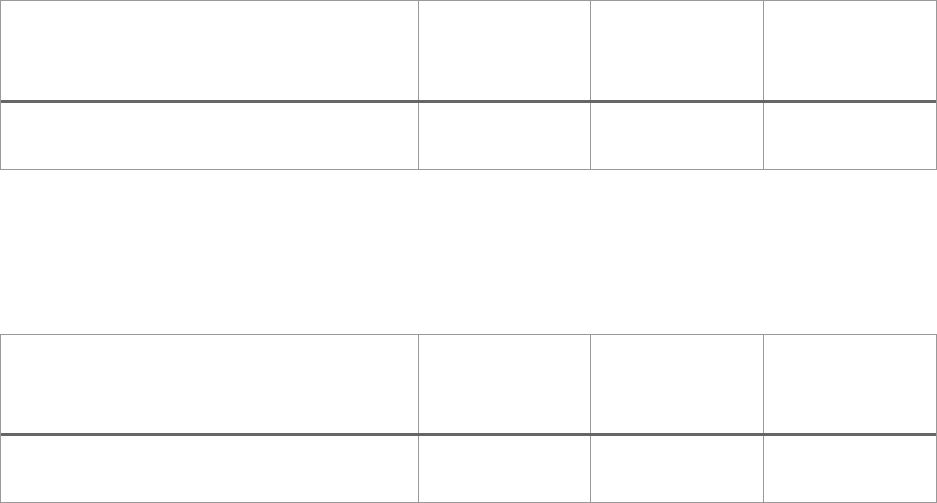
63
INSTITUTE OF EDUCATION SCIENCES
OVERVIEW
The Institute of Education Sciences (IES) supports sustained programs of research, statistics, and evaluation
to study and provide solutions to the challenges faced by schools, educators, and learners. Investment in
research, statistics, and evaluation activities is critical in order to identify effective instructional and
program practices, track student opportunity and achievement, and measure the impact of educational
improvement. Through its four centers—the National Center for Education Research, the National Center
for Education Statistics, the National Center for Education Evaluation and Regional Assistance, and the
National Center for Special Education Research—IES ensures the Federal investment in education research,
statistics, and evaluation is of high quality and relevant to the needs of educators and policymakers. The
Administration requests $815.5 million for IES activities, $7.9 million more than the fiscal year 2024
annualized CR level. The fiscal 2025 Request includes a rescission of $10 million from unobligated fiscal
year 2024 Statewide Longitudinal Data Systems funds expected to be carried over into fiscal year 2025 and
a rescission of $15 million from unobligated fiscal year 2024 Regional Educational Laboratories funds
expected to be carried over into fiscal year 2025.
RESEARCH, DEVELOPMENT, AND DISSEMINATION
-
2023
2024
Annualized CR
2025
Request
BA in millions $245.0 $245.0 $245.0
The Request supports critical investments in education research, development, dissemination, and
evaluation that provide parents and families, educators, and policymakers with evidence-based information
on effective educational practices.
STATISTICS
-
2023
2024
Annualized CR
2025
Request
BA in millions $121.5 $121.5 $121.5
The Department’s Statistics program—operated primarily through competitively awarded contracts
administered by National Center for Education Statistics—provides general statistics about trends in
education, collects data to monitor reform and measure educational progress, and informs the IES research
agenda. The Request would support the collection, analysis, and dissemination of education-related
statistics in response to both legislative requirements and to the particular needs of data providers, data
users, and educational researchers.

64
REGIONAL EDUCATIONAL LABORATORIES
-
2023
2024
Annualized CR
2025
Request
BA in millions $58.7 $58.7 $58.7
Funds support a network of 10 regional laboratories that provide expert advice, including training and
technical assistance, to help States and school districts apply proven research findings in their school
improvement efforts. Funds also support the Regional Educational Laboratories in widely disseminating
information about best practices. The fiscal year 2025 Request includes a rescission of $15 million from
unobligated fiscal year 2024 funds expected to be carried over into fiscal year 2025.
ASSESSMENT
-
2023
2024
Annualized CR
2025
Request
BA in millions $192.8 $192.8 $193.3
Funds support the National Assessment of Educational Progress (NAEP), which measures and reports on
the status of and trends in student learning over time on a subject-by-subject basis and makes objective
information on student performance available to policymakers, educators, parents and families, and the
public. As the largest nationally representative and continuing assessment of what American students know
and can do, NAEP has become a key measure of our Nation’s educational performance. The Request
includes support for research and development needed to advance NAEP and reduce future program costs.
The Request also includes a $0.5 million increase for the National Assessment Governing Board (NAGB)
to fund additional staff support and NAGB operational costs.
RESEARCH IN SPECIAL EDUCATION
-
2023
2024
Annualized CR
2025
Request
BA in millions $64.3 $64.3 $64.3
Funds support a comprehensive program of special education research designed to expand the knowledge
and understanding of infants, toddlers, and children with disabilities; answer questions about how children
with disabilities develop and learn; and learn how best to support their development through improved
teaching and special education and related services. Continued investment in such long-term programs of
research is necessary to accumulate empirical knowledge and develop evidence-based practices and policies
that will result in improved academic achievement, social and emotional well- being, behavior, and physical
development for children with disabilities.

65
STATEWIDE LONGITUDINAL DATA SYSTEMS
-
2023
2024
Annualized CR
2025
Request
BA in millions $38.5 $38.5 $38.5
Funds support competitive grant awards to States to foster the design, development, implementation, and
use of longitudinal data systems. In addition, funds would support awards to public and private agencies to
improve data coordination, quality, and use at the local, State, and national levels. The fiscal year 2025
Request includes a rescission of $10 million from unobligated fiscal 2024 funds expected to be carried over
into fiscal year 2025.
SPECIAL EDUCATION STUDIES AND EVALUATIONS
-
2023
2024
Annualized CR
2025
Request
BA in millions $13.3 $13.3 $13.3
This program supports studies to assess the implementation of the Individuals with Disabilities Education
Act (IDEA) and the effectiveness of State and local efforts to provide special education and early
intervention programs and services to infants, toddlers, and children with disabilities.
IES PROGRAM ADMINISTRATION
-
2023
2024
Annualized CR
2025
Request
BA in millions $73.5 $73.5 $80.9
Funds support administrative expenses necessary for IES to carry out authorized activities. Expenses
include IES pay and non-pay, as well as the IES share of centralized support costs such as rent and enterprise
cybersecurity.
66
DEPARTMENTAL MANAGEMENT
OVERVIEW
Congress established the Department of Education as a Cabinet level agency in 1980. Today, the
Department supports programs that touch every area and level of education. The Department’s early
learning, elementary, and secondary education programs annually serve more than 17,000 public school
districts and more than 55 million students attending more than 98,000 public and 30,000 private schools.
Department programs also provide grant, loan, and work-study assistance to more than 9.3 million
postsecondary students at approximately 5,400 institutions of higher education.
The Department is responsible for administering education programs authorized and funded by Congress
and signed into law by the President. This responsibility involves developing regulations and policy
guidance regarding program operations, determining how program funds are awarded to recipients
consistent with statutory requirements, and ensuring programs are operated fairly and conform to statutes
and laws prohibiting discrimination in federally funded activities. The Department also collects data and
conducts research on education to help focus attention on education issues of national importance.
Most Federal funds for education are distributed using one of three methods: (1) a statutory formula based
on certain eligibility requirements, such as the number of students from low-income backgrounds in a
school district; (2) a competitive process aimed at identifying the most promising proposals or projects
targeting a particular educational purpose; or (3) an assessment of financial need, such as the ability of a
student or family to pay for college.
Key programs include the Title I Grants to Local Educational Agencies, for which $18.6 billion would help
approximately 26 million students in K-12 schools with high rates of poverty make progress toward State
academic standards, and $14.4 billion for the Individuals with Disabilities Education Act Part B Grants to
States to help States and school districts meet the special education needs of 7.9 million students with
disabilities. Key programs also include Federal Pell Grants, which would make available $39.3 billion in
need-based grants to nearly 7.2 million students enrolled in postsecondary institutions; and the
postsecondary student loan programs, which would help provide roughly $93.1 billion in new Direct Loans
to help students and families pay for college.
The Department’s programs and responsibilities have grown substantially over time. Some of the growth
has resulted from greater demands that were placed on the Department to secure sensitive data, increase
transparency through increased data reporting, provide enhanced oversight and enforcement of programs
and laws, and award and manage new grant programs. The Office for Civil Rights needs additional
resources to address a rising volume of complaints, including those related to a recent surge in antisemitism,
anti-Arab discrimination, and other forms of discrimination in our communities, colleges, and schools.
Federal Student Aid has been tasked with implementing critical improvements to student loan servicing,
continuing to modernize its digital infrastructure, and ensuring successful administration of the financial
aid programs through a simplified and streamlined process for students and borrowers.

67
SALARIES AND EXPENSES (S&E) OVERVIEW: DEPARTMENT MANAGEMENT
BA in millions
2023
2024
Annualized CR
2025
Request
Program Administration $426.9 $426.9 $476.8
IES Program Administration 73.5 73.5 80.9
Office for Civil Rights 140.0 140.0 162.4
Office of Inspector General 67.5 67.5 77.5
Student Aid Administration 2,033.9 2,033.9 2,659.1
Other
1
9.0 9.0 9.5
Total 2,750.8 2,750.8 3,466.2
SALARIES AND EXPENSES (S&E) OVERVIEW: FULL-TIME EQUIVALENT EMPLOYMENT (FTE)
in whole numbers
2023
2024
Annualized CR
2025
Request
Program Administration 1,536 1,549 1,612
IES Program Administration 199 221 236
Office for Civil Rights 574 557 643
Office of Inspector General 219 217 238
Student Aid Administration 1,521 1,615 1,691
Other
1
16 18 19
Total
2
4,065 4,177 4,439
1
Includes small Federal Credit Administration accounts and miscellaneous S&E activities in program accounts.
2
Actual FTE usage in fiscal year 2023; target for fiscal year 2022 and fiscal year 2024. Excludes BSCA, CRRSAA,
and ARP Act FTE.
68
The Department is requesting $3.5 billion for its Salaries and Expenses budget accounts in fiscal year 2025,
an increase of $715.4 million over the 2024 annualized CR level. The requested fiscal year 2025 increase
focuses on key departmental policy and management priorities. These include an increase of $22 million
for the Office for Civil Rights to advance equity in educational opportunity and delivery through an
increased investment in civil rights enforcement; an increase of $625 million for Student Aid
Administration to provide better support to the 46 million student loan borrowers and make additional
improvements to the new servicing system; and increased funding for continued IT security improvements
to ensure the integrity of the Department of Education systems and prevent potential breaches. Funding is
also being requested to modernize core acquisition and grants management systems.
The Department’s Request also includes funding necessary to restore critically needed staff capacity across
the organization. In fiscal year 2025, the Request supports 4,439 Full-Time Equivalents (FTE)
Employment, a net increase of 262 FTE above the 2024 annualized CR level.
PROGRAM ADMINISTRATION
The Program Administration account provides administrative support for most programs and offices in the
Department. The fiscal year 2025 Request totals $476.8 million, an increase of $49.9 million above the
2024 annualized CR level. The Budget includes $328.2 million for personnel compensation and benefits to
support 1,612 FTE, an increase of $22.3 million above 2024 annualized level of $305.9 million.
Salaries and Expenses non-personnel costs cover such items as travel, rent, mail, telephones, utilities,
printing, information technology (IT) services and security, contractual services, equipment, supplies, and
other services. The total request for non-personnel activities in fiscal year 2025 is $148.6 million, an
increase of $27.6 million above the 2024 annualized CR level of $121.0 million. Approximately 65 percent
of the total non-personnel request is to cover Program Administration’s share of the Department’s
centralized services. The centralized services request totals $96.5 million for fiscal year 2025, an increase
of $14.2 million over the 2024 annualized CR level, primarily for enterprise cybersecurity, and
modernization of the Department’s contracts and grants systems.
The overall account increase of $49.9 million is primarily needed for: (1) an increase of 63 FTE over the
2024 annualized CR level and a proposed 2.0 percent government-wide pay raise plus benefits increases;
(2) continued improvements to the Department’s IT security and infrastructure to ensure the integrity of the
Department’s data as well as to prevent potential IT security breaches; (3) modernization of the
Department’s contracts and grants systems; (4) enhanced data collection, analysis, and reporting of
education data, including Economic Stabilization Funds programs; and (5) implementation of the Executive
Order on the Safe, Secure, and Trustworthy Development and Use of Artificial Intelligence.
STUDENT AID ADMINISTRATION
The Student Aid Administration account provides funds to administer the Federal student aid programs
authorized under Title IV of the Higher Education Act. These programs are the Nation’s largest source of
financial aid for postsecondary education students, which helps students and families fund education costs
and training beyond high school.
This account also supports functions across the student aid lifecycle including educating students and
families on sources for obtaining aid as well as federal student loans and costs associated with processing
financial aid applications. These funds support financial tools, supports outstanding loans and collections
activities on defaulted federal loans and oversight of Title IV programs.
69
In fiscal year 2023, FSA provided $122.3 billion in new Federal student aid grants and loans (excluding
Direct Consolidation Loans) to more than 8.7 million postsecondary students and their families. These
students attended approximately 5,400 institutions of higher education.
The SAFRA Act ended the origination of new loans under the Federal Family Education Loan (FFEL)
program. Since July 1, 2010, new loans are originated and serviced through the Direct Loan (DL) program
administered by the Department. Private lenders and guaranty agencies service and collect outstanding non-
defaulted loans from the FFEL portfolio. The Department currently contracts with five servicers to service
a Department-held portfolio of approximately 37 million borrowers.
The Budget provides $2.7 billion for the Student Aid Administration, a $625 million increase above the
2024 annualized CR level. This additional funding is needed to provide better support to student loan
borrowers, especially as they continue return to regular repayment. This increase would allow FSA to
implement critical improvements to student loan servicing, continue to modernize its digital infrastructure,
and ensure successful administration of the financial aid programs through a simplified and streamlined
process for students and borrowers.
OFFICE FOR CIVIL RIGHTS
The Department’s Office for Civil Rights (OCR) investigates discrimination complaints, conducts
compliance reviews, monitors corrective action plans, and provides technical assistance on civil rights
issues. Since fiscal year 2009, the number of complaints has almost tripled, while the number of
investigative staff have decreased slightly over the same period. The fiscal year 2025 Request includes 86
additional FTE over the 2024 annualized CR level for OCR.
The fiscal year 2025 Request for OCR is $162.4 million, which is an increase of $22.4 million above the
2024 annualized CR level. About $126.4 million of the requested funds, or 78 percent, is for staff pay and
benefits for 643 FTE. The remaining $36.0 million is for non-pay projects and includes funding for
information technology services, including the $6.1 million contract for the Civil Rights Data Collection.
Requested funds would ensure program support to resolve complaints of discrimination filed by the public
and ensure that institutions receiving Federal financial assistance comply with the civil rights laws enforced
by OCR.
OFFICE OF INSPECTOR GENERAL
The Office of Inspector General (OIG) conducts audits and investigations of the Department’s programs
and activities to help ensure accountability for taxpayer-provided funds and to identify management
improvements. The fiscal year 2025 Request for the OIG is $77.5 million, an increase of $10.0 million over
the 2024 annualized CR level. Approximately 70 percent of this amount, or $53.9 million, is for personnel
compensation and benefits to support a staffing level of 238 FTE.
The non-personnel request of $23.6 million includes $1.2 million to contract for the mandatory annual audit
of the Department’s financial statements. The scope of the audit would include the examination and analysis
of account balances, review of applicable financial systems, and evaluation of internal controls and
compliance with significant laws and regulations. Additionally, the non-personnel request includes funds
to support the Council of the Inspectors General on Integrity and Efficiency, and to continue to develop the
ability to perform predictive analytics with a tool to identify patterns of fraud and risk, allowing the OIG to
better target its audit and investigative work.
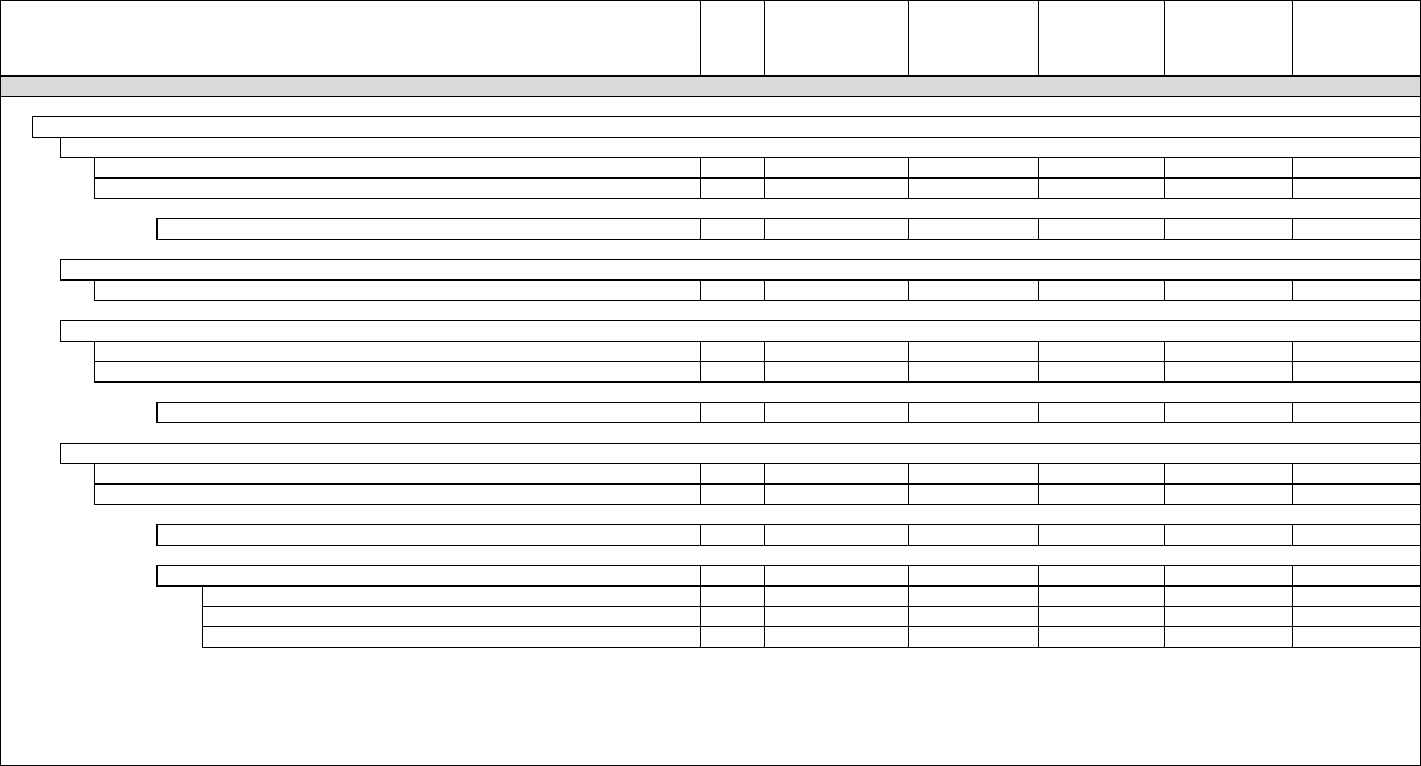
DEPARTMENT OF EDUCATION FISCAL YEAR 2025 PRESIDENT'S BUDGET
(in thousands of dollars)
CatCode
2023
Appropriation
2024
AnnualizedCR
2025President's
Budget
FY2025Request
ComparedtoFY
2024AnnualizedCR
Amount
FY2025Request
ComparedtoFY
2024Annualized
CRPercent
EducationfortheDisadvantaged
1. Grantstolocaleducationalagencies(ESEAI‐A):
(a) Basicgrants(section1124)
Annualappropriation D 5,695,625 5,695,625 5,695,625 0 0.00%
Advanceforsucceedingf
iscalyear D 763,776 763,776 763,776 0 0.00%
Subtotal D
6,459,401 6,459,401 6,459,401 0
0.00%
(b) Conc
entrationgrants(section1124A)
Advanceforsucceedingfiscalyear D
1,362,301 1,362,301 1,362,301
0 0.00%
(c) Targetedgrants(section1125)
Annualappropriation D 925,000 925,000 1,025,000 100,000 10.81%
Advanceforsucceedingfiscalyear
D 4,357,550 4,357,550 4,357,550
0 0.00%
Subtotal
5,282,550 5,282,550 5,382,550 100,000
1.89%
(d) Educationfinancein
centivegrants(section1125A)
Annualappropriation D 925,000 925,000 1,025,000 100,000 10.81%
Advanceforsucceedingfiscalyear
D 4,357,550 4,357,550 4,357,550
0 0.00%
Subtotal
5,282,550 5,282,550 5,382,550 100,000
1.89%
Subtotal,GrantstoLEAs
18,386,802 18,386,802 18,586,802 200,000
1.09%
Discretionary D
18,386,802 18,386,802 18,586,802 200,000
1.09%
Current
7,545,625 7,545,625 7,745,625 200,000
2.65%
Advanceforsucceedingfiscalyear
10,841,177 10,841,177 10,841,177 0
0.00%
NOTES:
1)D=di
scretionaryprogram;M=mandatoryprograms
3)Detailmaynotaddtototalsduetorounding.
2)PursuanttotheBudgetControlActof2011(P.L.112‐25),formostmandatoryprograms,withtheexceptionofPellGrants,CreditLiquidating,andCreditReestimates,thelevelsshowninthe2023and2024
A
pp
ro
p
riationcolumnsreflectthe5.7
p
ercentreductionthatwentintoeffectonOctober1
,
2022andOctober1
,
2023
,
res
p
ectivel
y
.
71
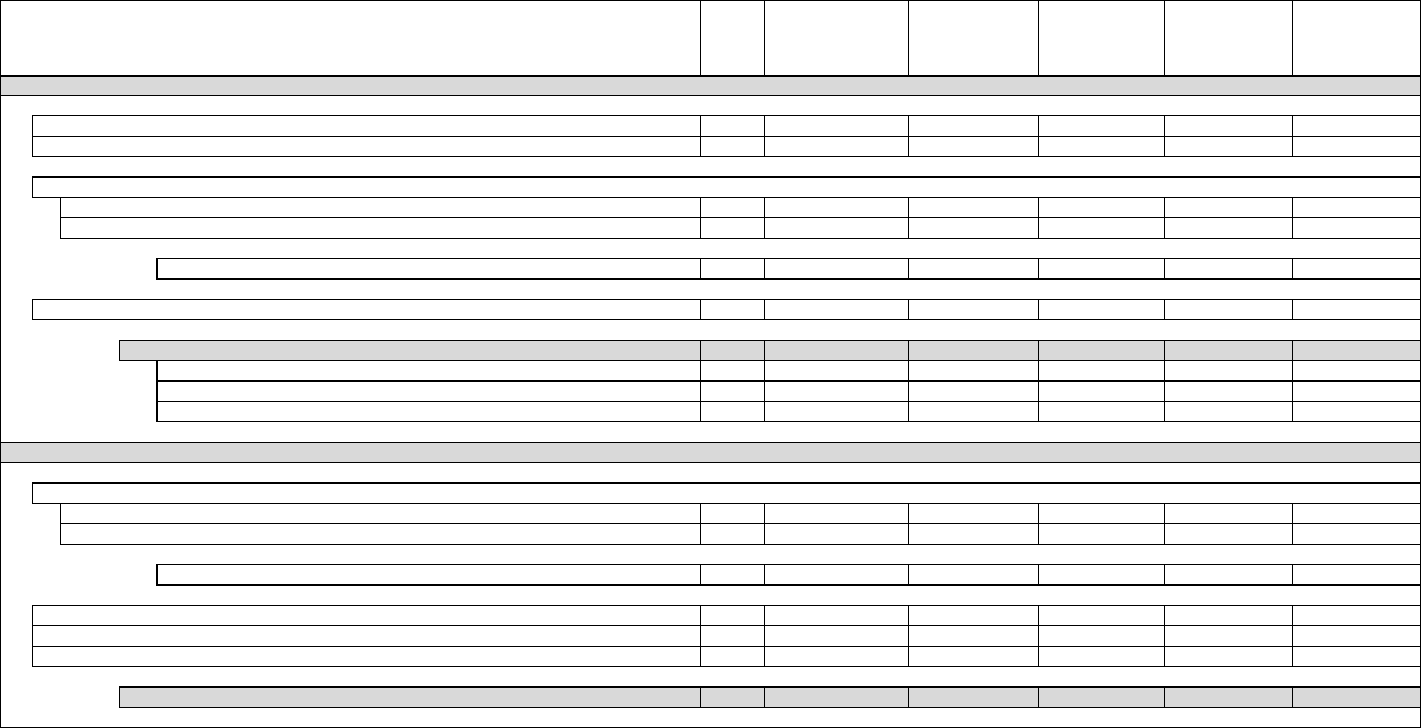
DEPARTMENT OF EDUCATION FISCAL YEAR 2025 PRESIDENT'S BUDGET
(in thousands of dollars)
CatCode
2023
Appropriation
2024
AnnualizedCR
2025President's
Budget
FY2025Request
ComparedtoFY
2024AnnualizedCR
Amount
FY2025Request
ComparedtoFY
2024Annualized
CRPercent
EducationfortheDisadvantaged(continued)
2. Comprehensiveliteracystatedevelopmentgrants(ESEAII‐B‐2,section2222) D
194,000 194,000 194,000
0 0.00%
3. Innovativeapproachestoliteracy(ESEAII‐B‐2,section2226) D
30,000 30,000 30,000
0 0.00%
4. Stateagencyprograms:
(a) Migrant(ESEAI‐C) D 375,626 375,626 375,626 0 0.00%
(b) Neglected,delinquentandat‐ri
skchildrenandyouth(ESEAI‐D) D 49,239 49,239 49,239 0 0.00%
Subtotal,Stateagencyprograms
424,865 424,865 424,865 0
0.00%
5. Specialprogramsformigrantstudents(HEAIV‐A‐5) D 52,123 52,123 52,123 0 0.00%
Total,Appropriation 19,087,790 19,087,790 19,287,790 200,000 1.05%
Discretionary D 19,087,790 19,087,790 19,287,790 200,000 1.05%
Current 8,246,613 8,246,613 8,446,613 200,000 2.43%
Prioryear'sadvance 10,841,177 10,841,177 10,841,177 0 0.00%
I
mpactAid(ESEAVII)
1. Paymentsforfederallyconnectedchildren(section7003):
(a) Basicsupportpayments(section7003(b)) D 1,468,242 1,468,242 1,468,242 0 0.00%
(b) Paymentsforchildrenwithdisabilities(section7003(d)) D 48,316 48,316 48,316 0 0.00%
Subtotal 1,516,558 1,516,558 1,516,558 0 0.00%
2. Facilitiesmaintenance(section7008) D 4,835 4,835 4,835 0 0.00%
3. Construction(section7007) D 18,406 18,406 18,406 0 0.00%
4.
PaymentsforFederalproperty(section7002) D 78,313 78,313 78,313 0 0.00%
Total D 1,618,112 1,618,112 1,618,112 0 0.00%
72
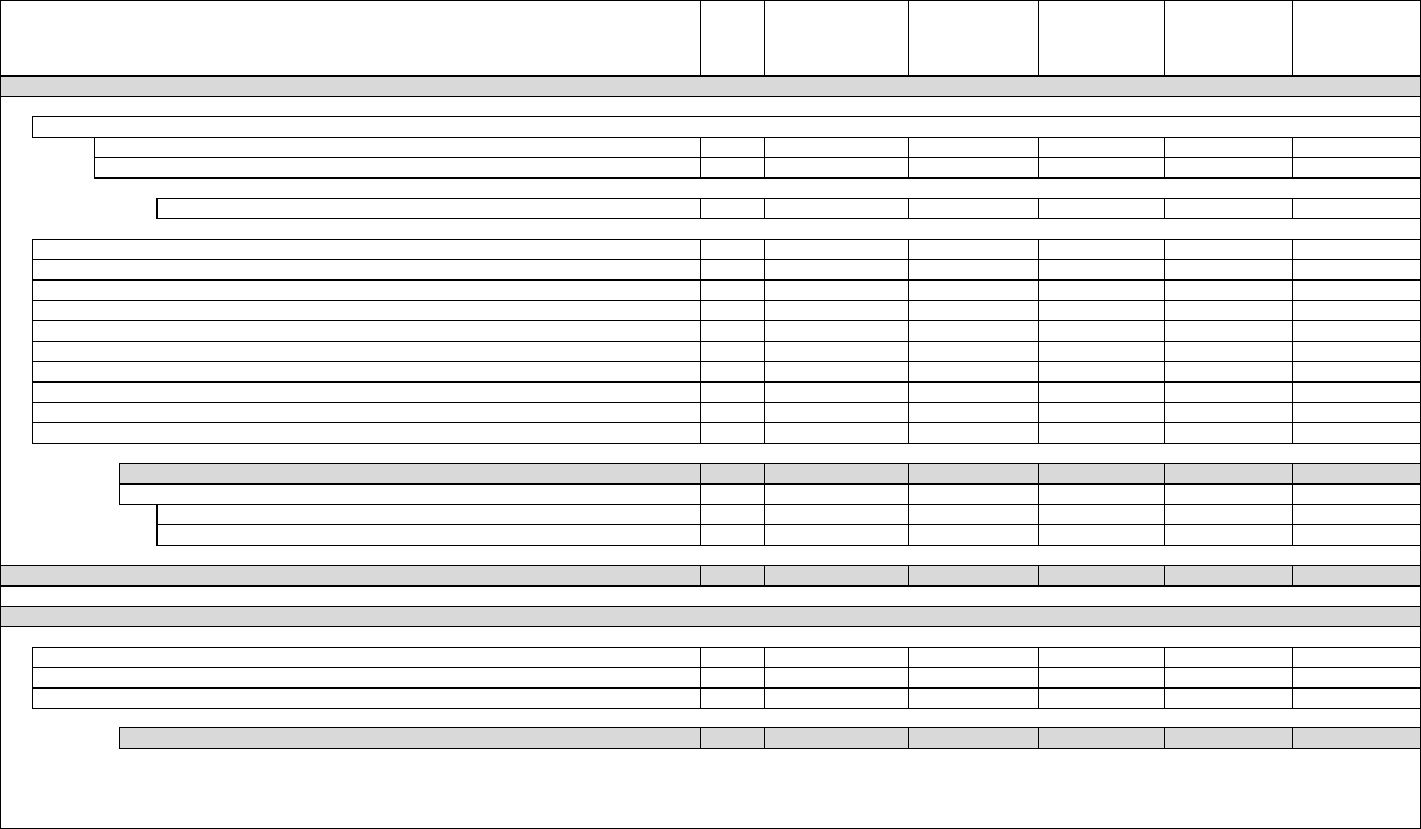
DEPARTMENT OF EDUCATION FISCAL YEAR 2025 PRESIDENT'S BUDGET
(in thousands of dollars)
CatCode
2023
Appropriation
2024
AnnualizedCR
2025President's
Budget
FY2025Request
ComparedtoFY
2024AnnualizedCR
Amount
FY2025Request
ComparedtoFY
2024Annualized
CRPercent
1. SupportingeffectiveinstructionStategrants(ESEAII‐A)
Annualappropriation D 508,639 508,639 508,639 0 0.00%
Advanceforsucceedingfiscalyear D 1,681,441 1,681,441 1,681,441 0 0.00%
Subtotal D 2,190,080 2,190,080 2,190,080 0 0.00%
2. 21stcenturycommunitylearningcenters(ESEAIV‐B) D 1,329,673 1,329,673 1,329,673 0 0.00%
3. Stateassessments(ESEAI‐B,section1201‐1203) D 390,000 390,000 390,000 0 0.00%
4.
Educationforhomelesschildrenandyouths(MVHAATitleVII‐B) D 129,000 129,000 129,000 0 0.00%
5. NativeHawaiianeducation(ESEAVI‐B) D 45,897 45,897 45,897 0 0.00%
6. AlaskaNativeeducation(ESEAVI‐C) D 44,953 44,953 44,953 0 0.00%
7. Trainingandadvisoryservices(CRAIV) D 6,575 6,575 6,575 0 0.00%
8. Ruraleducation(ESEAV‐B) D
215,000 215,000 215,000 0 0.00%
9. Supplementaleducationgrants(CompactofFreeAssociationAct)
1
D 24,464 24,464 0 (24,464) ‐100.00%
10. Comprehensivecenters(ETAAsection203) D 55,000 55,000 50,000 (5,000) ‐9.09%
11. Studentsupportandacademicenrichmentgrants(ESEAIV‐A) D 1,380,000 1,380,000 1,380,000 0 0.00%
Total,Appropriation D 5,810,642 5,810,642 5,781,178 (29,464) ‐0.51%
Total,Budgetauthority D 5,810,642 5,810,642 5,781,178 (29,464) ‐0.51%
Current 4,129,201 4,129,201 4,099,737 (29,464) ‐0.71%
Prioryear'sadvance 1,681,441 1,681,441 1,681,441 0 0.00%
SchoolReadines
s(ProposedLegislation)
D0 0 25,000 25,000 ‐‐‐
IndianEducation(ESEAVI)
1. Grantstolocaleducationalagencies(PartA‐1) D 110,381 110,381 110,381 0 0.00%
2. SpecialprogramsforIndianchildren(PartA‐2) D 72,000 72,000 72,000 0 0.00%
3. Nationalactivities(PartA‐3) D 12,365 12,365 12,365 0 0.00%
Total D 194,746 194,746 194,746 0 0.00%
1
TheAdministrationisproposingmandatoryfundingtobeadministeredbytheDepartmentofStatethatwouldsubsumetheprogramsandactivitiespreviouslyfundedthrough
discretionaryappropriations,includingtheonefortheSupplementalEducationGrants.
S
choolImprovementPrograms
73
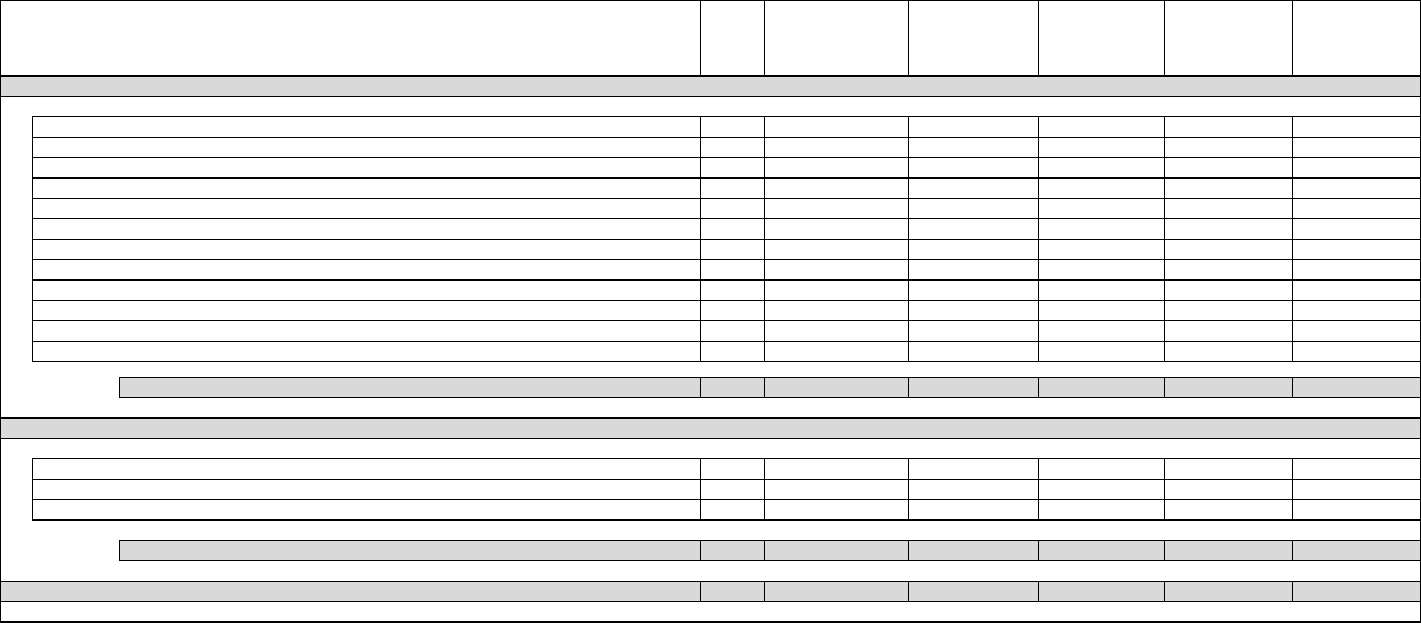
DEPARTMENT OF EDUCATION FISCAL YEAR 2025 PRESIDENT'S BUDGET
(in thousands of dollars)
CatCode
2023
Appropriation
2024
AnnualizedCR
2025President's
Budget
FY2025Request
ComparedtoFY
2024AnnualizedCR
Amount
FY2025Request
ComparedtoFY
2024Annualized
CRPercent
InnovationandImprovement
1. Educationinnovationandresearch(ESEAIV‐F‐1) D 284,000 284,000 269,000 (15,000) ‐5.28%
2. Teacherandschoolleaderincentivegrants(ESEAII‐B‐1) D 173,000 173,000 173,000 0 0.00%
3. Americanhistoryandcivicseducation(ESEAII‐B‐3)
D 23,000 23,000 23,000
0 0.00%
4. Supportingeffectiveeducatordevelopment(SEED)(ESEAII‐B‐4,se
ction2242) D 90,000 90,000 90,000 0 0.00%
5. Charterschoolsgrants(ESEAIV‐C) D 440,000 440,000 400,000 (40,000) ‐9.09%
6. Magnetschoolsassistance(ESEAIV‐D) D 139,000 139,000 139,000 0 0.00%
7. Readytolearnprogramming(ESEAIV‐F‐4,section4643) D 31,000 31,000 31,000 0 0.00%
8. Artsineducation(ESEAIV‐F‐4,se
ction4642) D 36,500 36,500 36,500 0 0.00%
9. Javitsgiftedandtalentededucation(ESEAIV‐F‐4,section4644)
D
16,500 16,500 16,500 0 0.00%
10. Statewidefamilyengagementcenters(ESEAIV‐E)
D
20,000 20,000 20,000 0 0.00%
11. FosteringDiverseSchools(proposedlegislation)
D
0 0 10,000 10,000 ‐‐‐
12. CommunityProjectFunding/CongressionallyDirectedSpendi
ng
D
200,443 200,443 0 (200,443) ‐100.00%
Total D 1,453,443 1,453,443 1,208,000 (245,443) ‐16.89%
SafeSchoolsandCitizenshipEducation
1. Schoolsafetynationalactivities(ESEAIV‐F‐3,section4631) D 216,000 216,000 216,000 0 0.00%
2. Promiseneighborhoods(ESEAIV‐F‐2,section4624) D 91,000 91,000 91,000 0 0.00%
3. Full‐servicecommunityschools(ESEAIV‐F‐2,section4625) D 150,000 150,000 200,000 50,000 33.33%
Total D 457,000 457,000 507,000 50,000 10.94%
EnglishLanguageAcquisition(ESEAIII‐A)
D 890,000 890,000 940,000 50,000 5.62%
74
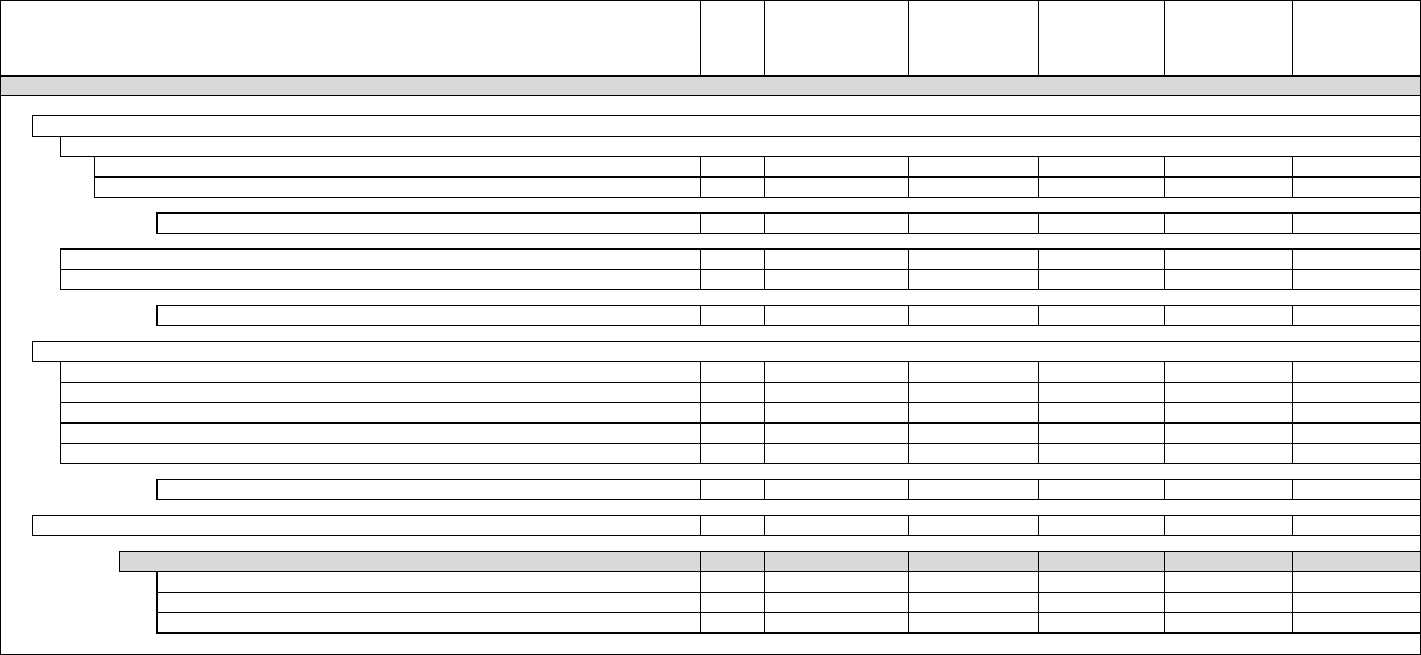
DEPARTMENT OF EDUCATION FISCAL YEAR 2025 PRESIDENT'S BUDGET
(in thousands of dollars)
CatCode
2023
Appropriation
2024
AnnualizedCR
2025President's
Budget
FY2025Request
ComparedtoFY
2024AnnualizedCR
Amount
FY2025Request
ComparedtoFY
2024Annualized
CRPercent
S
pecialEducation
1. Stategrants:
(a) GrantstoStates(IDEAB‐611)
Annualappropriation D 4,910,321 4,910,321 5,110,321 200,000 4.07%
Advanceforsucceedingfiscalyear D 9,283,383 9,283,383 9,283,383 0 0.00%
Subtotal 14,193,704 14,193,704 14,393,704 200,000 1.41%
(b) Preschoolgrants(IDEAB‐619) D 420,000 420,000 425,000 5,000 1.19%
(c) Grantsforinfantsandfamilies(IDEAC) D 540,000 540,000 545,000 5,000 0.93%
Subtotal,Stategrants 15,153,704 15,153,704 15,363,704 210,000 1.39%
2. Nationalactivities(IDEAD):
(a) Statepersonneldevelopment(subpart1) D 38,630 38,630 38,630 0 0.00%
(b) Technicalassistanceanddissemination(section663) D 45,345 45,345 45,345 0 0.00%
(c) Personnelpreparation(section662) D 115,000 115,000 125,000 10,000 8.70%
(d) Parentinformationcenters(sections671‐673) D 33,152 33,152 33,152 0 0.00%
(e) Educationaltechnology,media,andmaterials(section674) D 31,433 31,433 31,433 0 0.00%
Subtotal
,Nationalactivities D 263,560 263,560 273,560 10,000 3.79%
3. SpecialOlympicseducationprograms(SpecialOlympicsSportandEmpowermentAct) D 36,000 36,000 36,000 0 0.00%
Total,Appropriation 15,453,264 15,453,264 15,673,264 220,000 1.42%
Discretionary D 15,453,264 15,453,264 15,673,264 220,000 1.42%
Current 6,169,881 6,169,881 6,389,881 220,000 3.57%
Prioryear'sadvance 9,283,383 9,283,383 9,283,383 0 0.00%
75
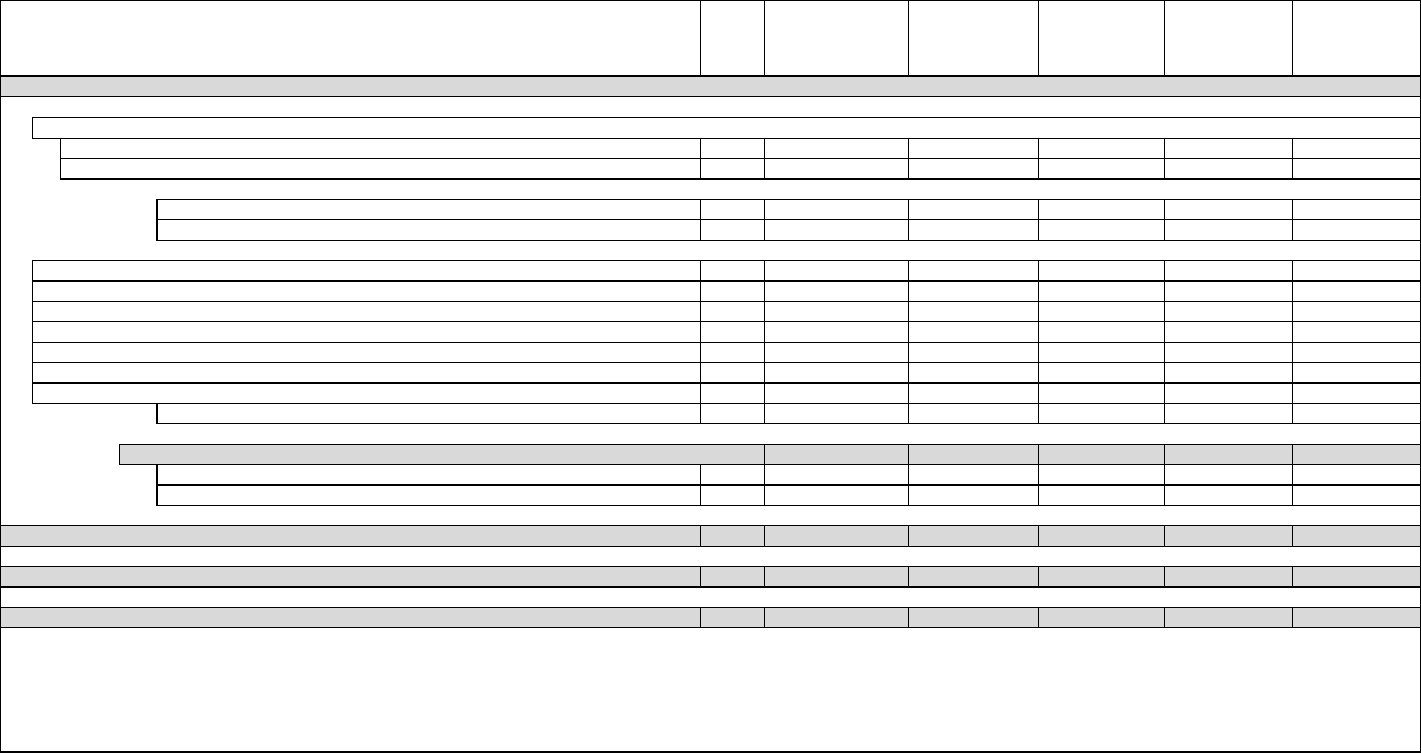
DEPARTMENT OF EDUCATION FISCAL YEAR 2025 PRESIDENT'S BUDGET
(in thousands of dollars)
CatCode
2023
Appropriation
2024
AnnualizedCR
2025President's
Budget
FY2025Request
ComparedtoFY
2024AnnualizedCR
Amount
FY2025Request
ComparedtoFY
2024Annualized
CRPercent
RehabilitationServices
1. VocationalrehabilitationStategrants:
(a) GrantstoStates(RATitleI‐A,sections110and111)
1
M 3,899,057 4,200,219 4,200,219 0 0.00%
(b) GrantstoIndians(RATitleI‐C) M 50,650 53,615 53,615 0 0.00%
Subtotal,Pre‐Sequestration
2
M 3,949,707 4,253,834 4,253,834 0 0.00%
Subtotal,Post‐Sequestration
3
M 3,724,574 4,011,365 4,011,365 0 0.00%
2. ClientassistanceStategrants(RAsection112) D 13,000 13,000 13,000 0 0.00%
3. Training(RAsection302) D 29,388 29,388 23,388 (6,000) ‐20.42%
4. Demonstrationandtrainingprograms(RAsection303) D 5,796 5,796 11,796 6,000 103.52%
5. Protectionandadvocacyofindividualrights(RAsection509) D 20,150 20,150 20,150 0 0.00%
6. SupportedemploymentStategra
nts(RAVI) D 22,548 22,548 22,548 0 0.00%
7. Independentlivingservicesforolderblindindividuals(RAVII,Chapter2)
D 33,317 33,317 33,317 0 0.00%
8. HelenKellerNationalCenterforDeaf‐BlindYouthsandAdults(HKNCA) D 19,000 19,000 19,000 0 0.00%
Subtotal 143,199 143,199 143,199 0 0.00%
Total 4,092,906 4,397,033 4,397,033 0 0.00%
Discretionary D 143,199 143,199 143,199 0 0.00%
Mandatory M
3,949,707 4,253,834 4,253,834 0 0.00%
AmericanPrintingHousefortheBlind(20U.S.C.101etseq.)
D 43,431 43,431 43,431 0 0.00%
NationalTechnicalInstitutefortheDeaf(EDAI‐Bandsection207)
D 92,500 92,500 92,500 0 0.00%
GallaudetUniversity(EDAI‐Aandsection207)
D 165,361 165,361 165,361 0 0.00%
1
Thisamountispre‐sequestration.
3
The2025RequestincludestheCHIMPof‐$128,364thousand,whichequalsthestatutoryConsumerPriceIndexincreasereducedbysequestration(5.7%).
2
TheVocationalRehabilitationStateGrantsprogramisamandatoryappropriatedentitlement;therefore,underanFY2024annualizedCR,theprogramisentitledtoallstatutoryadjustmentsprovidedforinsection110(a)ofthe
RehabilitationAct,includingthestatutoryConsumerPriceIndexincrease.The2025RequestexcludesthestatutoryConsumerPriceIndexincreaseof$136,123thousand.
76
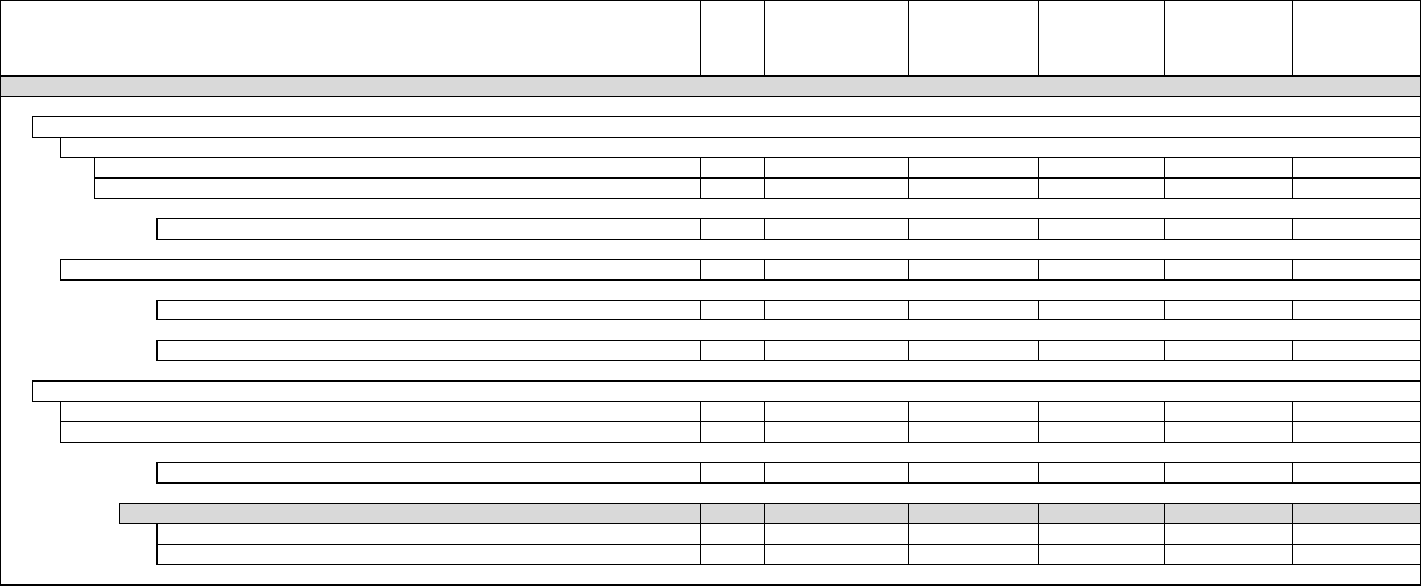
DEPARTMENT OF EDUCATION FISCAL YEAR 2025 PRESIDENT'S BUDGET
(in thousands of dollars)
CatCode
2023
Appropriation
2024
AnnualizedCR
2025President's
Budget
FY2025Request
ComparedtoFY
2024AnnualizedCR
Amount
FY2025Request
ComparedtoFY
2024Annualized
CRPercent
Career,Technical,andAdultEducation
1. Careerandtechnicaleducation(CarlD.PerkinsCTEA):
(a) Stategrants(TitleI)
Annualappropriation D 638,848 638,848 678,848 40,000 6.26%
Advanceforsucceedingfiscalyear D 791,000 791,000 791,000 0 0.00%
Subtotal 1,429,848 1,429,848 1,469,848 40,000 2.80%
(b) Nationalprograms(section114) D 32,421 32,421 64,421 32,000 98.70%
Subtotal,Discretionary D 1,462,269 1,462,269 1,534,269 72,000 4.92%
Subtotal,Careerandtec
hnicaleducation 1,462,269 1,462,269 1,534,269 72,000 4.92%
2. Adulteducation:
(a) AdultbasicandliteracyeducationStategrants(AEFLA) D 715,455 715,455 715,455 0 0.00%
(b) Nationalleadershipactivities(AEFLAsection242) D 13,712 13,712 18,712 5,000 36.46%
Subtotal,Adulteducation 729,167 729,167 734,167 5,000 0.69%
Total,Appropriation 2,191,436 2,191,436 2,268,436 77,000 3.51%
Current 1,400,436 1,400,436 1,477,436 77,000 5.50%
Prioryear'sadvance 791,000 791,000 791,000 0 0.00%
77
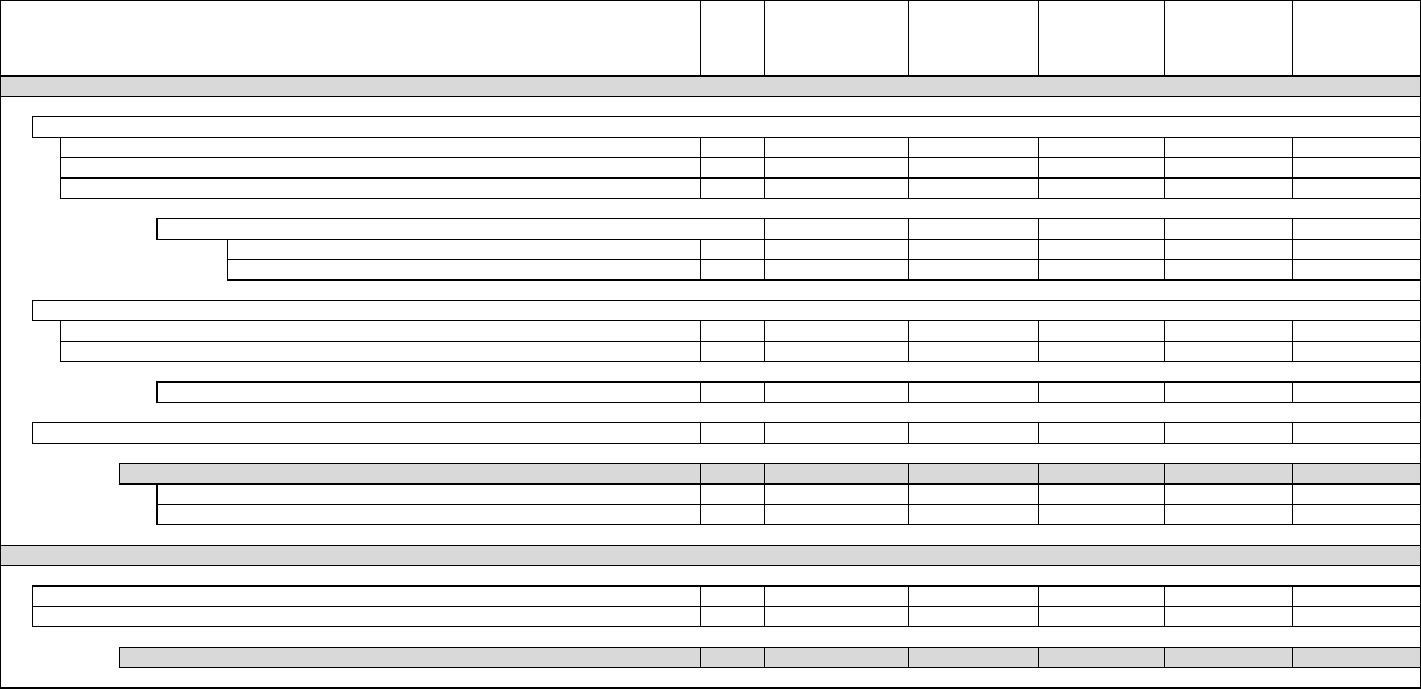
DEPARTMENT OF EDUCATION FISCAL YEAR 2025 PRESIDENT'S BUDGET
(in thousands of dollars)
CatCode
2023
Appropriation
2024
AnnualizedCR
2025President's
Budget
FY2025Request
ComparedtoFY
2024AnnualizedCR
Amount
FY2025Request
ComparedtoFY
2024Annualized
CRPercent
StudentFinancialAssistance
1. FederalPellgrants(HEAIV‐A‐1):
(a) DiscretionaryPellgrants D 22,475,352 22,475,352 24,576,352 2,101,000 9.35%
(b) MandatoryPellgrants M
5,150,720 5,629,000 8,743,000 3,114,000 55.32%
(c) MandatoryFundingforDiscretionaryProgramCosts M 1,095,000 1,095,000 1,155,000 60,000 5.48%
Subtotal,FederalPellgrants 28,721,072 29,199,352 34,474,352 5,275,000 18.07%
Discretionary D 22,475,352 22,475,352 24,576,352 2,101,000 9.35%
Mandatory M 6,245,720 6,724,000 9,898,000 3,174,000 47.20%
2. Campus‐basedprog
rams:
(a) Federalsupplementaleducationalopportunitygrants(HEAIV‐A‐3) D 910,000 910,000 910,000 0 0.00%
(b) Federalwork‐study(HEAIV‐C) D 1,230,000 1,230,000 1,230,000 0 0.00%
Subtotal,Campus‐basedprograms 2,140,000 2,140,000 2,140,000 0 0.00%
3. IraqandAfghanistanservicegrants(P.L.111‐39) M 664 530 30 (500) ‐94.34%
Total 30,861,736 31,339,882 36,614,382 5,274,500 16.83%
Di
scretionary D 24,615,352 24,615,352 26,716,352 2,101,000 8.54%
Mandatory M 6,246,384 6,724,530 9,898,030 3,173,500 47.19%
StudentAidAdministration(HEAI‐DandIV‐D,section458)
1. Salariesandexpenses D 1,058,943 1,058,943 1,334,743 275,800 26.04%
2. Servicingactivities D 975,000 975,000 1,324,383 349,383 35.83%
Total 2,033,943 2,033,943 2,659,126 625,183 30.74%
78
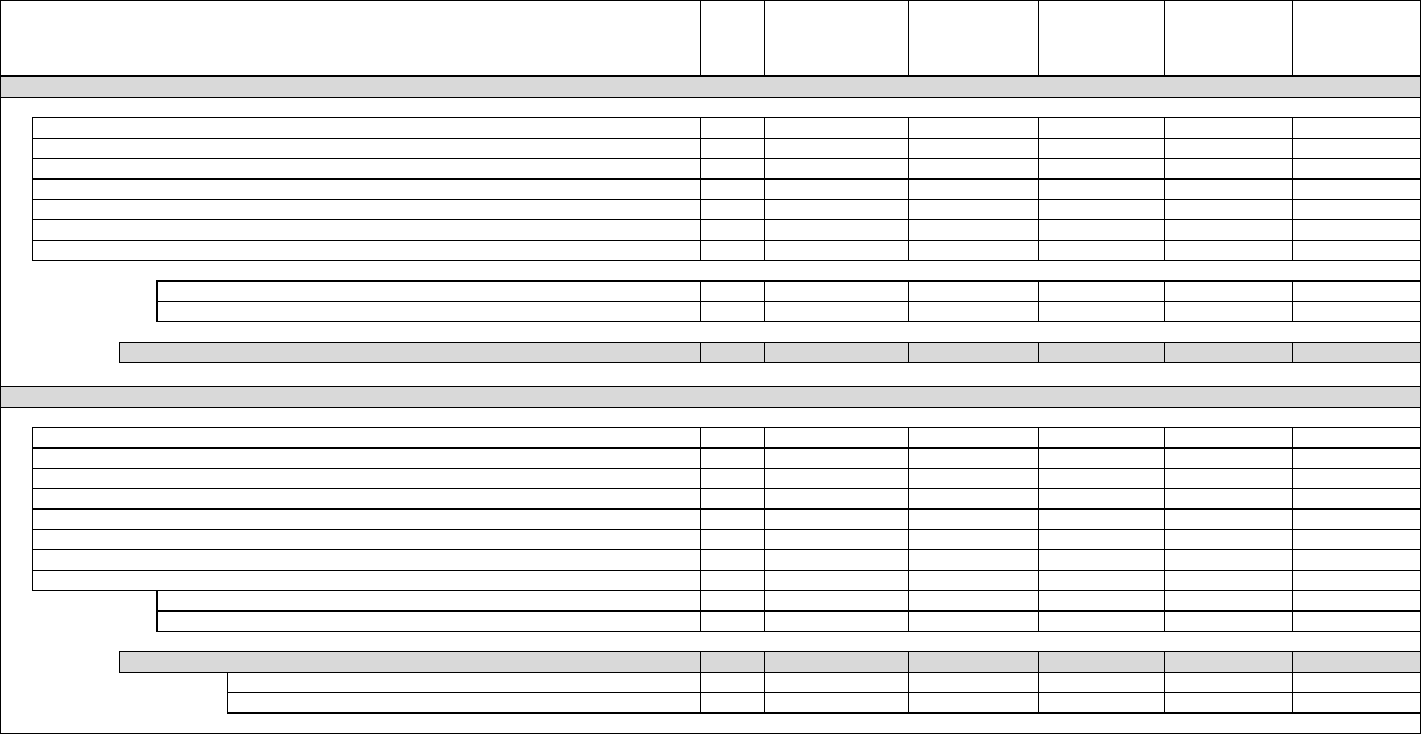
DEPARTMENT OF EDUCATION FISCAL YEAR 2025 PRESIDENT'S BUDGET
(in thousands of dollars)
CatCode
2023
Appropriation
2024
AnnualizedCR
2025President's
Budget
FY2025Request
ComparedtoFY
2024AnnualizedCR
Amount
FY2025Request
ComparedtoFY
2024Annualized
CRPercent
TEACHGrants(HEAIV‐A‐9)
1. Newloansubsidy M 34,171 38,920 39,188 268 0.69%
2. Upwardreestimateofexistingloans M 24,093 22,801 0 (22,801) ‐100.00%
3. Downwardreestimateofexistingloans(non‐add) M (11,352) (15,483) 0 15,483 100.00%
4. Netreestimateofexistingloans(non‐add) M 12,741 7,318 0 (7,318) ‐100.00%
5. Upwardmodificationofexistingloans M 12,548 0 0 0 ‐‐‐
6. Downwardmodificationofexistingloans M (51,645) 0 0 0 ‐‐‐
7. Netmodificationofexistingloans(non‐add) M (39,097) 0 0 0
‐‐‐
Subtotal,loansubsidies 70,812 61,721 39,188 (22,533) ‐36.51%
Subtotal,newloansubsidiesandnetreestimate/modification(non‐add) 7,815 46,238 39,188 (7,050) ‐15.25%
Total M 70,812 61,721 39,188 (22,533) ‐36.51%
FederalDirectStudentLoansProgramAccount(HEAIV‐D)
1. Newloansubsidies M 20,973,978 33,538,043 42,266,917 8,728,874 26.03%
2. Newnetloansubsidy(non‐add) M 19,290,143 32,986,256 42,266,917 9,280,661 28.13%
3. Upwardreestimateofexistingloans M 8,131,676 65,842,936 0 (65,842,936) ‐100.00%
4. Downwardrees
timateofexistingloans(non‐add) M (10,049,156) (1,682,552) 0 1,682,552 100.00%
5. Netreestimateofexistingloans(non‐add) M (1,917,480) 64,160,384 0 (64,160,384) ‐100.00%
6. Upwardmodificationofexistingloans M 116,808,248 0 0 0 ‐‐‐
7. Netmodificationofexistingloans(non‐add) M (202,558,349) 0 0 0 ‐‐‐
8. TemporaryExpandedPublicServiceLoanForgiveness D 0 0 0 0 ‐‐‐
Subtotal,loansubsidies 145,913,902 99,380,979 42,266,917 (57,114,062) ‐57.47%
Subtotal,newloansubsidiesandnetreestimate/modification(non‐add) (185,185,686) 97,146,640 42,266,917 (54,879,723) ‐56.49%
Total 145,913,902 99,380,979 42,266,917 (57,114,062) ‐57.47%
Di
scretionary D 0 0 0 0 ‐‐‐
Mandatory M 145,913,902 99,380,979 42,266,917 (57,114,062) ‐57.47%
79
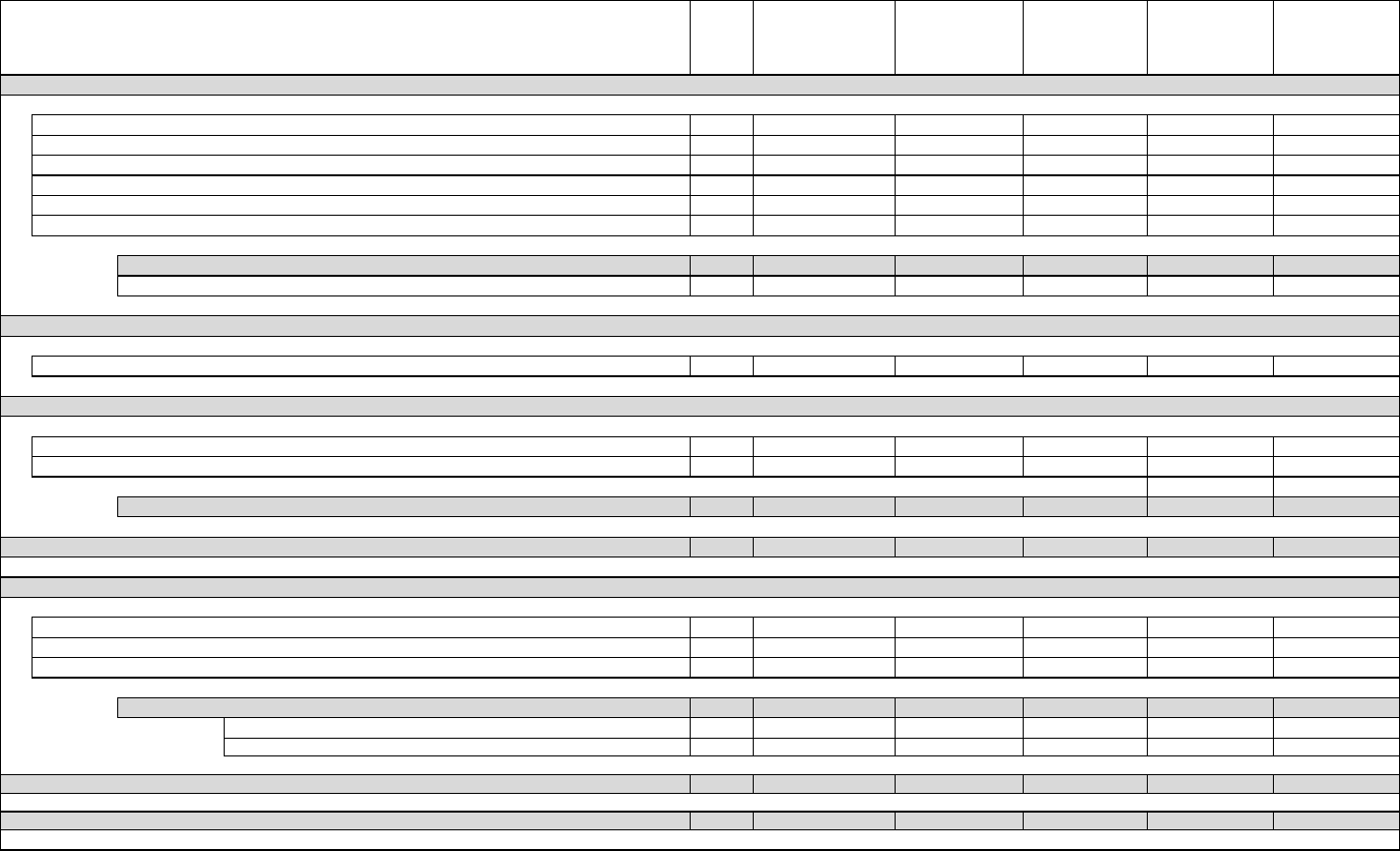
DEPARTMENT OF EDUCATION FISCAL YEAR 2025 PRESIDENT'S BUDGET
(in thousands of dollars)
CatCode
2023
Appropriation
2024
AnnualizedCR
2025President's
Budget
FY2025Request
ComparedtoFY
2024AnnualizedCR
Amount
FY2025Request
ComparedtoFY
2024Annualized
CRPercent
FederalFamilyEducationLoansProgramAccount(HEAIV‐B)
1. Upwardreestimateofexistingloans M 2,924,909 11,976,626 0 (11,976,626) ‐100.00%
2. Downwardreestimateofexistingloans(non‐add) M (899,176) (2,339,384) 0 2,339,384 100.00%
3. Netreestimateofexistingloans(non‐add) M 2,025,733 9,637,242 0 (9,637,242) ‐100.00%
4. Upwardmodificationofexistingloans M 9,082,129 0 0 0 ‐‐‐
5. Downwardmodificationofexistingloans(non‐add) M (13,647,235) 0 0 0 ‐‐‐
6. Netmodificationofexistingloans(non‐add)
M (4,565,106) 0 0 0 ‐‐‐
Total,FFELProgramAccount M 12,007,038 11,976,626 0 (11,976,626) ‐100.00%
Total,newloansubsidiesandnetreestimate(non‐add) 2,025,733 9,637,242 0 (9,637,242) ‐100.00%
FederalFamilyEducationLoansLiquidatingAccount(HEAIV‐B)
1. Pre‐1992studentloans M 0 (212,174) (170,300) 41,874 19.74%
1. Upwardreestimateofexistingloans M 10,836 409 0 (409) ‐100.00%
2. Upwardmodificationofexistingloans M 923 0 0 0 ‐‐‐
M 11,759 409 0 (409) ‐100.00%
HealthEducationAssistanceLoansLiquidatingAccount M
(5,029) (2,000) (2,000) 0 0.00%
FreeCommunityCollege(ProposedLegislation)
1. M 0 0 90,000,000 90,000,000 ‐‐‐
2. M 0 0 30,000,000 30,000,000 ‐‐‐
3. AcceleratedSuccessFreeCommunityCollege D 0 0 0 0 ‐‐‐
0 0 120,000,000 120,000,000 ‐‐‐
Discretionary D 0 0 0 0 ‐‐‐
Mandatory M 0 0 120,000,000 120,000,000 ‐‐‐
ReducingtheCostsofCollegeFund(Proposed) M 0 0 12,000,000 12,000,000 ‐‐‐
K‐12AcademicAccelerationGrants(Proposed) M 0 0 8,000,000 8,000,000 ‐‐‐
AdvancingAffordabilityforStudents
Total
HealthEducationAssistanceLoansProgramAccount
Total,HEALProgramAccount
FreeCommunityCollege
80

DEPARTMENT OF EDUCATION FISCAL YEAR 2025 PRESIDENT'S BUDGET
(in thousands of dollars)
CatCode
2023
Appropriation
2024
AnnualizedCR
2025President's
Budget
FY2025Request
ComparedtoFY
2024AnnualizedCR
Amount
FY2025Request
ComparedtoFY
2024Annualized
CRPercent
HigherEducation
1. Aidforinstitutionaldevelopment:
(a) Strengtheninginstitutions(HEAIII‐A,section311) D 122,070 122,070 140,000 17,930 14.69%
(b) Strengtheningtriballycontrolledcollegesanduniversities
(HEAIII‐A,section316) D 51,549 51,549 56,408 4,859 9.43%
(c) Mandatorystrengtheningtriballycontrolledcollegesanduniversities
(HEAIII‐F,section371) M 28,290 28,290 30,000 1,710 6.04%
Subtotal 201,909 201,909 226,408 24,499 12.13%
(d) StrengtheningAlaskaNativeandNativeHawaiian‐servinginstitutions
(HEAIII‐A,section317) D 24,433 24,433 25,840 1,407 5.76%
(e) MandatorystrengtheningAlaskaNativeandNativeHawaiian‐serving
institutions(HEAIII‐F,section371) M 14,145 14,145 15,000 855 6.04%
Subtotal 38,578 38,578 40,840 2,262 5.86%
(f) StrengtheningHBCUs(HEAIII‐B,section323) D 395,986 395,986 431,585 35,599 8.99%
(g) MandatorystrengtheningHBCUs(HEAIII‐F,section371) M 80,155 80,155 85,000 4,845 6.04%
Subtotal 476,141 476,141 516,585 40,444 8.49%
(h) StrengtheninghistoricallyBlackgraduateinstitutions
(HEAIII‐B,section326) D 100,782 100,782 108,462 7,680 7.62%
(i) StrengtheningHBCUmastersprogram(HEATitleVII,section723) D 19,937 19,937 21,269 1,332 6.68%
Subtotal 120,719 120,719 129,731 9,012 7.47%
(j) StrengtheningpredominantlyBlackinstitutions(HEAIII‐A,section318) D 22,300 22,300 23,672 1,372 6.15%
(k
) MandatorystrengtheningpredominantlyBlackinstitutions
(HEAIII‐F,section371) M 14,145 14,145 15,000 855 6.04%
Subtotal 36,445 36,445 38,672 2,227 6.11%
(l) StrengtheningAsianAmerican‐andNativeAmericanPacificIslander‐serving
institutions(HEAIII‐A,section320) D 18,589 18,589 19,899 1,310 7.05%
(m) MandatorystrengtheningAsianAmerican‐andNativeAmericanPacific
Islander‐servinginstitutions(HEAIII‐F,section371) M 4,715 4,715 5,000 285 6.04%
Subtotal 23,304 23,304 24,899 1,595 6.84%
(n)
StrengtheningNativeAmerican‐servingnontribalinstitutions
(HEAIII‐A,section319) D 11,405 11,405 11,595 190 1.67%
(o) MandatorystrengtheningNativeAmerican‐servingnontribalinstitutions
(HEAIII‐F,section371) M 4,715 4,715 5,000 285 6.04%
Subtotal 16,120 16,120 16,595 475 2.95%
81
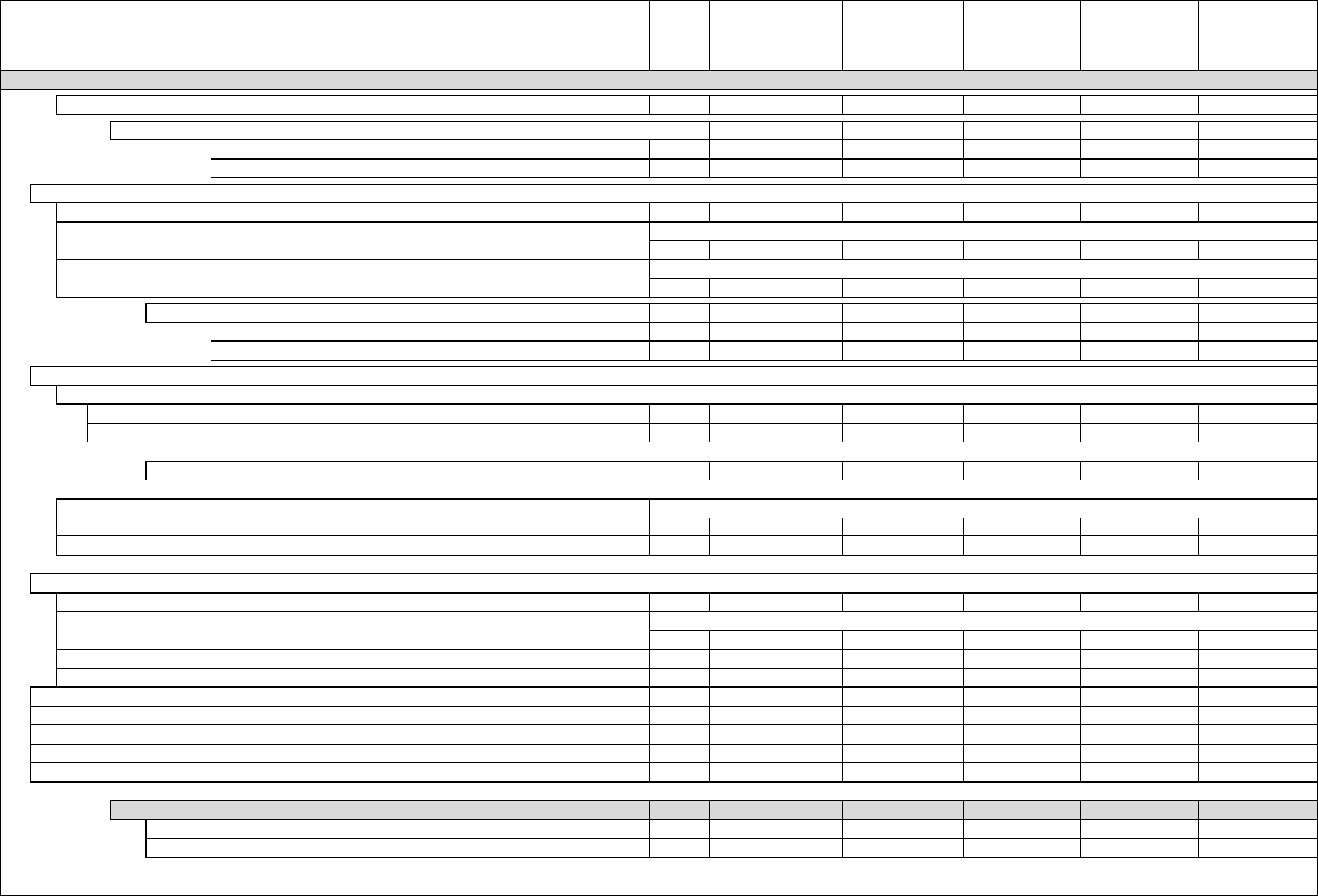
DEPARTMENT OF EDUCATION FISCAL YEAR 2025 PRESIDENT'S BUDGET
(in thousands of dollars)
CatCode
2023
Appropriation
2024
AnnualizedCR
2025President's
Budget
FY2025Request
ComparedtoFY
2024AnnualizedCR
Amount
FY2025Request
ComparedtoFY
2024Annualized
CRPercent
HigherEducation(continued)
(p) Minorityscienceandengineeringimprovement(HEAIII‐E‐1) D 16,370 16,370 16,370 0 0.00%
Subtotal,Aidforinstitutionaldevelopment 929,586 929,586 1,010,100 80,514 8.66%
Discretionary D 783,421 783,421 855,100 71,679 9.15%
Mandatory M 146,165 146,165 155,000 8,835 6.04%
2. AidforHispanic‐servinginstitutions:
(a) DevelopingHispanic‐servinginstitutions(HEAV‐A) D 227,751 227,751 246,547 18,796 8.25%
(b) MandatorydevelopingHSISTEMandarti
culationprograms
(HEAIII‐F,section371(b)(2)(B)) M 94,300 94,300 100,000 5,700 6.04%
(c) PromotingpostbaccalaureateopportunitiesforHispanicAmericans
(HEAV,section512) D 27,314 27,314 29,769 2,455 8.99%
Subtotal 349,365 349,365 376,316 26,951 7.71%
Discretionary 255,065 255,065 276,316 21,251 8.33%
Mandatory 94,300 94,300 100,000 5,700 6.04%
3. Otheraidforinstitutions:
(a) Internationaleducationandforeig
nlanguagestudies:
(1) Domesticprograms(HEAVI‐AandB) D 75,353 75,353 73,282 (2,071) ‐2.75%
(2) Overseasprograms(MECEAsection102(b)(6)) D 10,311 10,311 8,249 (2,062) ‐20.00%
Subtotal 85,664 85,664 81,531 (4,133) ‐4.82%
(b) Modeltransitionprogramsforstudentswithintellectualdisabilitiesinto
highereducation(HEAVII‐D‐2) D 13,800 13,800 13,800 0 0.00%
(c) Triballycontrolledpostsecondarycareerandtechnicalin
stitutions(CTEAsection117) D 11,953 11,953 11,953 0 0.00%
4. Assistanceforstudents:
(a) FederalTRIOprograms(HEAIV‐A‐2,Chapter1) D
1,191,000 1,191,000 1,211,000 20,000 1.68%
(b) Gainingearlyawarenessandreadinessforundergraduateprograms
(GEARUP)(HEAIV‐A‐2,Chapter2) D 388,000 388,000 398,000 10,000 2.58%
(c) Graduateassistanceinareasofnationalneed(HEAVII‐A‐2)
D 23,547 23,547 23,547 0 0.00%
(d) Childcareaccessmeansparentsinschool(HEAIV‐A‐7) D 75,000 75,000 80,000 5,000 6.67%
5. Fundfortheimprovementofpostsecondaryeducation(FIPSE)(HEAVII‐B) D 184,000 184,000 262,000 78,000 42.39%
6. Teacherqualitypartnership(HEAII‐A) D 70,000 70,000 95,000 25,000 35.71%
7. HawkinsCentersofE
xcellence(HEAII‐B‐2) D 15,000 15,000 30,000 15,000 100.00%
8.
GraduateFellowshipstoPrepareFacultyinHigh‐needAreasatCollegesofEducation
D0 0 5,000 5,000 ‐‐‐
9.
CommunityProjectFunding
D 429,587 429,587 0 (429,587) ‐100.00%
Total 3,766,502 3,766,502 3,598,247 (168,255) ‐4.47%
Discretionary D 3,526,037 3,526,037 3,343,247 (182,790) ‐5.18%
Mandatory
1
M 240,465 240,465 255,000 14,535 6.04%
1
FY2023andFY2024dataarepost‐sequestration.FY2025dataarepre‐sequestration.
82

DEPARTMENT OF EDUCATION FISCAL YEAR 2025 PRESIDENT'S BUDGET
(in thousands of dollars)
CatCode
2023
Appropriation
2024
AnnualizedCR
2025President's
Budget
FY2025Request
ComparedtoFY
2024AnnualizedCR
Amount
FY2025Request
ComparedtoFY
2024Annualized
CRPercent
HowardUniversity
1. Generalsupport(20U.S.C.121etseq.) D 226,693 226,693 226,693 0 0.00%
2. HowardUniversityHospital(20U.S.C.128) D 127,325 127,325 70,325 (57,000) ‐44.77%
Total D 354,018 354,018 297,018 (57,000) ‐16.10%
CollegeHousingandAcademicFacilitiesLoansProgramAccount(HEAsection121)
1. Federaladministration(FCRAsection505(e)) D 298 298 328 30 10.07%
2. Reestimateofexistingloansubsidies M 2,562 234 0 (234) ‐100.00%
Total 2,860 532 328 (204) ‐38.35%
Discretionary D 298 298 328 30 10.07%
Mandatory M 2,562 234 0 (234) ‐100.00%
CollegeHousingandAcademicFacilitiesLoansLiquidatingAccount(HEAsecti
on121)
M (3,015) (1,000) (3,015) (2,015) ‐201.50%
HistoricallyBlackCollegeandUniversityCapitalFinancingProgramAccount(HEAIII‐D)
1. Federaladministration(FCRAsection505(e)) D 528 528 581 53 10.04%
2. Loansubsidies D 20,150 20,150 20,150 0 0.00%
3. Reestimateofexistingloansubsidies M 62,421 27,551 0 (27,551) ‐100.00%
Total 83,099 48,229 20,731 (27,498) ‐57.02%
Discretionary D 20,678 20,678 20,731 53 0.26%
Mandatory M 62,421 27,551 0 (27,551) ‐100.00%
HigherEducationFacilitiesLoansLiquidatingAccount(HEAsection121)
M (585) 0 0 0 ‐‐‐
CollegeHousingLoansLiquidatingAccount(HEAsection121)
M (1,760) (5,000) (2,500) 2,500 50.00%
83
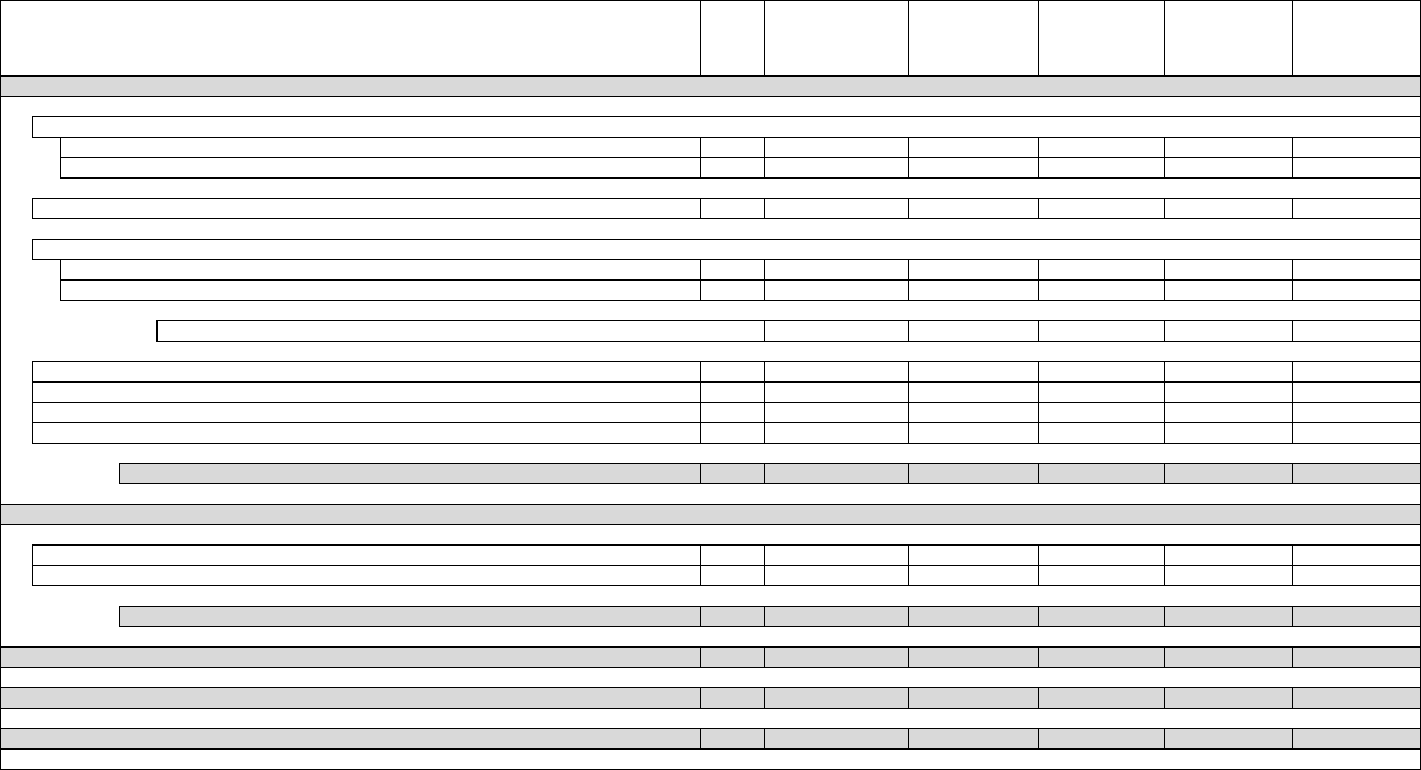
DEPARTMENT OF EDUCATION FISCAL YEAR 2025 PRESIDENT'S BUDGET
(in thousands of dollars)
CatCode
2023
Appropriation
2024
AnnualizedCR
2025President's
Budget
FY2025Request
ComparedtoFY
2024AnnualizedCR
Amount
FY2025Request
ComparedtoFY
2024Annualized
CRPercent
InstituteofEducationSciences
1. Researchandstatistics:
(a) Research,development,anddissemination(ESRAI‐A,BandD,exceptsection174) D 245,000 245,000 245,000 0 0.00%
(b) Statistics(ESRAI‐C) D 121,500 121,500 121,500 0 0.00%
2. Regionaleducationallaboratori es(ESRAsection174) D 58,733 58,733 58,733 0 0.00%
3. Assessment(NAEPAA):
(a) Nationalassessment(section303) D 185,000 185,000 185,000 0 0.00%
(b) NationalAssessmentG
overningBoard(section302) D 7,799 7,799 8,299 500 6.41%
Subtotal 192,799 192,799 193,299 500 0.26%
4. Researchinspecialeducation(ESRA,PartE) D 64,255 64,255 64,255 0 0.00%
5. Statewidelongitudinaldatasystems(ETAAsection208) D 38,500 38,500 38,500 0 0.00%
6. Specialeducationstudiesandevaluations(IDEA,section664) D 13,318 13,318 13,318 0 0.00%
7. ProgramAdministration D 73,500 73,500 80,850 7,350 10.00%
To
tal D 807,605 807,605 815,455 7,850 0.97%
ProgramAdministration(DEOA)
1. Salariesandexpenses D 419,907 419,907 476,846 56,939 13.56%
2. BuildingModernization D 7,000 7,000 0 (7,000) ‐100.00%
Total 426,907 426,907 476,846 49,939 11.70%
OfficeforCivilRights(DEOA,section203)
D 140,000 140,000 162,359 22,359 15.97%
OfficeofInspectorGeneral(DEOA,section211)
D 67,500 67,500 77,497 9,997 14.81%
Contributions(DEO
A,section421)
M0 0 0 0 ‐‐‐
84
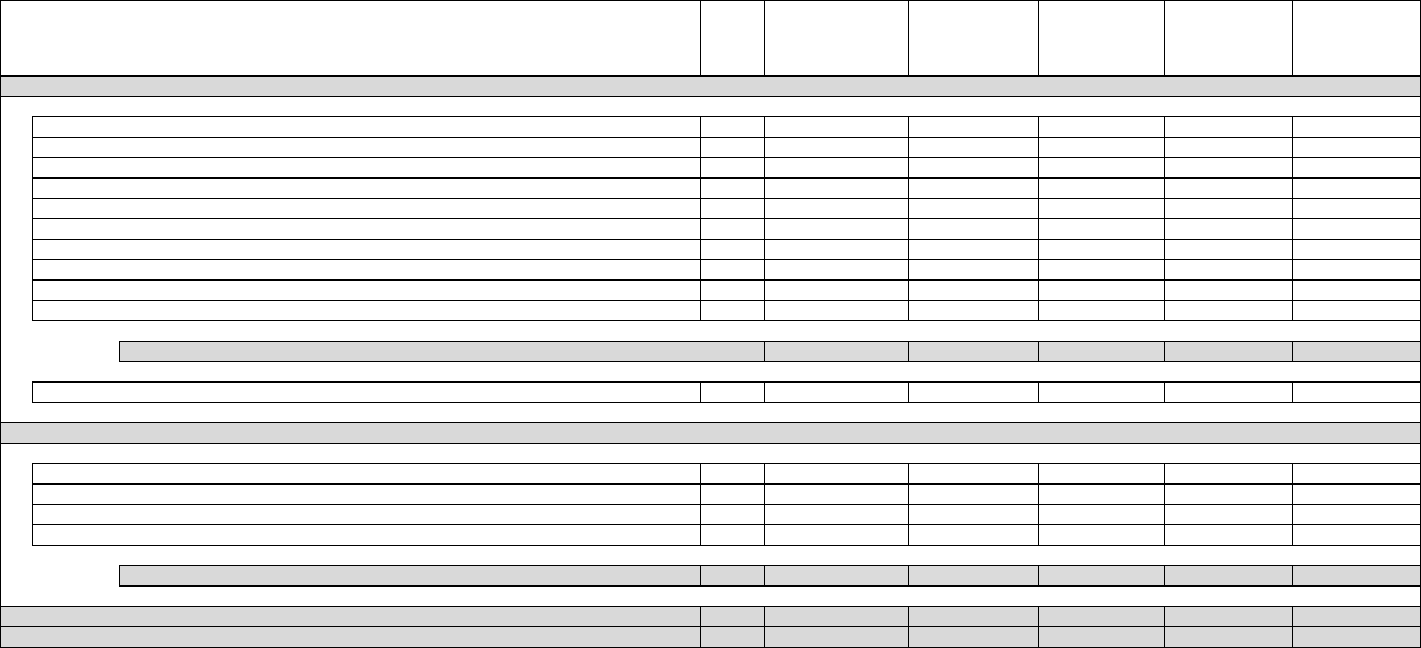
DEPARTMENT OF EDUCATION FISCAL YEAR 2025 PRESIDENT'S BUDGET
(in thousands of dollars)
CatCode
2023
Appropriation
2024
AnnualizedCR
2025President's
Budget
FY2025Request
ComparedtoFY
2024AnnualizedCR
Amount
FY2025Request
ComparedtoFY
2024Annualized
CRPercent
GeneralFundReceipts
1. Perkinsloanrepayments M (580,193) (454,174) (285,130) 169,044 37.22%
2. FDSLdownwardreestimateofloansubsidies M (10,049,156) (1,682,552) 0 1,682,552 100.00%
3. FFELdownwardreestimateofloansubsidies M (899,176) (2,339,384) 0 2,339,384 100.00%
4. FDSLdownwardmodification/negativeloansubsidies M (2,109,824) (885,105) (546,530) 338,575 38.25%
5. HBCUcapitalfinancingdownwardreestimateofloansubsidies M (38,713) (41,956) 0 41,956 100.00%
6. FFELdownwardmodification/negativeloansubsidies M0000 ‐‐‐
7. HEALdownwardreestimateofloansubsidies M 0 (13,071) 0 13,071 100.00%
8.
TEACHdownwardreestimateofloansubsidies M (11,325) (15,483) 0 15,483 100.00%
9. TEACHdownwardmodification/negativeloansubsidies M (51,645) 0 0 0 ‐‐‐
10. CHAFLdownwardreestimateofloansubsidies M 0 0 0 0 ‐‐‐
Total (13,740,032) (5,431,725) (831,660) 4,600,065 84.69%
1. StudentFinancialAssistancedebtcollection M 2,755 10,000 10,000 0 0.00%
ChangeinMandatoryProgram(CHIMP)andRescissions
1. RehabilitationServices:VocationalRehabilitationStategrantsCHIMP D 0 0 (128,364) (128,364) ‐‐‐
2. StudentFinancialAssistance:FederalPellGrantsRescission D (360,000) (360,000) 0 360,000 100.00%
3.
InstituteofEducationServices:RegionalEducationalLaboratoriesRescission D 0 0 (15,000) (15,000) ‐‐‐
4. InstituteofEducationServices:StateLongitudinalDataSystemsRescission D 0 0 (10,000) (10,000) ‐‐‐
Total D (360,000) (360,000) (153,364) 206,636 57.40%
DISCRETIONARYAPPROPRIATIONWITHRESCISSIONSANDCHIMP
D 79,233,262 79,233,262 82,363,612 3,130,350 3.95%
DISCRETIONARYAPPROPRIATIONWITHOUTRESCISSIONSANDCHIMP
D 79,593,262 79,593,262 82,516,976 2,923,714 3.67%
85
The Department of Education’s mission is t
o promote student achievement
and preparation for global competitiveness by
fostering educational excellence and ensuring equal access.
www.ed.gov
